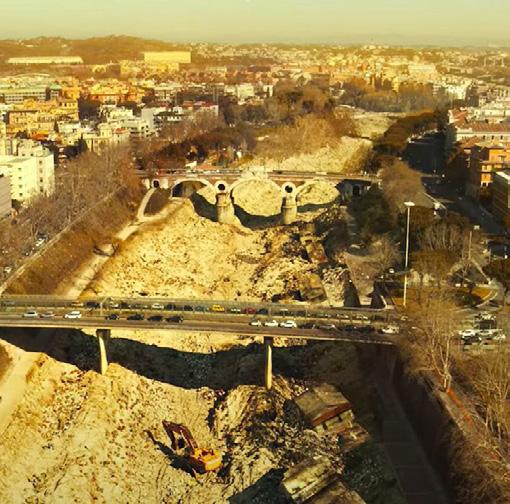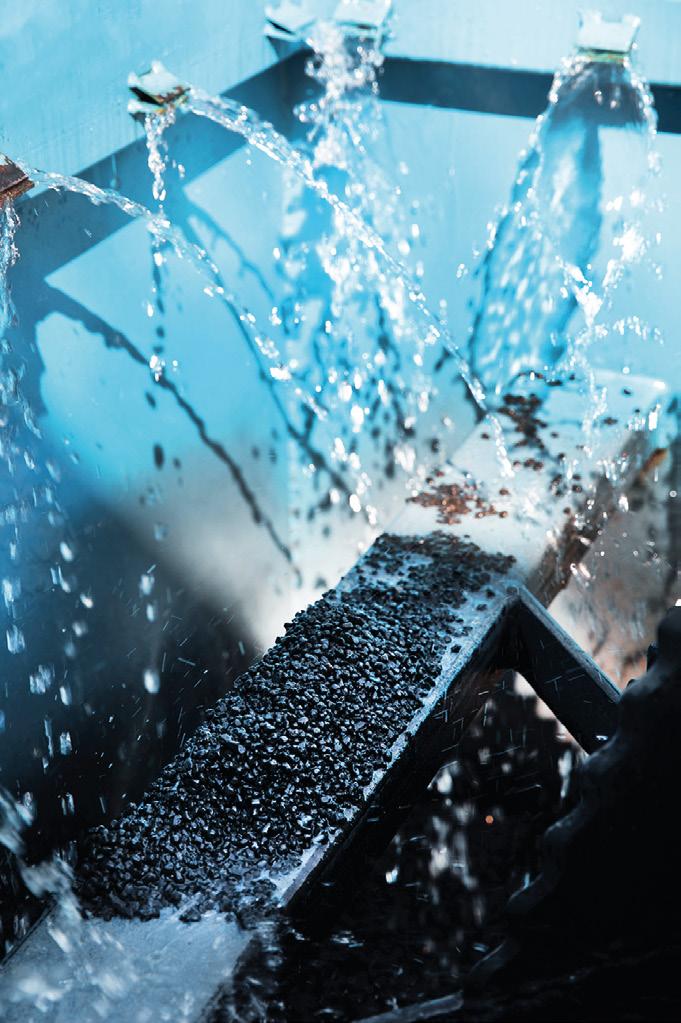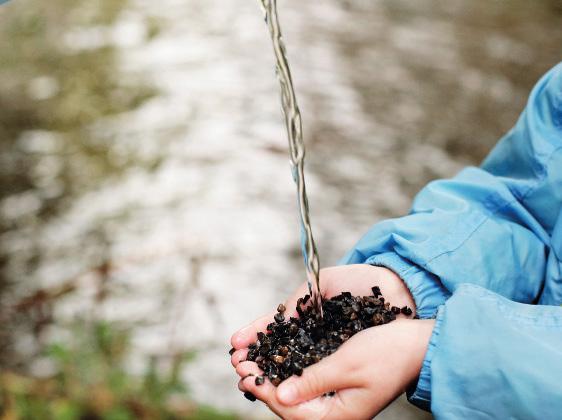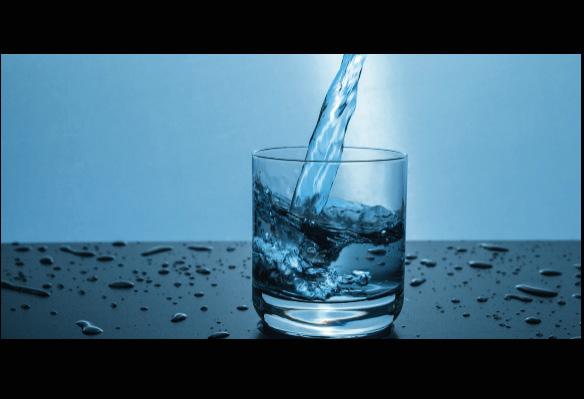




The worldwide water sector is at a critical point where delivering the transition needed to protect this essential resource and guarantee universal access has become imperative. Aware of this mammoth task, Saur is undergoing a metamorphosis since it announced in 2022 its ambition to become the champion of the water transition by 2030. In this transformational process, internationalization is a fundamental pillar that will impulse the France-based firm’s business model and strategy worldwide. Nader Antar, President of the company’s International Division, is leading this area since 2022 with an ambitious goal of contributing almost 50% of Saur’s revenue by 2025. The protagonist of SWMB17, Antar explains in an exclusive interview how Saur is becoming a future-ready water company that will support all its stakeholders to achieve their own water transition.
The wastewater treatment sector is also undergoing a crucial transition in which wastewater treatment plants are becom-
PUBLISHER
iAgua Conocimiento,
ing facilities for resources and energy production. In tackling climate change, there is also growing scrutiny of the role of sewage treatment plants as important sources of greenhouse gas (GHG) emissions and the water industry is faced with the complex task of reducing these emissions. In this issue, SWMB17, Smart Water Magazine spoke with many experts in this field to determine the latest trends, technologies and practices taking place in wastewater treatment plants around the world, from leading specialists in Denmark, like Morten Rebsdorf at Aarhus Vand, to the United Kingdom with Stephen Riches from Anglian Water, and Vanessa Núñez-López at the Department of Energy of the United States.
The traditional concept of water and wastewater treatment plants is now be-
EDITORIAL STAFF
Laura Fernández Zarza
Paula Sánchez Almendros
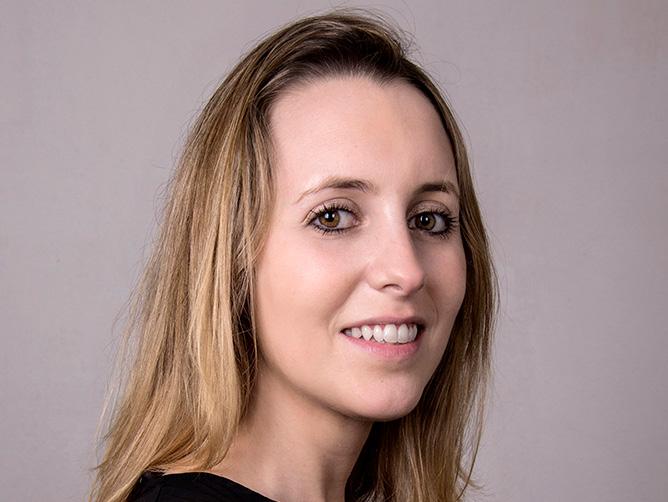
Olivia Tempest Prados
Cristina Novo Pérez
coming obsolete and a real desire for change can be felt throughout the sector. Wastewater treatment plants need to move towards a circular economy by focusing on the reuse of resources and energy. This would allow to undertake water security risks such as environmental pollution, growing urbanization, and climate change challenges including prolonged drought and more intense precipitation. As Saur pointed out when it revealed its ambition to become the champion of the water transition by 2030 last year, taking action today is mandatory if the industry is to succeed in protecting and conserving water resources.
MANAGEMENT
Alejandro Maceira Rozados
David Escobar Gutiérrez
EDITOR
Alejandro Maceira Rozados
ADVERTISING
Javier de los Reyes
ART AND GRAPHIC DESIGN
Pablo González-Cebrián
Esther Martín Muñoz
NUMBER 17 - APR/MAY 2023
INTERVIEW FEATURE BETTER FILTRATION PERFORMANCE
Pg. 22 Baptiste Rogeau, Sales Manager at Filtralite, discusses the advantages of the company’s filtration solutions in this interview.
INTERVIEW INTERVIEW

Pg. 78 Kirill Horoshenkov, Professor at the University of Sheffield, explains how miniature robots can tackle water loss through leakage.
Pg. 42 HRS discusses heat exchangers in wastewater systems, and some of the factors to take into account for process and energy efficiency.
Pg. 46 We ask Juan Bofill, Senior Water Engineer at the EIB, about different approaches to deal with microplastics and micropollutants.
Pg. 14 SWM interviews Nader Antar, President of Saur’s International Division, on the company’s plans to drive forward this key area of business.
Pg. 113 We hear from Al Cho, Chief Strategy and External Affairs Officer, Xylem, on his takeaways from the UN Water Conference held last March.
Pg. 82 The digitalisation of 100,000 smart water meters consolidates Spanish company Hidroconta in the development of remote metering projects.

Pg. 28 Morten Rebsdorf, Senior Project Manager at Danish water utility Aarhus Vand, shares his expertise on managing emissions from WWTPs.
FEATURE
A STATE-OF-THE-ART WWTP IN BAHRAIN

Pg. 56 Almar Water Solutions presents the Muharraq project, a unique facility with sanitation, treatment and reuse capacity under a PPP scheme.
INTERVIEW
WATER SECURITY AND WETLANDS
Pg. 92 We had the opportunity to speak with Dr Musonda Mumba, Secretary General of the Ramsar Convention, on wetlands and water security.
FEATURE
FOREVER CHEMICALS IN WATER
Pg. 64 A look at the evolving approaches to manage the risks from PFAS exposure in drinking water, a major concern for the water sector
OPINION
INNOVATION FOR SUSTAINABILITY
Pg. 27 Frank Janssens discusses initiatives that leverage the power of innovation to drive sustainability in the Middle East region.
FEATURE
FOCUSING ON SEWER NETWORKS
Pg. 72 Often overlooked assets, Envirosuite offers tools for water utilities to manage the environmental impact of sewer networks.
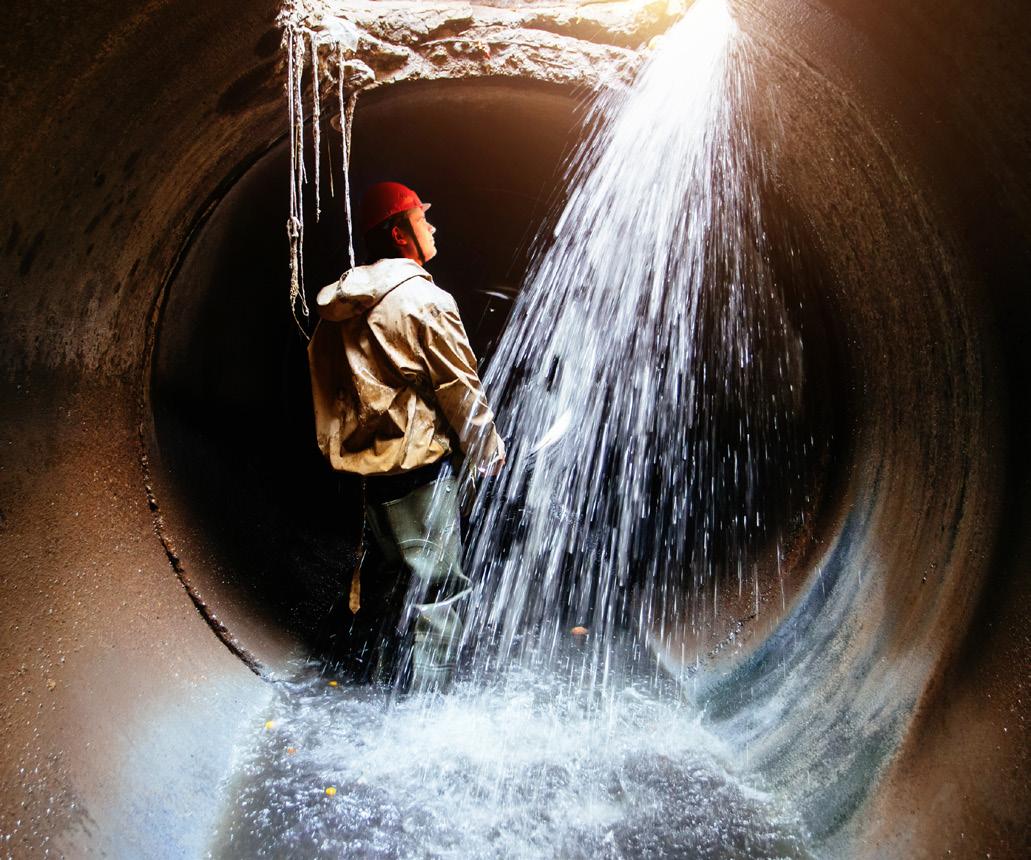
INTERVIEW
AFTER THE UN WATER CONFERENCE
Pg. 104 SWM speaks with Nathalie Olijslager-Jaarsma, Program Director of the UN 2023 Water Conference, on her expectations for the future.
OPINION
THE ROLE OF PRIVATE CAPITAL
Pg. 26 Alexander Loucopoulos argues private enterprises can work together with governments to be part of the solution to the water crisis.
INTERVIEW
WILL AI TRANSFORM WATER TREATMENT?
Pg. 60 The European DARROW project is developing artificial intelligence tools to reduce the energy cost of water treatment plants.
CONTENTS
NUMBER 17 - APR/MAY 2023
Pg. 74 Siemens, Yorkshire Water, and the University of Sheffield have joined forces to reduce wastewater network blockages and pollution.
INTERVIEW
THE OPPORTUNITIES IN PRODUCED WATER
Pg. 52 The U.S. Department of Energy is funding R&D projects focusing on the management of oil and gasproduced water so it can be reused.
PERSON OF THE MONTH
Pg. 12 Henk Ovink is the Special Envoy for International Water Affairs for Netherlands and a prominent figure at the UN Water Conference.
INTERVIEW
Pg. 98 In this interview, Amanda Loeffen, CEO of Human Right 2 Water, shares the organisation’s vision and approach to achieve SDG 6.
FEATURE
Pg. 50 Energy efficient SynRM motors by ABB are the key to cutting costs and reducing emissions at water and wastewater facilities.
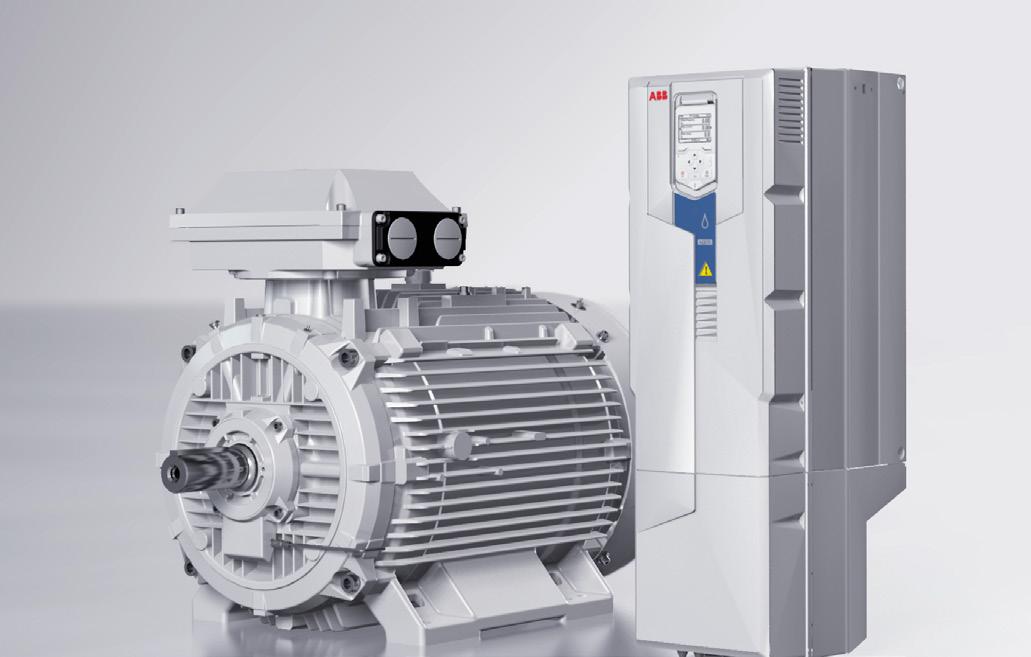
FEATURE INTERVIEW
Pg. 32 SWM speaks with Stephen Riches, leading the bioresources team at Anglian Water, about the present and future of the bioresources business.
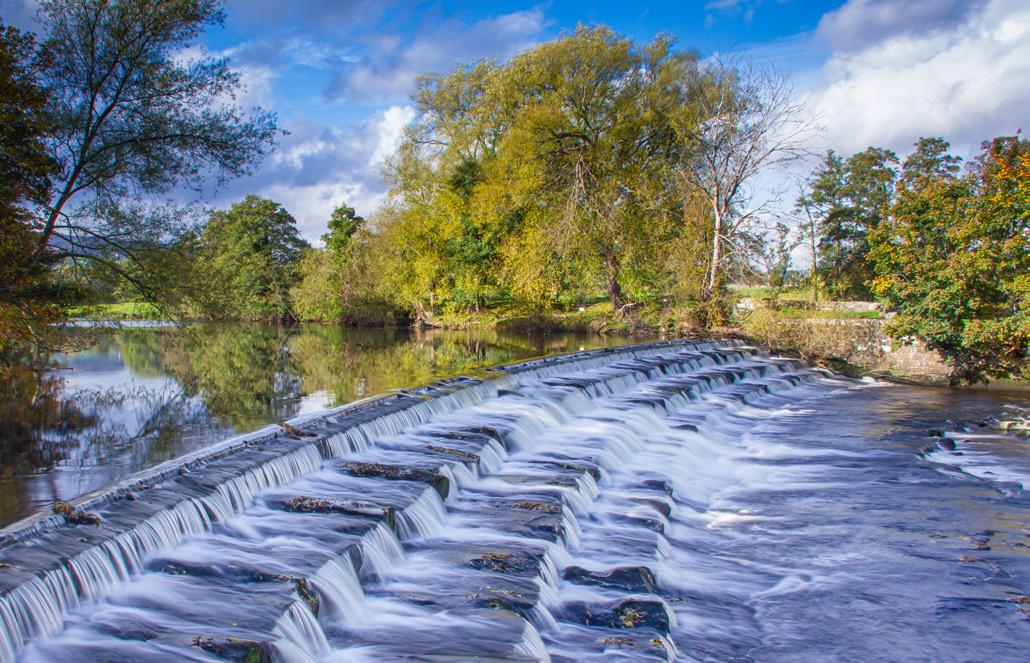
In this section we have compiled the most important appointments that have taken place recently, and entail taking up a position or role within influential entities (public, private or mixed) in the water sector.
Ecolab announced that Nick Alfano has been appointed as executive vice president and president of Ecolab’s Global Industrial Group.

Ecolab’s Global Industrial Group includes Nalco Water – Ecolab’s water and process management business – and Food & Beverage. With its more than 11,000 associates worldwide, the Industrial Group provides digitally enabled, integrated water management solutions, food safety and cleaning and sanitizing solutions.
“Ecolab’s Global Industrial Group continues to drive major growth and innovation for our customers”, said Christophe Beck, Ecolab chairman and chief executive officer. “Nick’s strong focus on delivering value for our customers and his deep knowledge of the food and beverage, manufacturing, transportation, and institutional businesses position him exceptionally well for this role.”
“I am excited for the opportunity to lead this amazing business and to collaborate with our exceptional teams that support our customers every day”, said Nick Alfano, executive vice president and president, Global Industrial. “I look forward to delivering continued, strong sales and earnings growth, while operating safely and sustainably, by helping our customers build high-performing operations while delivering on their sustainability goals.”
Alfano to lead Ecolab’s business group, helping customers deliver on their ambitious water, business performance and sustainability goals
Alfano previously led the Global Light Industries business of Nalco Water that provides digitally enabled, integrated water management solutions for customers in high tech, food & beverage and manufacturing industries.
Thames Water has appointed Heathrow Airport Chief Executive, John Holland-Kaye as a Non-Executive Director of its board. John will represent Thames Water’s shareholder, the Universities Superannuation Scheme (USS) on the board.

John joins the UK’s largest water company following more than 21 years’ experience in the aviation, construction and drinks manufacturing sectors, including 14 years at Heathrow Airport and seven years at Taylor Wimpey. He has been Chief Executive of Heathrow Airport, Europe’s latest airport, since 2014 having joined the airport as Commercial Director in 2009. During his tenure as CEO, he has transformed Heathrow into one of the world’s best consumer service organisations and led the company through two years of the Covid-19 pandemic and delivered its recovery.
David Waboso CBE, who joined the Thames Water board in February 2019 as an Independent Non-Executive Director, will be stepping down in May 2023 due to other commitments.
JOHN
John Holland-Kaye joins Thames Water following more than 21 years’ experience in the aviation and construction sectors
John Holland-Kaye said: “I look forward to joining Thames Water, at this critical time, to support the implementation of its turnaround plan and improve its performance and outcomes for customers, leakage, and river health. Of course, there will be challenges to overcome but I’m delighted to be joining an organisation which provides essential services to millions of people.”
John has been an Independent Non-Executive Director of Thames Tideway Tunnel since 2017 and is stepping down from this role at the end of March 2023.
Walters brings public sector leadership experience, including economic regulation of public utilities and a strong background in economics
Hodge has been with SJW since 2002 and led the company’s Texas subsidiary, The Texas Water Company (TWC), as president since 2007
Ofwat has appointed Chris Walters as Senior Director for the Price Review. He will take up post in June and will lead the PR24 process which sets the price, service, and incentive package for water companies from 2025-2030.
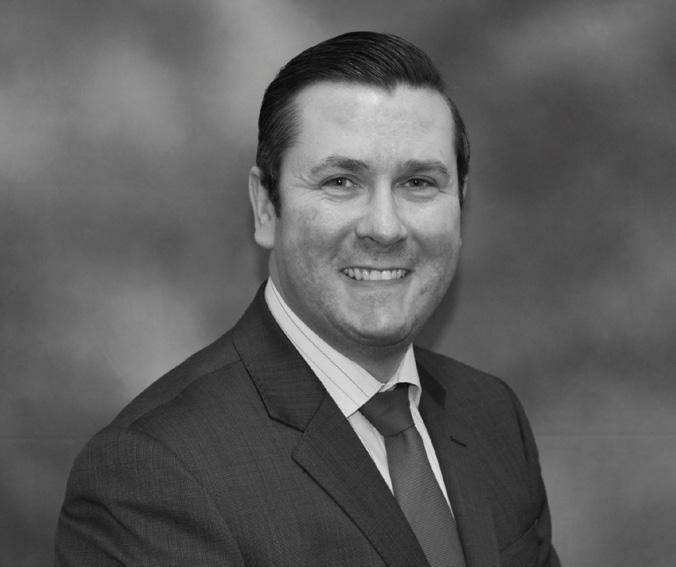

Chris Walters brings substantial public sector leadership experience, including economic regulation of public utilities and a strong background in economics. He joins Ofwat from NHS England, where he is Director of Pricing and Costing. Before joining the NHS in 2015, he held senior roles at the OFT and CMA, including as Chief Economist.
Ofwat Chief Executive David Black said: “I am delighted that Chris is joining Ofwat to take on this significant leadership role. His depth of experience and expertise mean that he is well placed to deliver a Price Review that will tackle some of the big challenges facing the water sector, while ensuring affordable, reliable and resilient services. We look forward to welcoming him to the team.”
Walters said: “I am really looking forward to joining the team at Ofwat and leading the upcoming price review process, to make a positive difference for customers and the environment.”
Chris Walters takes over from Aileen Armstrong who is leaving to take up a new role outside the water sector.
Chris is an economist with almost 30 years professional experience. Since 2015, he has been Director of Pricing and Costing for NHS England and before that he held senior roles at the UK’s competition watchdogs.
SJW Group announced that its board of directors has appointed Thomas A. Hodge as vice president of business development. Hodge has also been appointed president of Texas Water Operation Services, LLC. He has been with SJW since 2002 and has led the company’s rapidly growing Texas subsidiary, The Texas Water Company (TWC), as president since 2007.
Hodge will be responsible for business development. In this role, he will lead the company’s acquisition and growth initiatives, building on SJW’s strong record of acquisitions with over 60% customer growth and nearly doubling of utility plant in the past five years.
SJW will be launching a nationwide search for an individual to lead the regulated operations of TWC. The company serves more than 26,000 water connections and 900 wastewater connections between Austin and San Antonio, Texas, a region that includes three of the five fastest-growing counties in the United States. Texas Water Operation Services, LLC is a nonregulated subsidiary of SJW in Texas that was formed to provide water and wastewater-related services and contract operations.
Both Hodge and his successor as president of TWC will report to Bruce A. Hauk, chief operating officer of SJW. Hodge will continue to serve as president of TWC until a successor is appointed. He will be a resource for the future president of TWC to ensure a seamless transition.
Hodge has a B.S. in civil engineering from Carnegie-Mellon University and an M.S. in water resources engineering from Stanford University.
Mr Brown is one of only a handful of globally recognized senior executives to have led multiple successful billion dollar exits in the water space. He was the founder, Chairman and CEO of AquaVenture Holdings, which he led to a listing on the New York Stock Exchange (“NYSE”) in 2016 and subsequently sold to Culligan Water for US$1.2 billion in 2020 while he was serving as Chairman. Mr Brown was also CEO of Seven Seas Water, an AquaVenture Holdings business. He was previously CEO of NYSE-listed Ionics, Inc., which was acquired by GE Water for US$1.3 billion in 2005. Prior to Ionics, Mr Brown was CEO of Advent International, a global private equity firm.
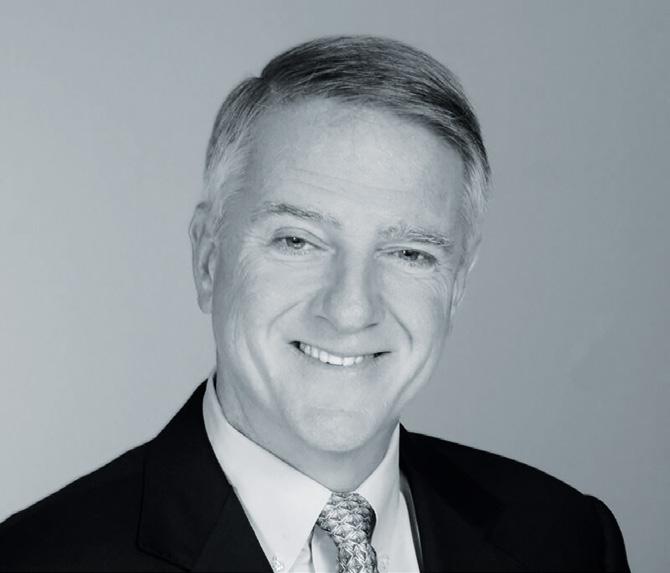
Reflecting on Mr Brown’s appointment, Richard Irving, Fluence’s outgoing Chairman said: “I and the Fluence Board are delighted to appoint Doug as our new Chairman. Doug’s wealth of experience driving water businesses to substantial success is a perfect complement to our outstanding management team led by Managing Director & CEO Tom Pokorsky. Doug has participated extensively in Board meetings and management discussions since his appointment as Strategic Advisor in May 2022. I look forward to continuing to serve as a Non-Executive Board member under Doug’s leadership.”
Brown said: “I am both delighted and honoured to be elected by the Directors to become the Chairman of the Board. Fluence has very strong, proven and proprietary technology which gives it a competitive advantage in many Wastewater Reuse applications.”
The Right Honourable Ruth Kelly has been appointed as the new Chair of Water UK. She replaces Anthony Ferrar who has concluded his three-year term that he has held since April 2020.
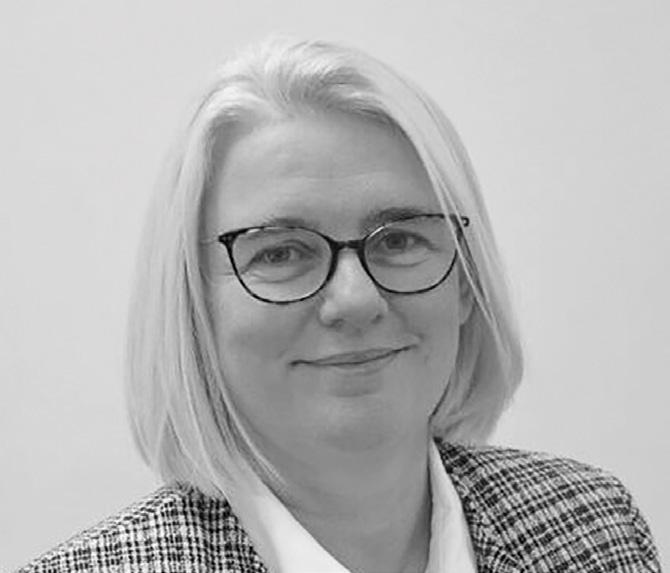
As a former Member of Parliament for Bolton West from 19972010, Kelly served in the UK Cabinet for four years, as Secretary of State for Education and Skills, Communities and Local Government, and Transport, under both Tony Blair and Gordon Brown.
Since stepping down as an MP, Kelly became the Global Head of Client Strategy at HSBC Global Asset Management and Pro-Vice Chancellor for Research and Enterprise at St Mary’s University, Twickenham.
Currently she is the Chair of Thames Freeport, a Director of Heathrow Airport, advises the Vatican on its financial portfolio and, last year, was appointed Senior Fellow at the Policy Exchange think tank.
Commenting on her appointment, The Rt Hon. Ruth Kelly, said: “This is a crucial time to be joining the water industry where there is, rightly, increasing scrutiny on its performance. I know how important water and the environment are to all of us, especially as we face the increasing pressures of climate change and population growth.”
“I look forward to working closely with company chief executives on the transformation that is required to meet the understandable and increasing public expectations for improved rivers and seas. Water UK has a crucial role to play and I am excited to lead it as it supports the water industry to rise to the challenges before it.”
Douglas Brown’s experience spans the US, Europe, South America, the Middle East, the Caribbean, Africa and Southeast Asia
The Right Honourable Ruth Kelly has been appointed as the new Chair of Water UK. She replaces Anthony Ferrar.
FLUENCE APPOINTS DOUGLAS BROWN AS A DIRECTOR AND CHAIRMAN OF THE BOARDIf you followed at all the UN 2023 Water Conference, you must have heard about Henk Ovink, the first Special Envoy for International Water Affairs for the Kingdom of the Netherlands and a prominent figure at the conference.

Mr Ovink was appointed by the Dutch Cabinet in 2015, and reports directly to several ministers, leading the international water government diplomacy through a broad network in the Netherlands and a strong international network across the full spectrum of sustainable development. He helps strengthen the water sector with all other development, climate and finance partners, across sectors such as energy, agriculture, and the creative industry. He advocates water awareness around the world, building institutional capacity and fostering collaboration across governments, multilateral organisations, the private sector and NGOs, to address the most pressing water challenges and leveraging water’s transformative capacity.
As the Dutch Ambassador for Water, Mr Ovink participates in international water fora, working on water diplomacy, and initiating transformative programs to boost resilience, equity and sustainability. He holds several international roles, including Sherpa and co-host to the UN 2023 Water Conference, the first UN Water Conference in 46 years, aimed at catalysing change in water awareness, action and implementation.
He also has an active role in academia: he has a research position at the University of Groningen and lectures at the London School of Economics and at the Harvard Graduate School of Design. In addition, Mr Ovink is Principal for Rebuild by Design, which started as a presidential award winning design competition in response to Hurricane Sandy’s impact on the U.S. that became a model to help communities and governments propel climate action and build resilience.
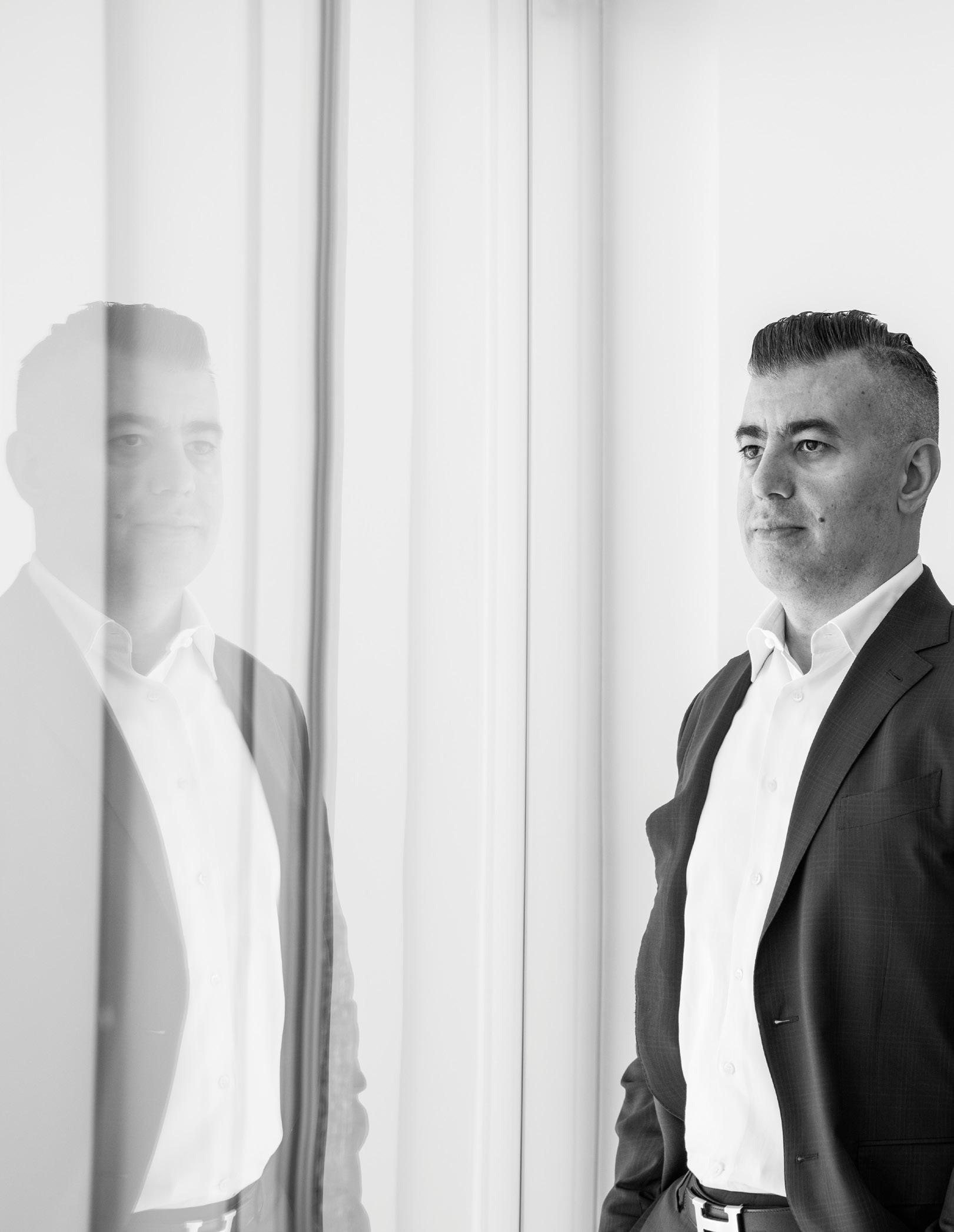
PRESIDENT OF SAUR INTERNATIONAL
Saur is a leading French-based innovator and service provider offering water utility services worldwide, currently operating in 20 countries and serving approximately 20 million people.
 Z Olivia TempesT G pablO GOnzález-Cebrián
Z Olivia TempesT G pablO GOnzález-Cebrián
“Saur is shifting from a water utility to a water technology company”
In 2022, Saur adopted a new brand identity setting itself the ambitious goal of becoming the champion of the water transition by 2030. To achieve this objective, the firm has placed internationalisation at the heart of its strategy, with the aim of it contributing 50 per cent of Saur’s revenue by 2025. To drive forward this key area of business, the company named Nader Antar President of Saur’s International Division last year. With over 20 years of global experience in strategy and business development, Antar has been tasked with the development and sustainable growth of all the firm’s international operations. We had the chance of speaking to him in Gestagua’s offices in Spain about his new role and the future of Saur.
What is your assessment of your first year as President of Saur International?
I joined the Saur Group almost a year ago, with the aim of capitalizing on everything that makes Saur a winning company (its employees, its purpose, its values, its expertise, its technologies, its geographical footprint, etc.) to both strengthen ourselves in our core markets, such as Spain and Portugal, and to expand into new key geographies.

Internationalisation is a strategic pillar of the Group, and by 2025, we will have to contribute almost 50% of Saur’s revenue. Over the past year, we have achieved our growth target and we now contribute about 30% of the Group’s revenue. This acceleration is not only the result of commercial successes thanks to our unique know-how in water management, but it is also the result of a profound transformation that we have initiated over the past year. A new organization has been put in place in all countries to better meet the expectations and needs of our customers. We have also opened our headquarters in Dubai (UAE) to better address water challenges in this region of the world, where there are numerous opportunities to innovate for the benefit of water resources, populations, and our customers.
In recent years, Saur has continued to grow around the world with both organic and external growth. What is your growth forecast for the coming years?
Our target is clear: contributing 50% of the Group’s revenue by 2025. Together with my teams
in all the countries where we operate, we have worked on an ambitious roadmap aligned with our purpose, to give back to water the value it deserves, and which places people, CSR, and digital at the heart of it. We will strengthen our commercial and operational excellence to serve our customers and populations through four growth levers - strengthening our positions in our core countries, leveraging synergies across the Group, growing in key geographies, and making strategic acquisitions.
"INTERNATIONALISATION IS A STRATEGIC PILLAR OF THE GROUP, AND BY 2025, WE WILL HAVE TO CONTRIBUTE ALMOST 50% OF SAUR’S REVENUE"
The circular economy is a major pillar in Saur’s plan to become the champion of the water transition by 2030. How does Saur stand out in this respect compared to its competitors?
We have a very unique purpose that sets us apart from our competitors - to give back to water the value it deserves - which we have incorporated into our statutes. This strategic choice also reflects our ambition to become the champion of the water transition by 2030, making responsible water man-
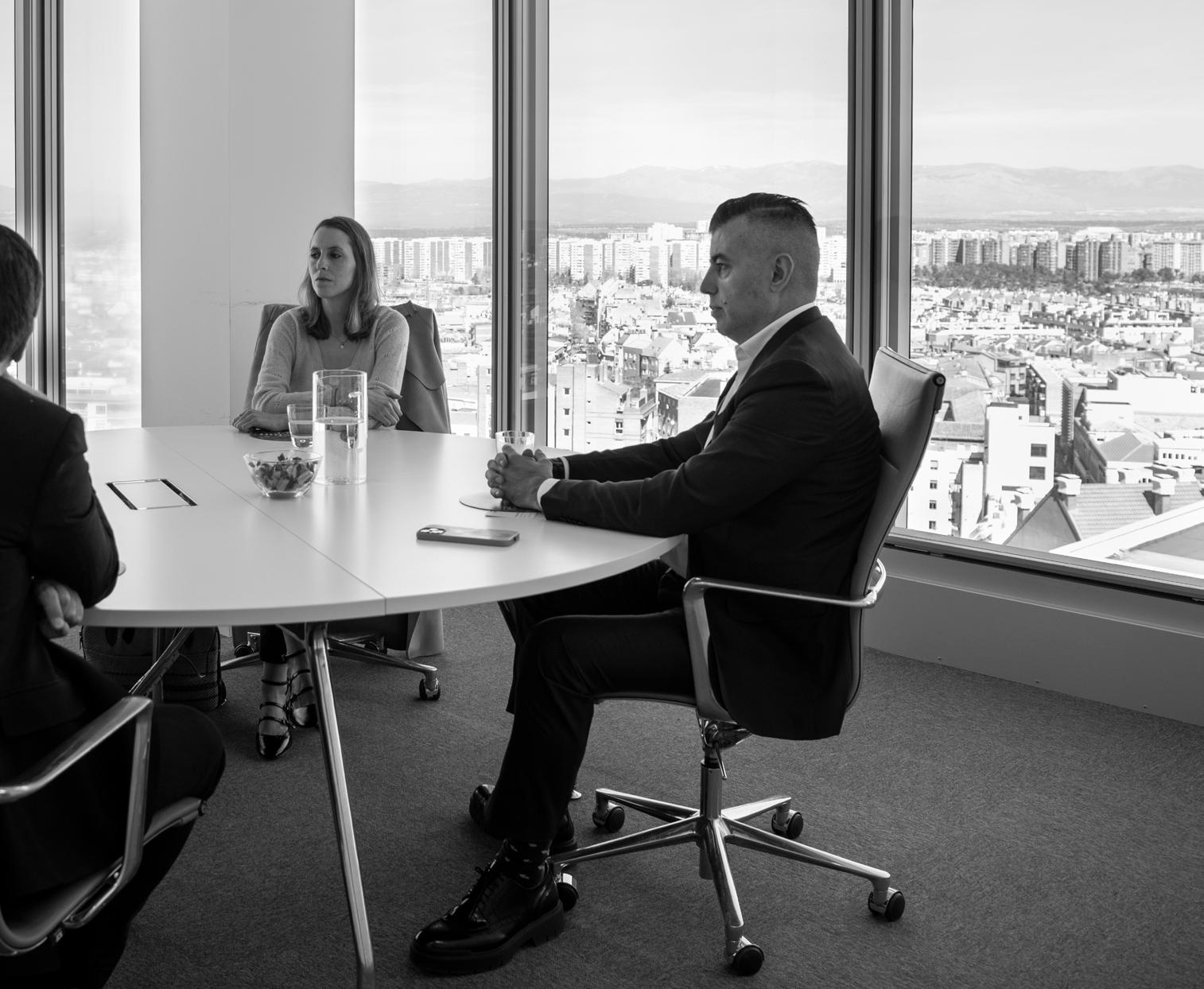
"WE HAVE OPENED OUR HEADQUARTERS IN DUBAI TO BETTER ADDRESS WATER CHALLENGES IN THIS REGION, AND WHERE THERE ARE NUMEROUS OPPORTUNITIES"
agement a reality in all the countries where we operate. We are convinced that beyond the competitive landscape, it is with the collective experiences, expertise, and collaboration of both public and private stakeholders that we will be able to address the challenges of climate change, which we all know are closely linked to the way we manage and protect water. This approach is unique, and we believe it is the best way to build alternative and sustainable solutions throughout the water cycle, relying
particularly on data and digital technologies. We have, in fact, been pioneers in this area with the establishment of water resource management centres that, hand-in-hand with local authorities, enable better resource management using predictive models based on artificial intelligence to fight drought, network leaks, and leaks in households.
Digitalisation is one of your passions. What emphasis does Saur place on digitalisation and how does the company prioritise and allocate resources for it?
I am convinced that traditional solutions are not enough to ensure the water transition in the world. Data is an inexhaustible resource whose analysis enables remote smart management of infrastructure facilities, in addition to physical maintenance and repair. That’s why Saur invested €200 million in digital over the past three years and is aiming to automate 80% of activities by 2025, thanks to Artificial Intelligence (AI). Today, we are able to monitor and take action on the water cycle and optimise means as well, by gathering, understanding, and exploiting the data, triggering the right actions. We have also launched the “Aquaverse by Saur”, a unique place based in Paris (France), which relies on a very rigorous methodology and aims to increase digital innovation to better address our customers’ water challenges. This true “do-tank” in the water sector allows for the accelerated development and proposal of innovative and responsible solutions in close collaboration with our customers and partners. And thanks to its unique methodology, we are also able to export the “Aquaverse by Saur” everywhere where it is needed.
Within the firm’s Mission Water 2030, what ESG initiatives is Saur promoting in its commitment to achieving a more sustainable world?
Our CSR roadmap is organized around 9 major engagements, and I would like to share three of them that seem key for me to build a more sustainable world for current and future generations. First, the commitment to “selling water savings, not only water volumes” which is essential and allows us to focus on the performance of our operations, expertise, and technologies. Next, the commitment to “enriching the science of experi-
ence with data” thanks to which we can accelerate technical and technological innovations for the benefit of water resources and consumers, preventing risks of drought, leaks, or even pollution. Lastly, the commitment to “being inclusive and diverse” which is a key commitment that I am also passionate about, helps contribute to building a company that reflects the society in which we operate. And last but not least, in 2021, directly linked to our strategic CSR shift, Saur issued €950 million in sustainability-linked bonds. Our financial performance is since then inextricably linked to our ability to make a real and measurable positive impact, and our investors will also judge us based on our environmental and societal performance. Concretely, by 2025, we aim to reduce our water withdrawal per consumer by 0.5% every year, to divide our carbon intensity by six, and reach the target of at least 40% of gender parity in executive positions roles. We are ambitious in all these areas, but we believe that it is a differentiating factor which allows us to better protect and preserve the most precious resource on the planet!
Saur is committed to an annual reduction in water consumption everywhere it operates, sometimes going against the widespread trend to increase water consumption to bill more. How are you going to achieve this goal and increase your turnover in this way?
At Saur, our objective is to promote a shared and sustainable use of water. We are convinced that we need to rethink the existing models. For instance, in France, we are going to launch an experiment on alternative pricing with two municipalities. This will help to challenge the status quo and pull the existing water models to more strategic and global stakes. Furthermore, today, it
"OUR AMBITION IS TO BECOME THE CHAMPION OF THE WATER TRANSITION BY 2030, MAKING RESPONSIBLE WATER MANAGEMENT A REALITY WHERE WE OPERATE"
"WE WILL STRENGTHEN OUR COMMERCIAL AND OPERATIONAL EXCELLENCE TO SERVE OUR CUSTOMERS AND POPULATIONS THROUGH FOUR GROWTH LEVERS"
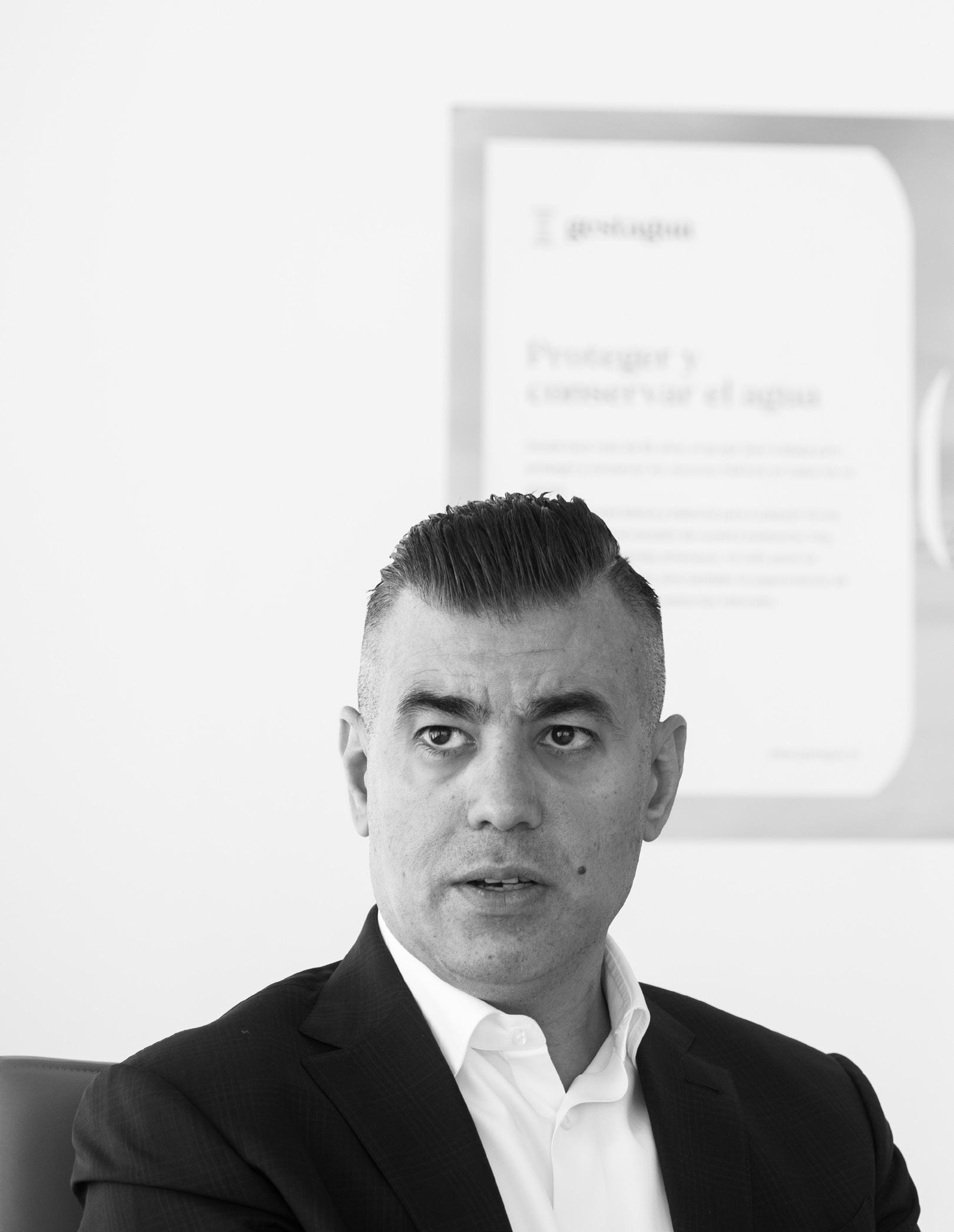
is no longer a question of selling volumes of water but rather water savings and performance of the operations but also of the infrastructure. We are shifting from a water utility to a water technology company. We do not only provide services but also water solutions based on data, AI and digital solutions to enable automation and contribute to closing the loop on the water cycle.
Saur currently operates on 5 continents, making it a global company; however, it also works on a local basis, in very specific territorial areas, both in large cities and small towns. How does that duality influence the way Saur works?

Two of our main assets are our agility and our swift decision-making process: we decide very quickly, and we are able to execute very quickly as well. These assets are key to operating in both small towns and large cities. Operating in small towns and large cities also allows us to offer tailor-made solutions to our customers and to provide each of them with our innovations according to their specific challenges: our customers are at the heart of our approach! And because we are locally implemented, and close to our customers, we have developed a strong culture of listening to our customers and close proximity across all business units in all countries; we are also in a better position than our competitors to anticipate and understand their needs and meet their objectives. Today, we are partners with more than 9,500 local municipalities and industrial customers in more than 100 countries.
Water sector PPPs projects are being given increasing importance in the water sector. What do you think of these types of partnerships?
Public-Private Partnerships (PPPs) in the water sector are globally becoming a common way to provide water services to populations. PPPs can help to
improve the efficiency, effectiveness, and sustainability of water service distribution, while ensuring the availability of water for agricultural, industrial, and private uses. It can also allow a better resource allocation and risk balance between private and public actors while providing the needed investments in critical infrastructure by implementing advanced technologies thanks to the how-know, the investments in R&D and innovation, and the existing hi-tech solutions of the private actors. But it is also a kind of partnership which requires a balanced regulatory environment and strong political will and support. Saur, as a private actor, has a wide range of modular offers to meet the specific needs of each of its customers. Our tailored approach is not opposed to PPPs, and my teams and I are always open to exploring new partnerships, whether PPPs or other types of partnerships, while remaining aligned with our DNA and values.
"BY 2025, WE AIM TO REDUCE OUR WATER WITHDRAWAL PER CONSUMER BY 0.5% EVERY YEAR AND TO DIVIDE OUR CARBON INTENSITY BY SIX"
"SAUR
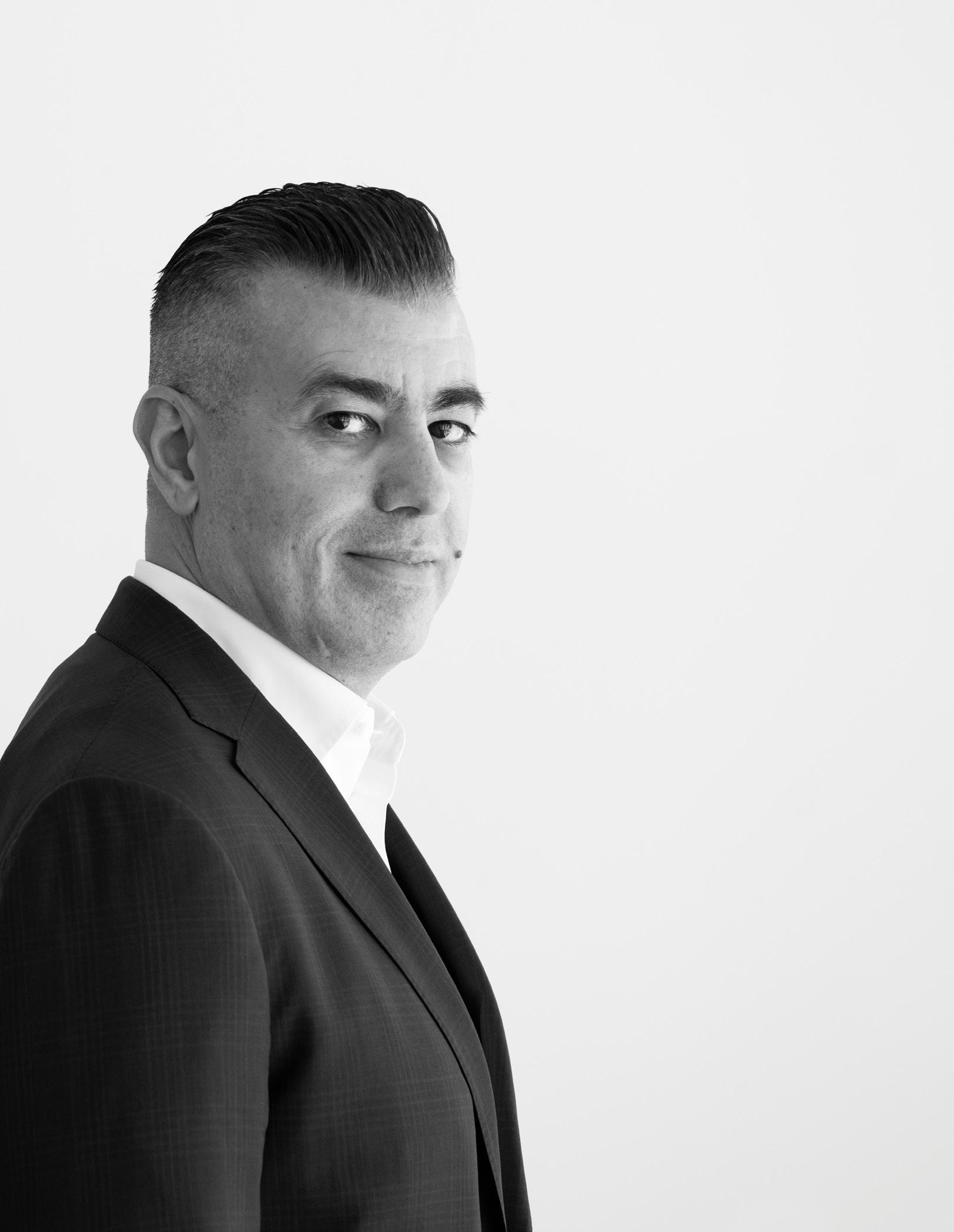
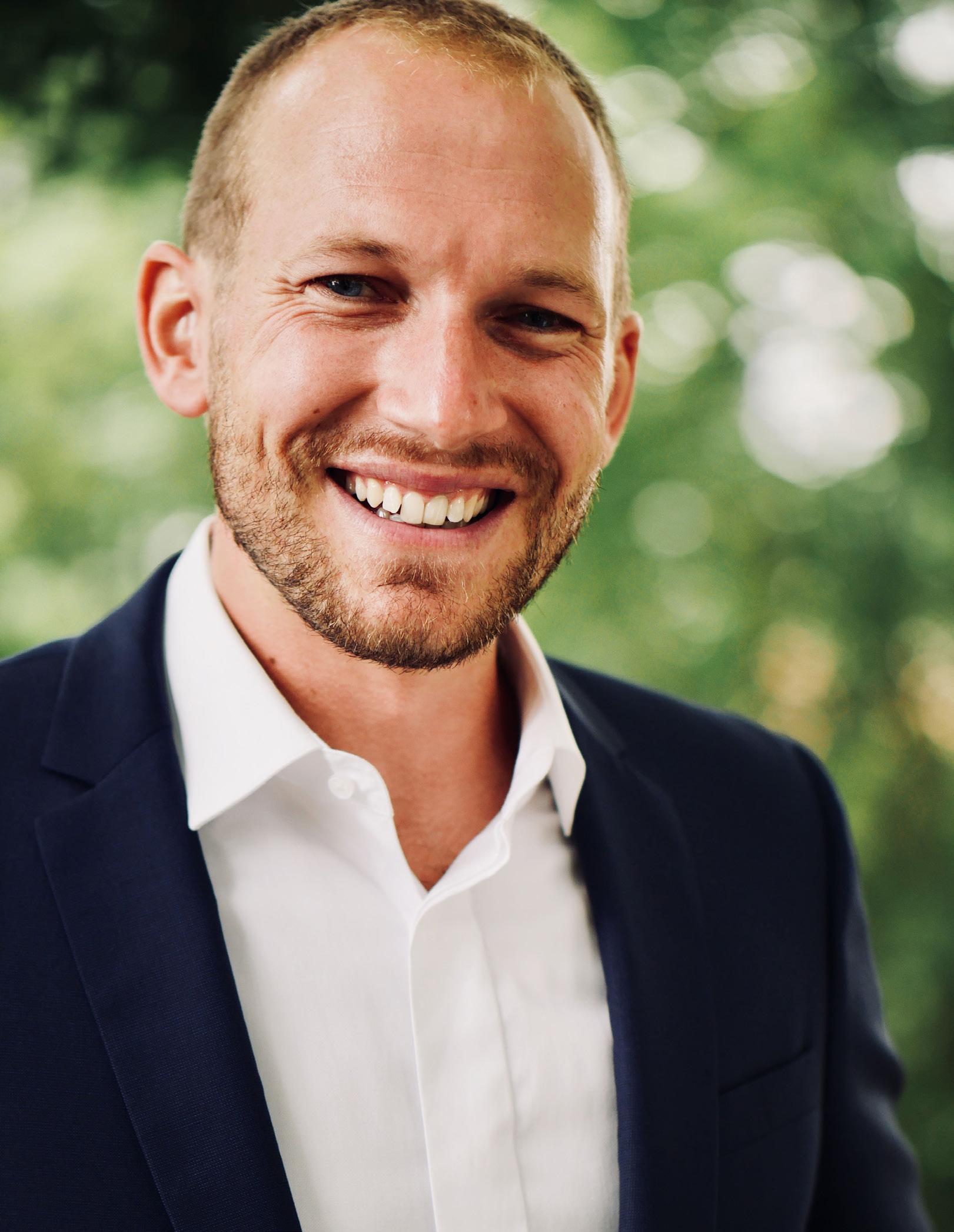
Water pollution is an increasing global concern impacted by numerous factors, including rapid urbanisation and agricultural intensification. In many parts of the world, water utilities are facing the daunting task of treating and purifying contaminated water, which requires significant resources and can be costly. However, Filtralite, with its unique porosity, offers to retain and absorb more contaminants, allowing for larger volumes of water to be filtered through the same volume as the contact area is increased. Baptiste Rogeau, Key Account Manager at Filtralite, sat with SWM to explain the advantages and technology behind the forward-looking filter media Filtralite offers.
Can you tell us briefly about your career path and your current role at Filtralite?
I joined Saint-Gobain back in 2015 to develop our presence within French-speaking countries. After two years, I became Sales Representative, then a key Account Manager and recently I accepted the role of Sales Manager.
What is Filtralite’s position within the Saint-Gobain Group?
A worldwide leader in light and sustainable construction, Saint-Gobain designs, manufactures and distributes materials and services for the construction and industrial markets.
Filtralite is one of many innovative brands within the Saint Gobain Group. We are dedicated to water filtration and are part of the LECA International organisation, which is famous for producing Lightweight Expanded Clay Aggregates.
Filtralite offers various solutions for water treatment, including Filtralite
Part of the Saint Gobain Group, Filtralite is the registered trademark for all expanded clay products used as filter media that are manufactured by Leca Norge AS in Norway. The company’s products not only increase water output volumes, but also decrease operation costs.
Pure, Filtralite Clean and Filtralite Nature. Could you tell us a bit more about the firm’s filter media?
Filtralite offers various solutions to answer a large range of needs in the field of water purification and filtration. Our most popular product family is Filtralite® Pure. It is used for drinking water purification, presenting different types of product characteristics (grain sizes and density) to adapt perfectly to every situation. We also have Filtralite® Clean, for wastewater. Our goal with this product is to decrease the pollution from the wastewater before it goes back to nature or is reused. Finally, Filtralite® Nature is a media specialised in the local treatment of wastewater with a focus on phosphorous. Additionally, we have a product named Filtralite® AIR used for bio filtration of air filters.
What types of pollutants do Filtralite’s solutions remove and how effectively?
Filtralite® Filter media is a lightweight filter media used for both physical and biological water filtration, just like the
commonly known sand filters. The filter setup and processes are similar but with improved advantages for the filter output. Filtralite offers the same treatment process as the most common solution, sand. In all the projects we have completed, Filtralite always performs better than sand in terms of water quality, while reaching much better filtration performance in terms of duration between backwash (between x2 and x4) and higher filtration speed. In addition, our media can be used to remove iron, manganese, ammonia, TOC, arsenic… You can find more detailed information on our website: www.filtralite.com
“Filtralite® Filter media is the perfect fit for the challenges of today”SALES MANAGER AT FILTRALITE.
"Filtralite is one of many innovative brands within the Saint Gobain Group, dedicated to water filtration and part of LECA International"
What benefits does Filtralite offer water utilities compared to other companies in the market?
Without going into details, the solution we are offering has higher porosity. It helps to capture more suspended solids in the water, as well as a higher bacterial activity per volume of filter media. Sand is characterized as being rounder and with less porosity, which results in reduced water cleaning; simply, it cannot catch as well all the residues pres-

ent in the water. Hence, our filter media will need less backwashing. This results in fewer filter stops and saves all the water and energy we need for this operation. Finally, we can clean more water in the same amount of time. It gives the possibility for our clients to deliver more water or to save operation costs by using fewer filters.
Where in the world is Filtralite active? Could you tell us a bit about the projects you are working on?
Filtralite is active on all continents, and we have completed more than 400 projects worldwide which offers a solid reference list. We are currently working on many desalination projects and are happy to collaborate with some major international expert companies in this domain. We are learning a lot from them, and we hope to bring improve-
ment to their pretreatment processes. Also, the lack of water all around the globe allows us to show our solutions to a larger public who are interested in water reuse. We are expecting 2023 to be a year where water issues are going to be even more central. For this reason, we are doing our best to inform the public about our solutions, since we are confident that we can help a big range of actors in the water market. We are fully aware that we provide solutions to a specific part of the filtration process. Nevertheless, we strongly believe that now every m3 of water saved will count, no matter if it is in Europe, Africa, Asia or North and South America…
Population growth, strict water treatment regulations and the growing demand for new water resources are some
"Our most popular product family is Filtralite® Pure, for drinking water purification, with different types of product characteristics"
of the factors driving the water and wastewater treatment market’s growth. How do you see the water and wastewater sector evolving in the next decade?
Filtralite® Filter media is the perfect fit for the challenges of today, as mentioned in your question. The water market is changing quickly, and it is difficult to know how fast it will grow in the future. After a dry summer in 2022 and now a dry winter in 2023, we see public awareness about water issues increasing. Governments need to act now to secure water access in the next decade for their population. We believe there is an important investment to plan to achieve it. But what is more important than securing safe access to water for everyone? Based on the local situation, there are different issues to address, such as the lack of water or the need for extra production capacities. For example, in major cities such as New Delhi, where urbanisation is increasing the water demand tremendously. We are also offering simple solutions to this kind of situation by increasing production capacity with existing plants.
A large portion of operating costs for drinking water systems can be for energy. How can Filtralite contribute to energy savings?
I probably answered this question, but it will be a pleasure to complete my answer. Our solution needs less backwash. This operation consists of rinsing the filter media with air and/or water. This task takes a lot of water and energy. We decrease drastically this operation, which means less water and energy used to pump and evacuate this water.
Also, our media allow a higher quantity of water filtered, so less energy is needed for the same period.
With this solution we have a 100% rate of satisfaction from all customers, no one ever said after using our product that they wanted to go back to their previous solution, and we have an average Return on Investment of less than 3 years, sometimes
even a few months, while the lifetime of the material is longer than 20 years.
How can Filtralite help reduce the carbon footprint of water treatment?
Filtralite can help to reduce the carbon footprint for both new and existing water treatment plants: The filter operation using Filtralite® Filter media needs less energy to process the same amount of water. For greenfield sites, we can design for a small overall footprint. For now, the main cost when we talk about water prices is the energy needed to produce and carry it. Especially, during this period of uncertainty in the energy market, we are proud to propose spending less energy with our media. In many countries, energy is produced with fossil fuels. Therefore, by using less energy, we reduce the carbon footprint of water treatment plants. Finally, we propose a solution that can operate with higher filtration speed which means designers have fewer filters to build and so less concrete, equipment, etc.
In 2021, Filtralite and Ingeobras launched a new line of business based on the creation of biological water treatment plants integrated in a container. Could you tell us a bit more about this partnership?
We have had a partnership with INGEOBRAS for a few years now. They are highly experienced in the water market, and we are having efficient exchanges with them. We developed with them a solution that integrates the most cost-effective, efficient, and sustainable technology.
This technology is a plug-and-play system, integrated into a container, that can be deployed everywhere in the world very quickly and it can be used to treat wastewater or drinking water.
Furthermore, it is 100% customisable and it does not require civil works to be used. We are proud of our collaboration with INGEOBRAS. We can realize this solution in 6 weeks, and we already sent it to Ecuador. We hope we will be able to continue this collaboration because innovation is in the DNA of both our companies.
"We can clean more water in the same amount of time, so our clients deliver more water or save operation costs by using fewer filters"
In all our projects, Filtralite performs better than sand in terms of water quality, while reaching much better filtration performance

As the world faces an escalating water crisis, it is time to acknowledge how private capital can play a critical role in implementing the necessary solutions. One of the biggest challenges fueling the water crisis is a lack of funding. In the United States, consistent underinvestment has led to a 400-billion-dollar funding gap for water infrastructure, which can only be closed through increased partnership and coordinated investment by the government and the private sector. Capital spending on water infrastructure at the local, state and federal levels falls short of what is needed to modernize our system. Public and private capital must work together to scale financial commitments dedicated to solving this crisis.
The Environmental Protection Agency recently proposed limits on per- and polyfluoroalkyl substances, or PFAS, in drinking water. This is a critical step to protect the quality of potable water, but one key question remains - who will pay for this? The proposal affects thousands of small, medium and large utilities, and based on preliminary estimates, the upgrades needed will cost billions. The government may fund some of this, but the private sector will need to fill the gap. What's more, this plan will likely take years to implement, yet the solutions are already being leveraged across the private sector. Central States Water Resources (CSWR), for example, has been testing for the presence of PFAS since its founding. This is just one example of why it's crucial for private enterprises to be a part of the solution, as private capital allows for swift action to address these issues now, not years down the line.
Additionally, water systems in the U.S. have not kept pace with the changing climate, as drought becomes more commonplace and concerns about water scarcity grow. 34 billion gallons of municipal wastewater are produced every day in the United States, but less than 10% of it is currently reused. Despite the growing need, there is a lack of will to invest in wastewater management facilities. There is also a psychological barrier at play.
Water recycling faces resistance in the U.S. because many people do not understand the cleaning and treatment process, which leads to feelings of disgust. Media coverage only helps to fuel this issue, thanks to headlines like “From the Toilet to the Tap.”
But the truth is we have the solutions to turn our wastewater into clean, safe drinking water. Membrane Bioreactors (MBRs), for example, are becoming increasingly popular among developers, engineers and utility districts due to their small footprint and extremely high-quality effluent. Integrated Water Services (IWS) has been installing MMBR systems across the Southwestern United States for over a decade, including in drought-ridden areas along the Colorado River Basin.
The water crisis is too big to tackle at once, which is why investments should focus on localized solutions that bring direct, measurable impacts to the communities affected. IWS played a critical role in helping a residential developer in Texas overcome the challenge of developing properties without sewer access. The development site was miles away from municipal treatment plants, which also lacked the capacity to take on additional waste. Within six weeks, IWS installed an interim system to treat 70,000 gallons per day. Just 11 months later, a permanent plant was online, treating 150,000 gallons per day to accommodate up to 1,000 homes. The community grew quickly, yet IWS was able to maintain wastewater operations and produce high-quality effluent without interruption during the construction of the permanent plant.
There is no easy fix to solve the water crisis. If we continue to do things as they’ve been done in the past, we will not see progress. Until we embrace water’s true value, we will fail to act with the urgency this crisis necessitates. Efforts to date are not enough — ongoing innovation, new ideas and dynamic partnerships are critical as we move toward a water-secure future. My hope is that private capital can work with governments to solve bigger problems. Let’s focus on solutions before it’s too late.
The water crisis is too big to tackle at once, which is why investments should focus on localized solutions that bring direct, measurable impacts
THE BUSINESS OF WATER: PRIVATE CAPITAL IS KEY TO SOLVING THE WATER CRISIS

Water is the foundation of any growing city – from industrial processes, and food cultivation to being a primary defence against the Covid-19 virus to ensure the health of citizens. Water scarcity can disrupt the lives of citizens and hinder the progress of cities. Water and wastewater management must play a key role in bringing a sustainable living vision to reality, and I write this from the Middle East, perhaps one of the more challenging regions for water scarcity.
Globally, it is reported that non-revenue water loss – water which is produced but lost before it reaches people – is estimated to be $40 billion per year. The World Bank estimates that MENA countries are at risk of facing the greatest economic loss from water shortages due to climate change, which by 2050 could account for 6 to 14 per cent of GDP.
Because the prosperity of growing cities and the environment are interlinked, I feel it is crucial that public and private sector stakeholders come together to find next-level solutions to these issues. In discussion with our government partners, there have been requests for hyper-precise smart meters in homes with serious investment in this area an option in order to place greater control measures in the hands of consumers; however, our environment is deteriorating due to accelerating climate change – which will consequently be a serious hindrance for the development of our cities, with industry playing a large role in the consumption of resources such as water.
sumption day by day and minute by minute, backed up with education on how to do more with less, this will surely help our chances.
As the Middle East region continues to diversify the economy away from fossil fuels, we are still closely tied to the oil and gas industry. Also, in this area, we are seeing better water management coming into place, specifically in Produced Water. Throughout the water management process in oil and gas, from collection to transportation and injection, the highest specification of electromagnetic flowmeters is able to reduce costs and wastage while providing peak levels of performance for operators. Our customers and partners tend to look for solutions that facilitate accurate, reliable measurement, provide instrument diagnostics, and reduce cost to overcome challenges that arise while managing produced water during oil and gas production. Reliable electromagnetic flowmeter units avoid moving parts entirely to avoid wear and measurement inaccuracy due to drifting.
Is the Middle East setting an example for the rest of the world by leveraging the power of innovation to drive sustainability across society?
Leaders in the industry need to take a step back and understand how they can add true value to water conservation whilst retaining the standard of living we have come to expect in the United Arab Emirates in particular. The best response, if pushed to simplify for greater impact, is to measure everything. If everyone –the shopkeeper, the master property developer, the solar power plant engineer, even the children at bath time – are all aware of their con -
On the road to COP28, all business leaders and industries are pulling in the same direction, most guided by the United Nations Sustainable Development Goals, or UNSDGs. Alongside this global framework, local initiatives such as Dubai 2040 Urban Masterplan and the Saudi Green Initiative aim for continued economic, environmental and societal growth whilst combatting climate change. Is the Middle East setting an example for the rest of the world by leveraging the power of innovation to drive sustainability across the whole of society?
I personally look forward to watching this vision come to reality powered by regional programs that peg growth to innovative technology solutions. The road to net zero gathers pace and more ground-breaking innovations are yet to unravel, striking the perfect balance to empower the people and environment of the planet to thrive in the coming 20 years.


Aarhus Vand is a Danish water utility company internationally known for its innovative technologies and services. It has a clear goal: to become the leading water utility in its country and also one of the leading water utilities in the world.
Aarhus Vand is tackling challenges that are common for many utilities worldwide: a growing population and the uncertainty of climate change. To address these issues, the company is building a new and bigger wastewater treatment plant - the world’s most resource-efficient WWTP – Aarhus ReWater. Aarhus Vand, in this way, is on its way to becoming energy self-sufficient and a net energy producer. Morten Rebsdorf, Senior Project Manager at Aarhus Vand, is tasked with planning and designing this avant-garde project and is an expert in
Greenhouse Gas (GHG) mitigation and protocol. We spoke to him about managing emissions at wastewater treatment plants and what is in store for the wastewater treatment industry.
Can you tell us briefly about your career path and your current work at Aarhus Vand?
I have a background as a chemical engineer from the Technical University of Denmark in 1998, and now I am employed as a senior project manager in Aarhus Vand for the last four years. Prior to my current position, I worked in a private consultancy for utilities and industry for approximately 13 years. Before that, I worked in the utility sector and in industrial R&D. The main focus in my current position is the strategic and operational focus of Greenhouse Gas (GHG) Mitigation, GHG Protocol, and how the Corpora-
tive Sustainability Reporting Directive (CSRD) will affect the GHG accounting for Aarhus Vand. Furthermore, my position covers specialist tasks related to the planning and design of Aarhus ReWater and various development projects on nitrous oxide, for example.
Climate change has increased the interest to determine the carbon footprints of wastewater treatment plants. How can wastewater treatment plants accurately estimate their GHG emissions? It’s a question with a lot of layers. A simplified answer could be like this: In my opinion, you should start with determining your system border, what is in, what is out – and for the chunks considered outside your border - why are they outside? Then determine the “large” chunks in the following order: 1. measure, 2. estimate and 3. guesstimate.
Nitrous oxide (N20) is a potent greenhouse gas, and its emission from wastewater treatment plants can vary substantially. How can wastewater treatment plants reduce this type of emission?
“Digitalisation and technological innovation play an immense role in helping WWTPs reduce their GHG emissions”
"The main focus is the strategic and operational focus of GHG mitigation, GHG Protocol, and how the CSRD will affect the GHG accounting"
Z Olivia Tempest
Yes – Nitrous oxide (N 20) is a major part of many WWTP’s scope first emissions. You need to have a sound knowledge of your “biological machine”, and which control handles/options you have, furthermore, you will have to invest in sensors and the attached maintenance and calibration.
Monitoring N 2O is possible with sensors placed in the water phase and offgas measurement. This implies skilled staff for maintenance and calibration, and skilled staff to interpret the results, implementing changes in the control of the plant, knowing that you have implemented a loop of measuring, calculating, assessing, improving controls and so forth.
At Aarhus Vand, we have been dealing with monitoring in both water and gas-phase for some years and recently spent many resources on a joint applied research project to get a sound knowledge base for understanding the formation, emission, control and possible mitigation of the N20 emission.
The Danish Government implemented a new law in 2020 to reduce the
national CO2 emissions by 70% in 2030. This climate plan includes goals to reduce N20 emissions from wastewater treatment plants by 50% and to implement a limit for emissions from WWTPs larger than 30,000 person equivalents (PE), no later than 2025. How is Aarhus Vand working to achieve this ambitious goal?
The described project under question 4, is one of our tasks directly related to the reduction goals. Close collaboration with
other utilities, universities and technology providers is crucial to gain and develop the required knowledge, but we have

Close collaboration with other utilities, universities and technology providers is crucial to gain and develop the required knowledge
"Monitoring N2O is possible with sensors placed in the water phase and off-gas measurement with skilled staff for maintenance and calibration"
not yet “cracked the nut”, though we have good indications of what to do and not to do. Data crunching in the following months will hopefully give us some directions and solutions, but of course also new puzzles.
We are also looking into where to implement new N20 sensors in our treatment plants.
Coverage of the biological tanks will enable the possibility of a central treatment for the vented air – and as a vision – developing a sort of molecular sieve, wherein the off-gas can be “filtered” into separate streams of pure CO2, N20 and O2 for reuse. Finally, that a holistic approach is taken in projects having a direct or indirect impact on GHG emissions.
What advice would you give countries that are looking to reduce GHG emissions from wastewater treatment plants?
Wow – it’s a big question, and my answer might reflect the context in Denmark, where the green transition of electricity production indeed has reduced our GHG footprint over the years. Energy self-sufficiency via biogas production is also a way to reduce the GHG footprint, if the purchased energy for treatment processes is fossil-based.
At the end of 2022, the European Council gave green light to the corporate sustainability reporting directive (CSRD). What does this mean for the EU’s water sector?
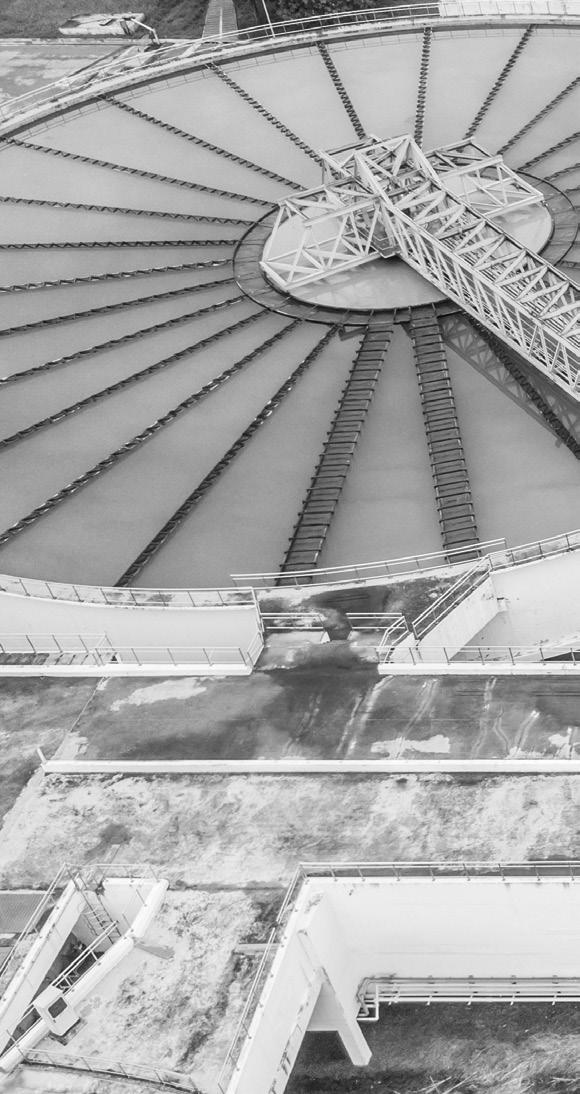

Energy self-sufficiency via biogas production can reduce the GHG footprint, if the purchased energy for treatment processes is fossil-based
"Aarhus Water is certified according to standards for environment and climate, working environment, drinking water safety and sustainability"
In my opinion, it will serve as a much-needed regulatory framework, which will enable standardisation of how to calculate, report and communicate sustainability.
How is Aarhus Vand working on its sustainability report?
Aarhus Water is certified according to relevant standards for Environment and Climate, Working Environment, Drinking water safety and sustainability in the form of UN Global Goals. Now we are putting quite some effort into understanding and planning how to operationalise the CSRD into our reporting.
What role do digitalisation and technological innovation play in helping wastewater treatment plants reduce their GHG emissions?

An immense role. For example, in sensor development, wire-less communication, numerical modelling, data-driven models, digital twins, and more. But there is one factor of paramount importance, at least in my opinion, and this is the ability of utilities to recruit and maintain well-educated staff, thus enabling a critical mass for understanding how to adapt and develop sustainable solutions to complex problems for the citizens.
How do you think wastewater treatment plants will look in 20 years?
I would imagine that we will see larger regional differences in how the treated wastewater is reused, depending on the demand for water. Plants will be covered in increasing numbers, and there might be developed plants based on physical and chemical treatment instead of biological treatment – minimizing CH 4 , CO 2 , and N 2 0-emission from the biological conversion, yet you have to consider such a profound shift in technology on a sound holistic assessment based on, for example, LCA.
investment planning. This includes the promotion of projects to our delivery alliances, developing long-term strategies, and preparing strategies, plans and investments for inclusion in our 5-yearly price reviews submitted to Ofwat, our economic regulator.
Bioresources captures the activities associated with the collection, transport, treatment and recycling of sewage sludge, a by-product of wastewater treatment. Anglian Water uses advanced anaerobic digestion to produce a biosolids product marketed under the brand Nutri-bio and biogas, used as a source of energy to reduce carbon emissions from operations.
The bioresources business – directly linked to the circular economy and net zero ambitions – faces both challenges and opportunities in the near term: population growth and finding solutions to meet additional treatment capacity, and the evolution of the sludge treatment market. We hear about the complexities of this part of water services operations from Stephen Riches, Portfolio Lead Bioresources - Asset Delivery Planning at Anglian Water Services, including the role of innovation and the company’s priorities.
Can you please tell us briefly about your career path and your current role at Anglian Water?
I joined Anglian Water in 1996 directly from the university as a Mechanical Engineer. Since 1998, the majority of my working career has been as a specialist in sludge treatment (bioresources), initially as a technical lead in the design, build and commissioning of sludge treatment processes. My experience includes lime stabilisation, thermal drying, gasification, and latterly advanced anaerobic digestion systems. During this time I was the technical lead for the development of Anglian Water’s patented industry-leading advanced anaerobic digestion system, heating, pasteurisation and hydrolysis (HpH). We have recently entered into a strategic partnership for this programme with Royal Dutch Haskoning (RDHV), which enables the technology (marketed by RDHV as Helea) to be delivered to other water companies across the world.
Since 2015 my role has taken a more strategic focus. As portfolio lead, I am responsible for supporting our water recycling business stream in many asset management functions, including
Much of my work is preparing our PR24 business plan for the Bioresources price control. This forms part of our company business plan submitted to Ofwat in October 2023 for the AMP8 investment period 2025-2030. This is a complex process involving many internal and external stakeholders. The core elements include:
Working with our economic and environmental regulators together with my counterparts at the other water and sewerage companies (WASCs) to develop an investment plan for AMP8 (2025-30).
Updating our long term 25-year Bioresources Strategy and associated adaptive pathways in line with the methodologies set out by our regulators. Our long-term strategy will be aligned with industry-wide work to produce a National Bioresources Strategy commissioned by Water UK. I have been working closely with industry leads, Water UK, and CIWEM throughout this process and look forward to the outputs being published in the coming months.
Developing plans and testing where markets can support us in meeting our strategic needs for bioresources. Examples of this include our recent release of PIN (Prior Information Notice) on Find a Tender for sludge treatment services, to deliver our additional capacity require-
“Anglian Water will continue to provide efficient high-quality services and products through our bioresources operations”
"Our long-term strategy will be aligned to industry wide work to produce a National Bioresources Strategy commissioned by Water UK"
Z Cristina Novo Pérez

ments. We also launched a second PIN for the transition of our biogas-fuelled CHP (Combined Heat & Power) engine fleet over to biomethane upgrading and grid injection which supports us in delivering our net zero 2030 plan.
To support the development of Bioresources Markets I have also been leading an Ofwat Innovation Fund Project called Unlocking Bioresources Markets. For this project, Anglian Water is partnering with a systems modelling specialist, Business Modelling Associates and four other water companies (Northumbrian Water, Yorkshire Water, Thames Water and Southern Water). The project aims to model the end-to-end sludge value chain from collection, transport, and treatment to end-product biosolids recycling across multiple water company networks. We are exploring market opportunities that occur when traditional company border constraints are removed and will support systemic
decision-making – for example, when companies are planning new capacity investments or transitioning to new technology. This will help identify optimum locations for new investments and possible market opportunities for third-party or joint investments with our neighbours.
How important has innovation been for water recycling and sludge treatment, and what are your expectations for the future?
Innovation is very important to the industry – sludge treatment innovation has played a big role throughout my career and is more important than ever as we look forward to challenges ahead.
Looking back, innovation has been key in the rapid development and deployment of advanced anaerobic digestion (AAD) technology which is now the predominant treatment technology used across the UK. I am particularly proud during this time to be given the opportunity to truly innovate: taking a concept design for our HpH (now marketed by RDHV as Helea), from a seed idea at an optioneering meeting through bench tests, pilot trials and full-scale implementation. The HpH process was installed at four of our ten sludge treatment centres and these have now been successfully operating
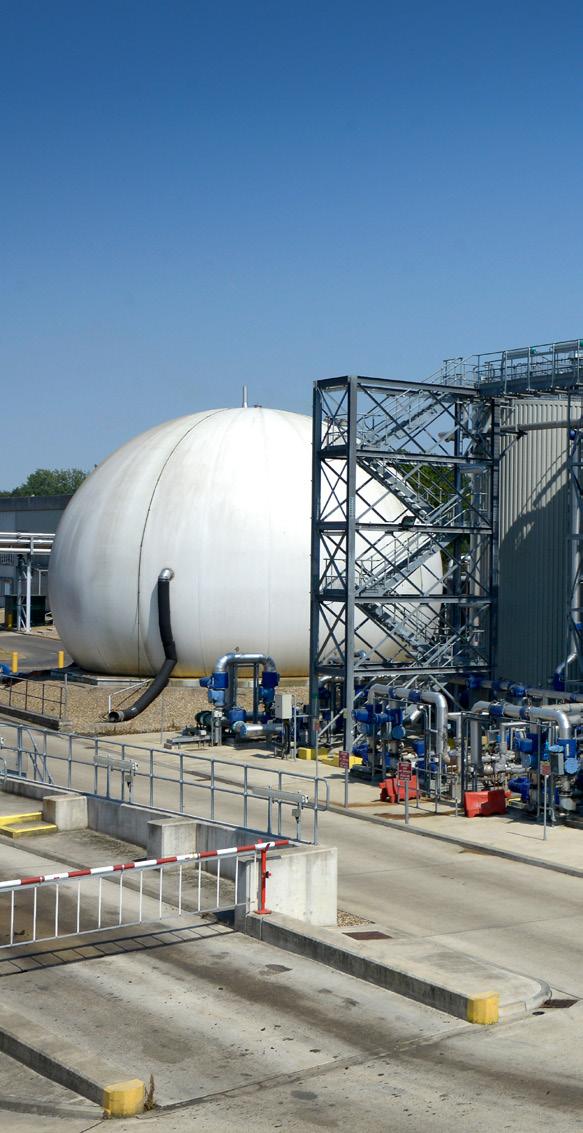
since 2013/14. It has been exciting to be able to work with the RDHV team since announcing our partnership a year ago, and I hope we’ll see many more Helea plants being installed to support other companies with their bioresources and net zero challenges.
At Anglian Water, we have more than 1100 water recycling centres that all produce sludge requiring treatment and safe onward recycling. We treat and recycle the sludge at ten regional sludge treatment centres. As a result, understanding the inputs, output and constraints of the overall network is
Innovation has been key in the development and deployment of advanced anaerobic digestion (AAD) technology now predominant in the UK
"Our bioresources operations have been productionised and it’s an area that continues to develop rapidly with the use of smart technology"Heating, Pasteurisation and Hydrolysis (HpH) technology at Anglian Water’s treatment plant in Colchester, Essex
vital to drive optimum performance. Therefore, over time our bioresources operations have very much been productionised and this is an area that continues to develop rapidly with the use of smart technology. Combining this with complex modelling provides a dynamic view of our network and assets. In the future, as this capability develops, I see predictive analytics and other tools playing an even bigger role to drive further performance improvement opportunities.
There are also significant opportunities in the potential products that we
could produce from sewage sludge and biogas streams – both are really valuable resources. The sludge stream examples include the recovery of bio-polymers, bio-char, bio-oils, recovered phosphate as struvite and recovered ammonia products from liquor. For biogas, biomethane upgrading for grid injection is now commonplace but there are further possibilities for the capture and re-use of carbon dioxide and hydrogen production.
The challenge in this space is that we must quickly identify these technology opportunities, work closely with regulars, create partnerships and fully understand
the needs of the potential consumers of these products. There must be sufficient inertia created across the value chain to move from R&D scale to commercially deployable technology, much like the momentum that was achieved with AAD technology after the safe sludge matrix was introduced in the UK for biosolids to land recycling in 1998.
How is Anglian Water’s bioresources strategy linked to the company’s net zero 2030 ambitions?
Anglian Water has published ambitious plans to be net zero by 2030. Our bioresources activities form a crucial component to successful delivery. Our plans include a transition from CHP power generation of renewable heat and power fuelled by biogas to biomethane upgrading and grid injection. By 2030 we plan that at least 54% of the biogas we produce will be upgraded and injected to grid. When we switch from CHP it is important that we consider alternative low-carbon ways of powering and heating our processes. We anticipate, therefore, that the site’s electricity demand will be provided by solar. We also have plans to integrate heat pumps recovering heat from our effluent and sludge, to minimise the fuel input requirements for our process boilers that heat the sludge treatment processes.
We also operate a large fleet of trucks to move sludge and treated biosolids products in and out of our centres. Our plan includes the transition of this fleet to alternative low-carbon fuels such as bio-CNG, LNG and in the
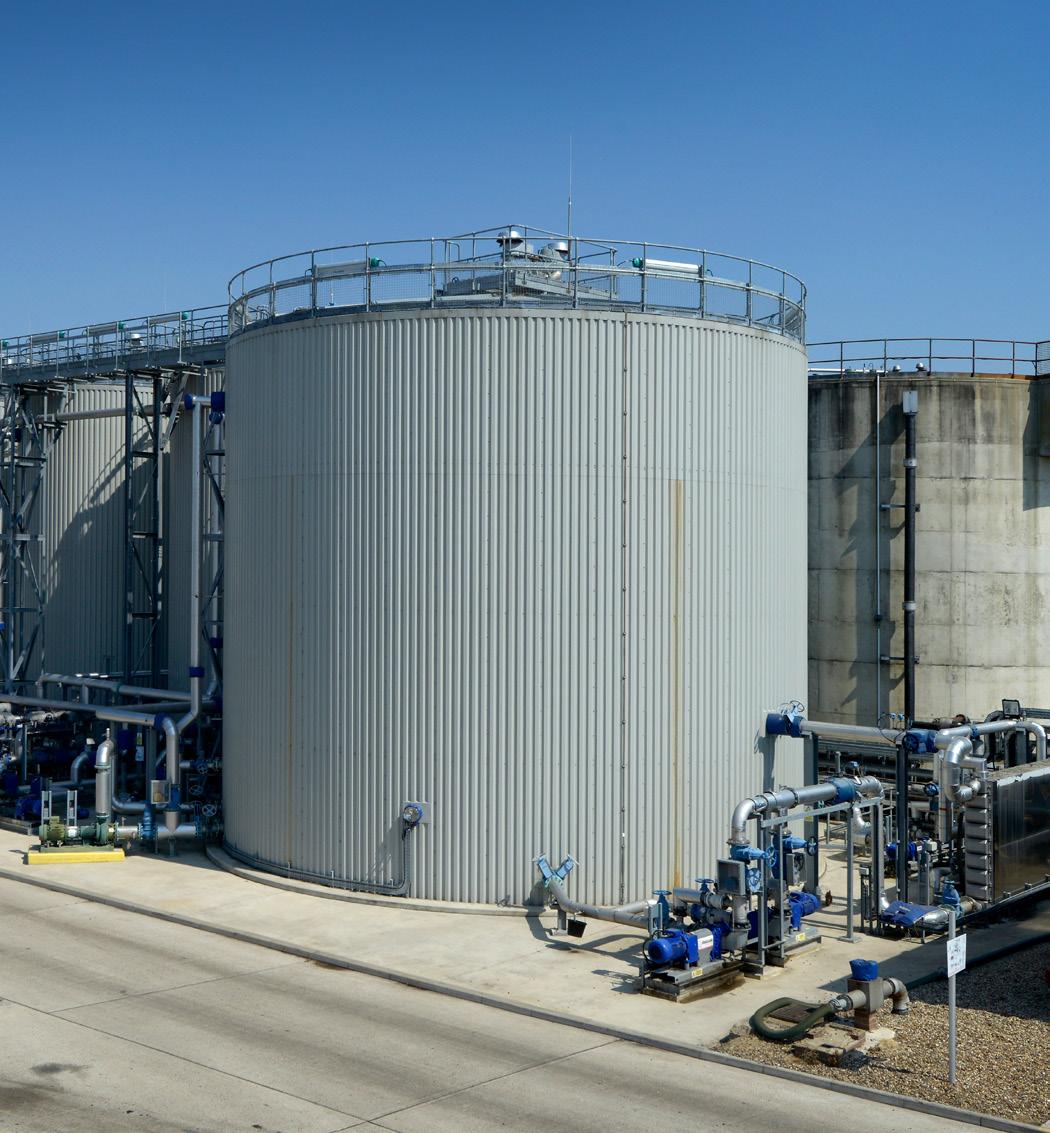
"Investing in technology to measure and mitigate process emissions from our bioresources operations will support our net-zero ambitions"
ANGLIAN WATER SERVICES
longer term, as technology develops electric or hydrogen.
Another significant area where bioresources can support our net zero ambitions is investing in technology to measure, understand and mitigate against process emissions arising from our bioresources operations. These could include vacuum degassing technologies, bio-augmentation to improve the conversion of organic matter to gas that we can capture clean and put to beneficial use, recovery of ammonia from dewatering liquors instead of traditional aerated treatment processes reducing the impact of NOx and capture of the carbon dioxide from the biomethane upgrading process.
What is the Bioresources Bid Assessment Framework, and how does it contribute to Anglian Water’s bioresource strategy?
To help promote markets and market engagement across the bioresources price control, Ofwat introduced a requirement for all companies to publish a Bioresources Bid Assessment Framework (BBAF). The idea of this framework is that companies wishing to offer services can submit proposals to the water company at any time. The BBAF sets out the type and the nature of the offers we would consider to support us in delivering our long-term bioresources strategy. It also sets out how such offers will be assessed. In principle, this allows a company to pitch ideas and sets out a clear path to a potential contract. Since we published our BBAF in September 2022 we have received a number of interesting
proposals that are in the early stages of assessment and are under consideration as to how they can support us in delivering our long-term strategic needs.
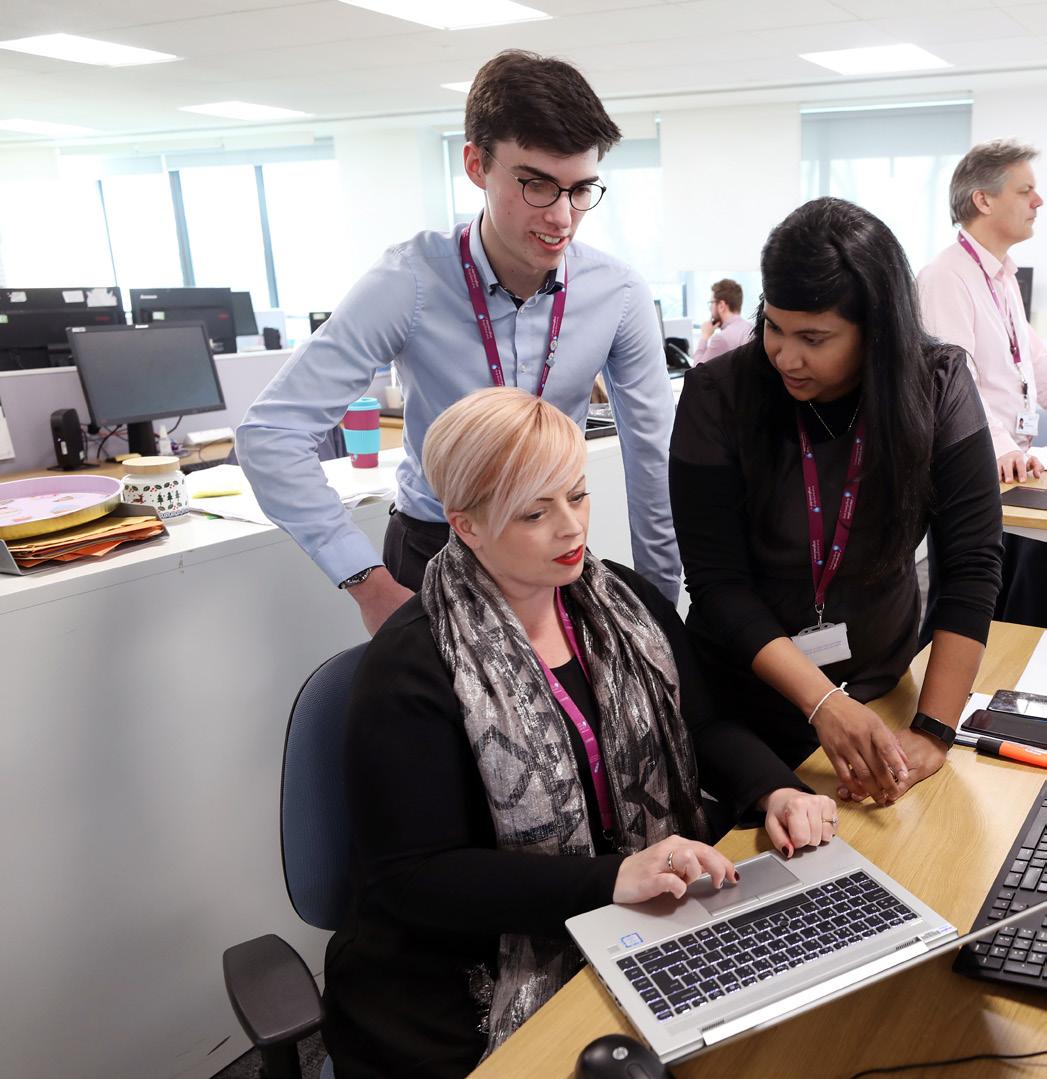
Could you discuss the challenges posed by micropollutants in wastewater? How are they addressed and how does this affect the recovery of bioresources?
Micropollutants in wastewater and their potential pathways to sludge through bioresources to the wider environment are certainly a concern. Where pollutants are flagged for concern I do believe that identification and reduction at source is critical. At
Anglian Water, we place environmental protection at the heart of everything we do. I do not believe it is acceptable or sustainable to just allow these chemicals to be discharged into sewer and then expect wastewater and sludge treatment to be the primary barrier to prevent release to the wider environment. I believe that’s a case of shutting the stable door after the horse has bolted, as there are many other pathways to people or the environment at point of use or production.
As a company and wider industry, we’re working hard to find better solutions to remove micropollutants from wastewater. This is an area where the
"It is not sustainable to allow pollutants to be discharged to sewer and expect wastewater treatment to be the barrier to prevent release"
industry and regulators are working closely together to monitor and undertake research. One example of this is the chemicals investigation programme (CIP) where we work closely with other water companies and the Environment Agency. These programmes look to monitor levels and identify emerging contaminants and understand how these partition to either the water or solid stream as wastewater is received and processed through treatment centres. Whilst micropollutants will be present and can be measured within bioresources products, the levels are below levels set within regulations and current guidance.
What are some of the trends affecting the recycling of biosolids?
There has been a clear trend over the last 10 years to move to advanced anaerobic digestion technologies, which I think is a really positive thing. I believe this will continue, as this technology is an effective solution and will likely form the foundations from which new emerging technologies are added.
I hope to see circular economy principles driving future trends. I expect sludge treatment centres of the future to be focused on the production of high-quality products. For example, recovered nutrients could be used as input materials into fertiliser manufacture, thus lowering the costs and carbon impacts of food production. Production of biomethane for grid injection is another solution which is already rising in popularity, which reduces the carbon impact of heating homes and businesses.
What are Anglian Water’s priorities in the area of bioresources for the next 5 to 10 years?
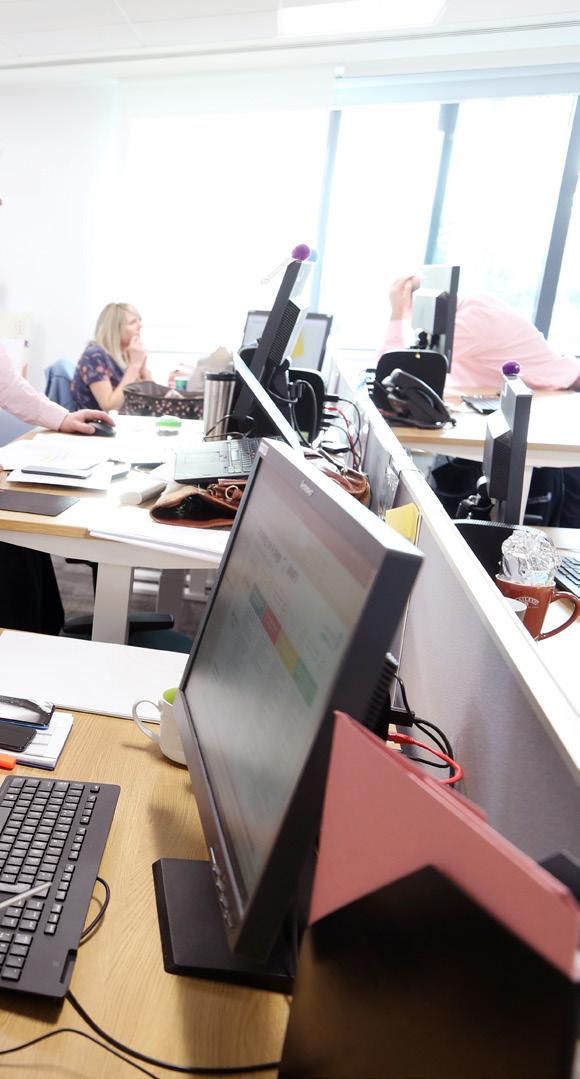
Our priorities will be to continue to provide efficient high-quality services and products through our bioresources operations that support our purpose, our mission and our values. Specifically, for bioresources, we will
continue to be a strong and supportive voice championing the benefits of safe, sustainable recycling of bioresources products into agricultural and energy markets. We will also explore partnerships and the use of markets to enhance the services and range of products that we offer. This will be in parallel with a focus on innovation, recognising the challenges, risks and opportunities that exist.
If I look forward 10 years I see our asset base evolving. Our core sludge treatment activities will still centre around advanced anaerobic digestion, but I anticipate the industry will start to move towards the integration of advanced thermal conversion technologies. This might include pyrolysis, producing such products as biochar and bio-crude oils that can be used as input material for the manufacture of a wide range of sustainable products.
Biomethane for grid injection is rising in popularity, a solution that reduces the carbon impact of heating homes and businesses
"We will continue to champion the benefits of safe, sustainable recycling of bioresources products into agricultural and energy markets"
The 16,000 m3/day plant will count on state-of-the-art engineering and technologies to enhance operational and maintenance costs
Dar es-Salaam Water Supply and Sanitation Authority (DAWASA) has selected Metito, a global leader for total intelligent water management solutions, to design, construct and operate a new wastewater treatment plant (WWTP) in the capital Dar es-Salaam, reports TradeArabia.
In a statement, Metito revealed that the new wastewater treatment facility will have 16,000 m3/day and will be built in the Mbezi Beach area, in Kinondoni District. The plant will count on stateof-the-art engineering and technologies to enhance operational and maintenance costs, improve sludge quality, and minimise the overall carbon footprint.
Metito will be in charge of the operation and maintenance of the wastewater treatment plant for three years with
the participation of DAWASA’s staff in all operational sections of the treatment plant. Metito will use the sludge anaerobic digestion process in the first treatment phase to ensure the sludge is stabilised and the quality of the sludge is maintained. The company will also use conventional activated sludge technology and implement anaerobic digestors to produce biogas followed by Combined Heat and Power (CHP) generation system which will reduce electric power consumption by almost 40 per cent at ultimate plant capacity.
This project is being financed by the Government of the United Republic of Tanzania in collaboration with the World Bank. Work on the project is planned to begin this month and the commissioning date is set for October 2024.
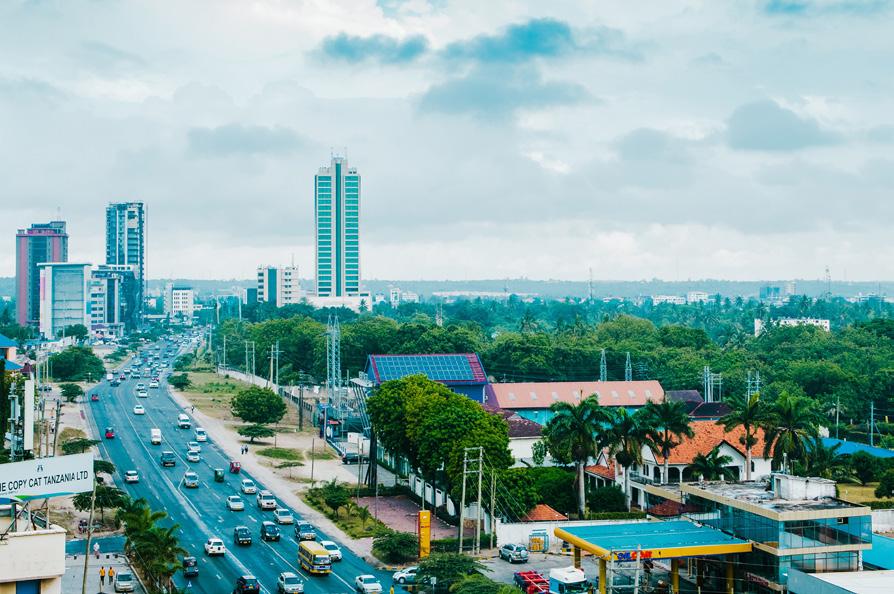
Hundreds of water projects are planned to meet the nation’s future water demand
Saudi Arabia has assigned a budget of over $80 billion for the implementation of hundreds of water projects in the coming years as part of the Kingdom’s efforts to achieve universal and equitable access to safe and affordable drinking water for all, said a top minister, reports Arab News.
During the UN 2023 Water Conference held at the end of March in New York, Dr Abdulaziz Al Shaibani, the Kingdom's Deputy Minister for Water at the Ministry of Environment, Water and Agriculture said the national water strategy was in line with the goals of sustainable development.
"The Kingdom aspires to provide sanitation services to all by increasing the percentage of the population covered by sanitation services to be more than 95% by 2030. Also, Saudi Arabia established the National Water Efficiency and Conservation Center," said Dr Al Shaibani.
The Kingdom's water requirements were estimated at 24.8 billion cubic meters in 2015, and are experiencing an annual increase of 7%. The agricultural sector is the largest consumer, with 84 per cent of the total water demand.
Saudi Arabia is on track to meet the United Nation’s Sustainable Development Goals by 2030, added Al Shaibani during the event, thanks to the reorganisation of the water sector and the creation of the National Water Strategy. Saudi Arabia’s National Water Strategy has 10 programmes, which include the private sector in production and wastewater treatment focusing on pooling production and wastewater treatment assets to privatise them.
The approved projects include seven desalination projects, six wastewater treatment projects, and ten strategic water reservoir projects
Saudi Arabia’s National Center for Privatization & PPP (NCP), in cooperation with the targeted sectors for privatization in Saudi Arabia, announced last week the launch of the Privatization & PPP (P&PPP) pipeline consisting of 200 approved projects in 17 sectors.
Of the 200 approved schemes, seven are desalination projects starting 2024, representing an aggregate desalination capacity of 2.8 million cubic meters per day, reports Zawya. The Independent Water Plant (IWP) projects, owned by the Saudi
Ministry of Environment, Water & Agriculture, would be procured under 25-year Build-Own-Operate (BOO) contracts.
Saudi Arabia will also tender six wastewater treatment projects in 2024. The five Independent Sewage Treatment Plant (ISTP) projects and the sole Small Sewage Treatment Plants (SSTPs) and Collection Network project will treat wastewater for reuse in non-agriculture municipal and industrial applications. The five ISTPs represent an aggregate wastewater treatment capacity of 650,000 cubic metres
per day. The projects would be procured by the Ministry of Environment, Water & Agriculture, under Build-Own-Operate-Transfer (BOOT) contracts.
Lastly, Saudi Arabia will tender 10 strategic water reservoir projects, representing an aggregate water storage capacity of 36 million cubic metres. The IWSRs, owned by the Ministry of Environment, Water & Agriculture, would be procured under 35-year BOOT contracts, and tendered over a seven-year period starting next year (2024).
HRS Heat Exchangers operates at the forefront of thermal technology, offering innovative and effective heat transfer products worldwide, focusing on managing energy efficiently. Wastewater


Waste streams from: Agriculture, Food, Pharmaceutical and other industries
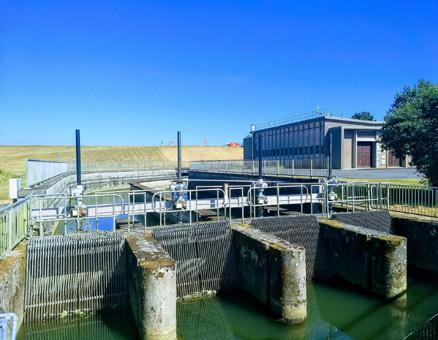
The final offers will be received from companies in August 2023, and the project will begin by end of this year, to be completed in 2026
Engineer Essam Al Mulla, Director of the Water and Desalination Plants Department at the Sharjah Electricity, Water and Gas Authority (SEWA) explained that the Authority has submitted its proposal for developers after completing the preparation of technical, financial and legal studies and technical specifications in cooperation with consulting companies. He said that 42 world leading companies showed their interest in the project, among which 8 were selected. He pointed out that the Authority will receive the final offers from companies in August 2023, and by the end of this year, the executing company will be selected and the implementation of the project will begin. The project is expected to be completed in 2026.
He stressed that the SEWA is witnessing development in its work sectors and the implementation of expansions and ambitious development projects to keep pace with the comprehensive development process in the areas of infrastructure and the construction boom that the Emirate of Sharjah is experiencing, thanks to the follow-up and directives of His Highness Sheikh Dr Sultan bin Mohammed Al Qasimi, Supreme Council Member and Ruler of Sharjah. He added that the Authority is working on applying advanced technology and developing policies in water desalination and working to increase its sustainability. It also works to raise the efficiency of the plants, reduce economic cost and lessen the environmental impact.
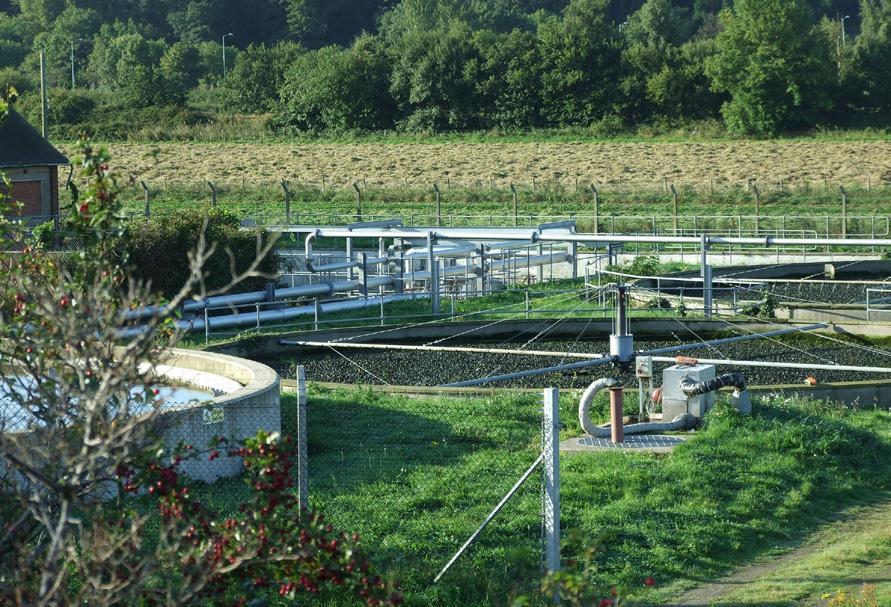
The seawater RO plant is Southeast Asia's largest desalination project
The WABAG Group, headquartered in Chennai, India, has been awarded a Rs 4,400-crore (US$599 million) seawater reverse osmosis (SWRO) project in Tamil Nadu, the southernmost Indian state, as part of a joint venture with Metito Overseas, reports India Times.
Once completed, it will be the largest seawater desalination project in Southeast Asia with a total capacity of 400 MLD (million litres per day) and will be implemented on a design, build, operate (DBO) model. Japan International Cooperation Agency (JICA) will fund the project with the aim to strengthen Chennai and the state’s water security.
In a statement released by the company on Friday, WABAG informed that it had won “a seawater reverse osmosis project from Chennai Metropolitan Water Supply and Sewerage Board. The Rs 4,400-crore is South East Asia's largest ever seawater desalination with a capacity of 400 MLD project funded by JICA."
The landmark project for WABAG will be built over a period of 42 months followed by 20 years of operation and maintenance (O&M) by WABAG. The contract includes the design, engineering, procurement, construction, installation, testing and commissioning of the 400 MLD (million litres day) SWRO desalination plant and the associated seawater intake system.
"WABAG has won this order against the global competition... This puts WABAG on an inclined growth path for the future," said Shailesh Kumar, CEO of India Cluster, WABAG.
The world faces unprecedented challenges in terms of water security. These include population growth, increasing urbanisation, a decline in traditional sources of freshwater, and water scarcity driven by climate change. It is important to remember that for every litre of freshwater put into the public system, there is an extra litre of wastewater which needs treating.
There are a number of applications for heat exchangers in wastewater treatment. They can be used to recover heat from raw or treated sewage, to preheat sludge prior to anaerobic digestion, or to remove water from wastes and sludges
through evaporation. Pasteurisation of waste streams may be required to meet environmental rules, or water or effluent may need cooling before it is discharged to the environment in order to meet local legislation. Each process will place different demands on the heat exchanger being used, and some processes may be combined (e.g., recovering heat from treated sludge and using it to pre-heat untreated sludge before digestion).
The basic practical considerations when choosing a heat exchanger for wastewater treatment are the same as for any other application and include factors such as
the physical space available, the available temperature of the product and process materials and the required temperatures after processing, acceptable pressure drop, and the service materials being employed. However, there are also other considerations which while not unique, are particularly relevant to wastewater and sludges. These include the physical nature of the material and the potential for fouling in the heat exchanger, ease of maintenance and the ability to operate reliably for long periods of time. Finally, general considerations include energy efficiency, capital and operating costs, which are also crucial

to the final choice of the heat exchanger. The total cost of ownership should be considered, as units that are cheap to purchase often have higher running costs or lower operational efficiencies.
Obviously, the biggest factor when choosing a heat exchanger is the nature of the material itself. Some wastewater streams will be relatively clean, containing only a few dissolved chemicals, while others will be a mixture of dissolved and suspended materials. At the other extreme, the thickest most viscous semi-solid sludges will need significant power to move them through the ex-
Heat exchangers often play an important role in wastewater treatment systems, but given the nature of wastewater streams and the processes involved, including evaporation and anaerobic digestion, it is important that the right technologies are selected to maximise process and energy efficiency.
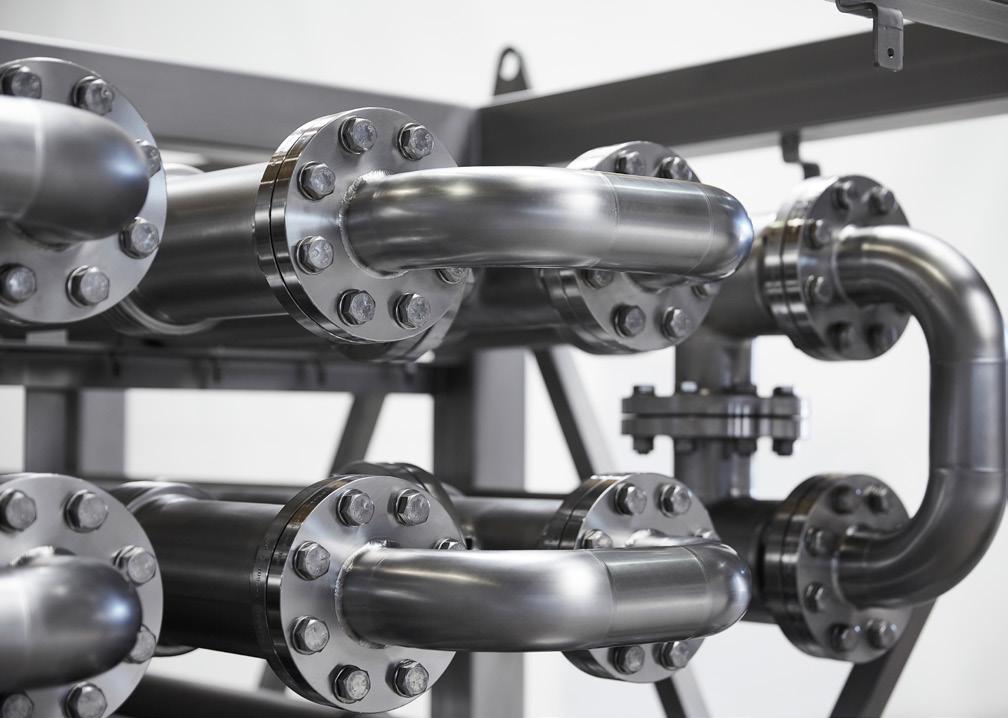
changer, and the risks of fouling and the importance of the pressure drop will therefore be much greater.
Several types of exchanger are utilised in wastewater treatment with differing levels of success, according to the type, the actual design of individual units, and the processes they are used for. In essence, the four types of heat exchangers encountered in wastewater treatment are: spiral heat exchangers; plate heat exchangers; tubular heat exchangers; and scraped surface heat exchangers.
Spiral heat exchangers (SHEs), which are sometimes known as shell and coil
heat exchangers, are commonly used in wastewater and sludge applications. They consist of a single channel formed into a spiral or coil, creating a compact design. Various options such as wider spacing
The biggest factor when choosing a heat exchanger is the material, from relatively clean wastewater streams to viscous semi-solid sludges

and the removal of baffles are employed to try to reduce fouling and the design’s large surface area and true counter-current flow result in high thermal efficiency. However, they require regular cleaning (which is both time-consuming and costly) and are often unsuitable for sludge-to-sludge heat transfer.
Plate heat exchangers (PHEs) are one of the most common types of heat exchangers and they have a compact design with good thermal efficiency. However, they are highly prone to fouling and are often only suitable for relatively clean, non-viscous materials. Their maintenance schedules also often require regular replacement of the gaskets that separate the plates.
Tubular heat exchangers, also known as shell and tube, comprise a tube or tubes within another tube or vessel. Because of the various designs and geometries available, they are better able to cope with more viscous materials and suspended solids. Depending on their
design, they can require more space than some other designs, and can be susceptible to fouling. These issues are greatly reduced by using corrugated tube designs, and HRS produces a range of efficient and cost-effective corrugated tube heat exchangers for wastewater and environmental use, depending on the viscosity and physical characteristics of the product. These include the DTI and DTR Series of Double Tube designs for more viscous products, and the C & K Series of Multi-Tube designs for lower viscosity fluids which may contain small particles.
Scraped surface heat exchangers (SSHEs) are used where materials are very viscous or have a high fouling potential, so they are particularly suited for treating thick sludges and for use in evaporation systems. The use of a scraper keeps the tube surface clean and maintains high thermal efficiency, while the individual design may provide other benefits, such as controlling product viscosity during processing. HRS offer two different types of scraped surface heat exchanger, but the most suitable for wastewater applications is the patented Unicus Series that uses a reciprocating action with a choice of scraper geometries, making it ideal for applications such as effluent evaporation, where fouling or low heat transfer is a problem.
As well as effective and efficient water treatment and heat transfer, another consideration for managers in the wastewa-
ter treatment sector is the overall energy and environmental footprint of their operations. Operational efficiency is of utmost importance in wastewater treatment facilities, and this has traditionally been the driving factor for innovation in the sector. Reducing energy consumption is not only good for the bottom line, but also for the planet.
In many parts of the world, wastewater treatment plants (WWTPs) are being challenged to become net zero in terms of carbon by 2030. Achieving such challenging targets will require recovery of the energy contained in the incoming wastewater streams and using this to provide the heat and power necessary for wastewater treatment and solids handling.
Anaerobic digestion is widely used as a wastewater treatment mechanism, and so it makes sense for the technology to produce usable energy via biogas (whether in the form of heat, electrical power or biomethane fuel). At the current time, most of the biogas generated in the wastewater sector is used onsite for digester heating, while other uses include heating buildings, power generation, or driving process machinery.
One recent example saw the installation of an improved heating system as part of a larger upgrade to one of Tasmania’s most important wastewater treatment plants in Australia. HRS supplied the contractor, Aquatec Maxcon, with a corrugated tube heat exchanger to warm the recirculating sludge and maintain optimum operating temperatures in the main digester.
The supplied unit consists of a six-module HRS DTI Series heat exchanger to raise the sludge temperature from 33 °C to 36 °C, with a capacity to process 72,000 litres of sludge every hour using hot water supplied by a separate boiler. To facilitate routine maintenance and cleaning, the heating unit has been installed outside the digester; a design which is rapidly becoming the norm for biogas plants due to the benefits it provides over internal designs.
HRS produces a range of efficient and cost-effective corrugated tube heat exchangers for wastewater and environmental use
Several types of exchanger are used in wastewater treatment, success depending on type, unit design, and the processes they are used for
The energy created by anaerobic digestion also has the potential to be used for improved sludge management, and digestate and sludge concentration using equipment based on heat exchangers is a more efficient and sustainable alternative to traditional drying methods.

Some such systems reduce the overall quantity of digestate or sludge by 6080%, greatly reducing associated storage requirements and transport costs. They also include measures to retain the valuable nutrients while the evaporated water can be condensed and reused. In many cases, the captured water is added back to the feedstock making the entire process almost self-sufficient in terms of water use and eliminating liquid discharges from the plant. After concentration,
the treated digestate can contain up to 20% dry solids, making it much easier to transport and handle, and as much heat as possible is recaptured and reused in the process, making it more energy efficient than alternative treatments.
Where sludge or digestate requires pasteurisation, for example, so that it can be used as an agricultural biofertiliser and soil conditioner, heat exchanger-based pasteurizer systems use up to 70% less energy than traditional technologies. Again, heat and energy recovery should be maximized to increase the overall process efficiency.
Choosing such systems again depends largely on the nature of the material being treated (for example, viscosity or solids content), but also the
source/s of energy available. Is waste heat available, or will you need to install a boiler or CHP unit? Will such a unit be powered by biogas produced by onsite anaerobic digestion? These questions not only affect the economics of sludge treatment, but also the type of system and the exact nature of the heat exchangers employed within it.
Scraped surface heat exchangers (SSHEs) are particularly suited for treating thick sludges and for use in evaporation systemsSpiral heat exchangers can be difficult to clean and maintain
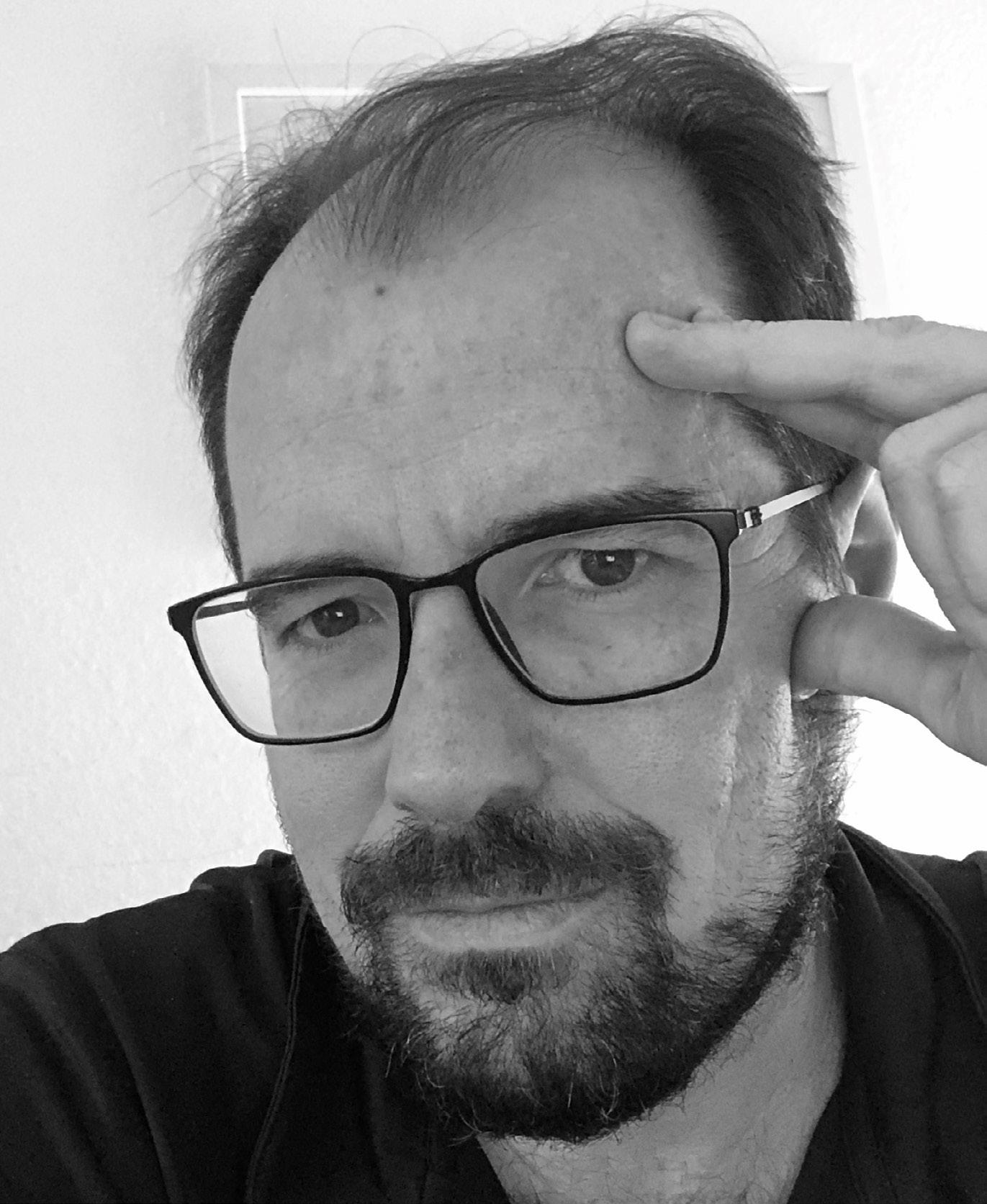
How did the idea of preparing the report Microplastics and micropollutants in water: emerging concerns arise?
Microplastics and micropollutants are a hazard to human and environmental health. The European Investment Bank is looking for solutions to mitigate the impact of these emerging contaminants through financing or technical assistance, in line with its sustainability objectives.
A new report by the European Investment Bank (EIB), Microplastics and micropollutants in water: emerging concerns, looks into these contaminants of emerging concern and explores possible solutions which are already in the market, but due to some market failures are not yet fully implemented. Juan Bofill, Senior Water Engineer at European Investment Bank, author of the report, answers our questions on different approaches to reduce microplastics and micropollutants in water bodies.
Can you tell us briefly about your career path and your current role at the European Investment Bank?
I am a chartered civil engineer and I have been working at the European In-
vestment Bank for almost seven years, in the Water Management Division of the Environment and Natural Resources Directorate, which is part of the Projects Directorate. At the European Investment Bank, and the Climate Bank of the European Union, I work on the appraisal and monitoring of water projects. I provide technical assistance and cooperate with other institutions. I also deal daily with technical issues affecting the projects that we support with our clients and our beneficiaries.
The EIB aims to generate a positive economic, social, and environmental impact on society. Its financing tackles market failures by reducing investment gaps, in line with the Bank’s public policy goals and its climate action and environmental sustainability objectives. The water sector plays an important role in achieving these objectives, so I am very pleased to be able to contribute to them. During my previous 18 years of experience, I worked in the private sector which is a crucial ally for public financers like the EIB to reach the global climate and sustainable development goals.
Both microplastics and micropollutants are known as “contaminants of emerging concern” (CEC). At the EIB, we are constantly looking for solutions to address technical problems after we identified them, through financing or technical assistance. Thanks to its technical expertise, the Project Directorate of the EIB allows the Bank to understand different issues and to offer solutions to mitigate them. Microplastics caught our attention for some time as they are significantly threatening our health, the environment and biodiversity. Microplastics are tiny solid plastic particles smaller than five millimetres. According to a recent estimate, a person who eats seafood will swallow, on average, 11 000 pieces of microplastics every year. This risk is more and more known by the media and the general public. More than 80% of EU citizens are concerned about the impact of microplastics on their health and on the environment. For me as a water engineer at the EIB, I was very concerned by the fact that more than 96% of the 1.5 million tonnes of microplastics are discharged yearly to the oceans by water pathways, similar to micropollutants. This report was written with the aim to flag these problems and explore possible solutions which are already in the market, but due to some market failures are not yet fully implemented.
Can you comment on the relative need, effectiveness, and cost of measures that tackle the production of microplastics versus “end-of-pipe” solutions?
Upstream solutions are a complex problem. Plastic is a very useful material, and according to some studies (e.g. Breaking the Plastic Wave), the prediction is that the volume of plastic on the market will double in 2040 when com -
“WWTPs are not the producers of micropollutants but rather the opposite, can be the solution”
Z
Cristina Novo Pérez
"The private sector is a crucial ally for public financers like the EIB to reach the global climate and sustainable development goals"
pared to 2016. Most microplastics are produced as degradation or abrasion of bigger plastics, so unfortunately the problem is expected to grow. The socalled “intentionally added microplastics” in personal care products are already regulated by a proposal from the EC dated August 2022. But this is a tiny portion of microplastic pollution. Most of this pollution comes from tyre abrasion, clothing and city dust. Upstream solutions would require a combination of more sustainable behaviours, innovation and policy enforcement. End-of-pipe solutions are a reality. Wastewater treatment plants (WWTPs) are active barriers against these contaminants. Effective stormwater management can also contribute significantly. However, more research is required to solve the final fate of these microplastics that can end up in the environment if sewage sludge from WWTPs is used as fertilizer.
Can you tell us about recent and expected developments in European policy to address microplastic pollution through monitoring and mitigation in freshwater systems, and improvements in wastewater management? This issue is more and more present in European policy discussions. For instance, the EU Zero Pollution Action Plan approved in 2021 and a key deliverable of the European Green Deal contains a target of reducing microplastic pollution by 30% by 2030. Two key pieces of legislation to achieve this target are the new Drinking Water Directive, applicable already today, and the recently proposed revision of the Urban Wastewater Treatment Directive, which calls for improved stormwater management and expands the scope of the Directive to the collection and treatment of wastewater to smaller agglomerations (the threshold size is lowered from 2,000 population equivalent to 1,000 population equivalent). If adopted by 2025, will lead to further monitoring and reduction in microplastic discharge into water bodies.
According to the report, in most EU Member States, WWTPs are the biggest pathway for micropollutants to enter water bodies. Could you discuss some
of the challenges with removing micropollutants from treated wastewater?
WWTPs can be considered the biggest pathways for micropollutants because these are the end point of the collection of wastewater in urban areas, collecting these pollutants like chemicals and pharmaceuticals from houses, industries or hospitals. Therefore, WWTPs are not the producers of these micropollutants but rather the opposite. These facilities can be the solution. However, regular WWTPs are usually designed to eliminate macro-pollutants and do not fully remove
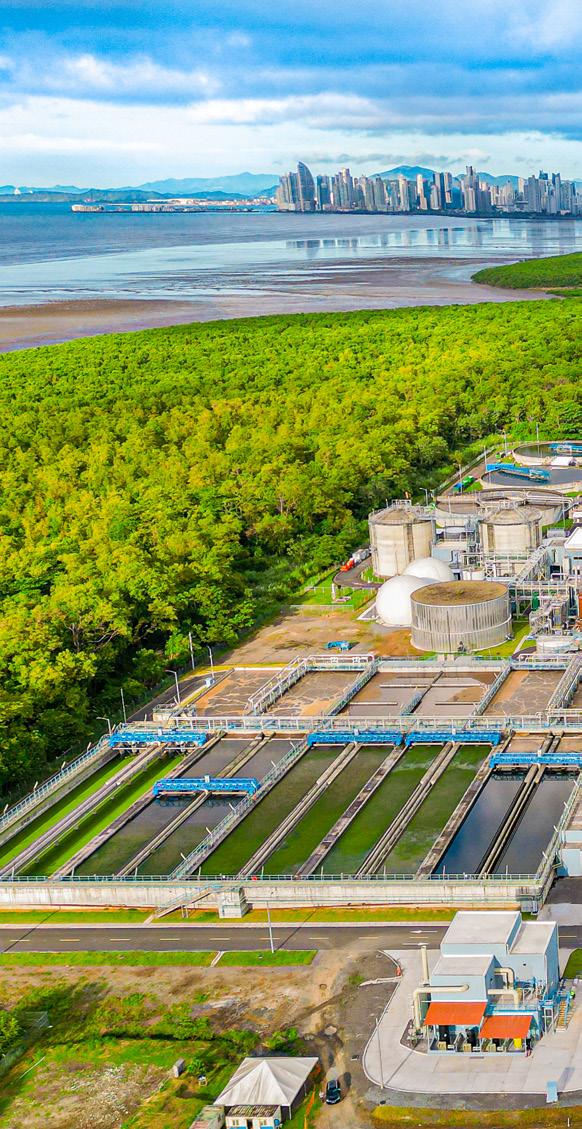
"The EU directives on drinking water and urban wastewater treatment are key to achieve the 30% microplastic reduction target by 2030"
More than 96% of the 1.5 million tonnes of microplastics are discharged yearly to the oceans by water pathways, similarly to micropollutantsWastewater Treatment Plant Juan Diaz in Panama financed by the European Investment Bank.
micropollutants from treated wastewater. Additional treatments so called “fourth steps” or “quaternary treatments” need to be added.
To what extent do you think advanced treatments (fourth step or quaternary treatment) will be implemented in Europe to remove micropollutants in the next 10 to 20 years?
The proposal for a revised Urban Wastewater Treatment Directive already provides for this advanced treatment. The proposal requires large wastewater treatment plants (defined
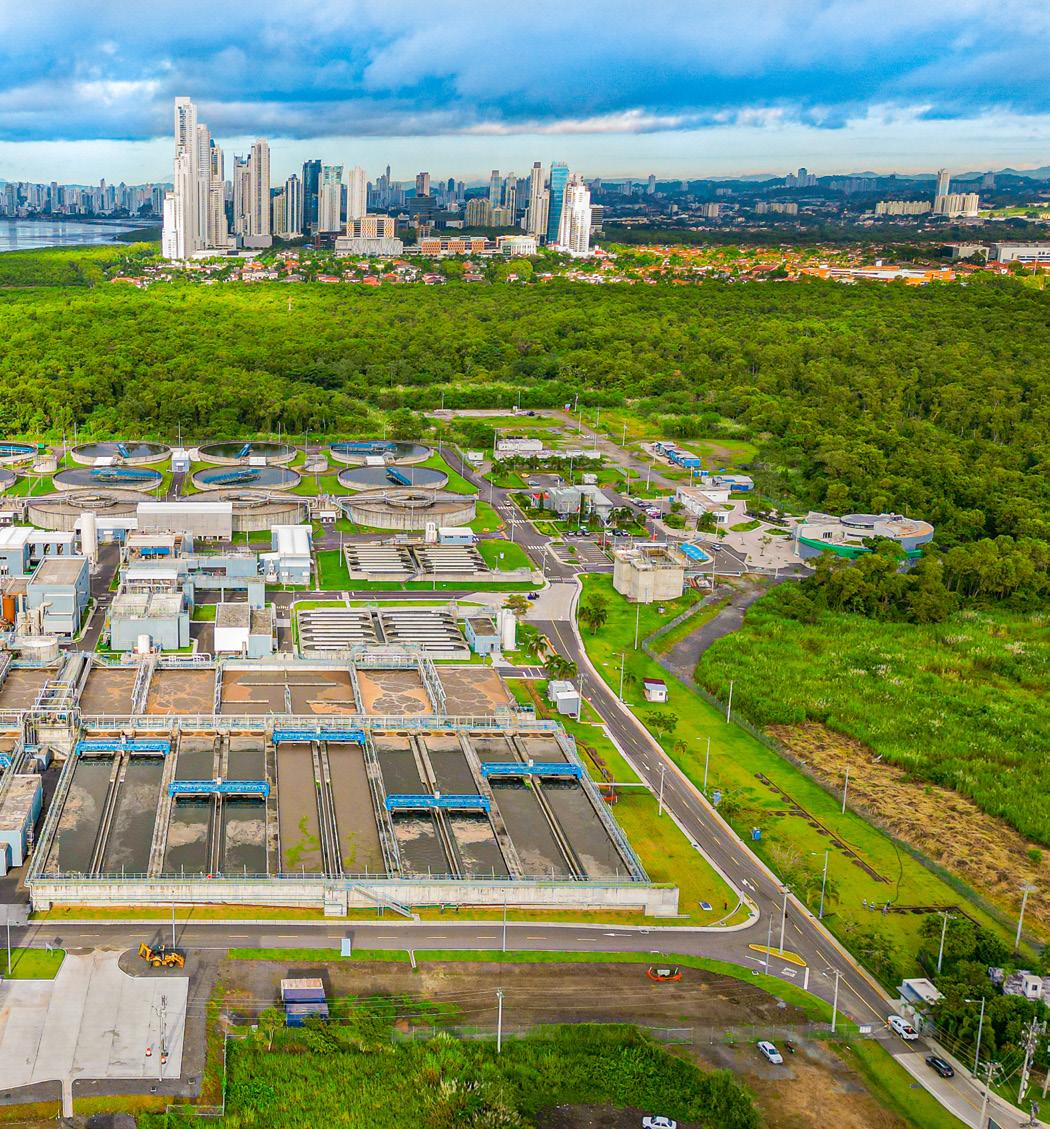
as having a capacity of at least 100 000 person equivalents) to add a fourth treatment stage to the wastewater treatment process by 2030 at the latest. This requirement would also apply to wastewater treatment plants with a capacity of at least 10 000 person equivalents that discharge effluent into water bodies that are classified as “being at risk”. The goal for this so-called fourth step or quaternary treatment would remove at least 80% of certain micropollutants. Of course, this would require a significant financial effort. Some studies value the addition of the
quaternary treatment to between €70 per capita and €95 per capita, depending on the selected technology. I am not sure how the wastewater sector will react to this cost increase and if finally the proposal will be approved in these terms. However, my personal opinion is that indeed additional treatments will be implemented to address these contaminants of emerging concern. Though the extent is uncertain.
How does the EIB plan to support the development of approaches to reduce microplastics and micropollutants in water across the world?
As a public institution, the EIB plays an important role to help overcome investment barriers and ensure that the projects it finances are the most suitable to address market failures and alleviate investment gaps. At present, the wastewater utilities do not have significant incentives to invest in facilities that would reduce the release of microplastics or micropollutants into the environment, as the benefits of these investments can hardly be captured in the form of higher tariffs. To address this market failure, the EIB provides long-term financing to water utilities, water resource managers and industrial wastewater users. In addition, the Bank may support project preparation and implementation through dedicated technical assistance. The pollution reduction of these contaminants of emerging concern is specifically mentioned in the recently published EIB Water Sector Orientation
"Regular WWTPs are usually designed to eliminate macropollutants and do not fully remove micropollutants from treated wastewater"
Many water and wastewater facilities still use old, inefficient electric motors. Modernizing motor systems is the key to cutting costs, meeting rising demand, and reducing emissions.
Demand for clean water already exceeds supply in several regions. Several trends, including rapid population growth, urbanization, and climate change, are likely to cause further challenges to delivering safe water in the years ahead.
Wastewater and water treatment plants currently use a significant amount of energy. Estimates suggest that the water and wastewater industries combined consume between 3.5 and 4 per cent of the world’s total electrical energy. As the price of energy increases, facilities’ operating costs and the cost per litre of water also increases.
To ensure global water security and limit emissions, the water and wastewater sectors need more energy-efficient, cost-effective solutions. Electric motors are a logical place to start, as motor-driven applications – including pumps, compressors and fans – are found at every stage of water treatment.
In many countries, motor efficiency categories are defined by the International Elec-
trotechnical Commission (IEC) efficiency rating system. Today, the categories range from IE1 to IE4. Each increase in number, such as from IE3 to IE4, represents a 20 per cent decrease in energy losses, meaning that the motor is more efficient.
Many water and wastewater facilities still rely on older IE1 or IE2 motors. A good deal of these motors are still in working condition, but they consume a disproportionate amount of electricity and place unnecessary pressure on the power network. Furthermore, when a majority of these motors fail they are sent for repairs instead of being replaced. The cost attached to this comes at a higher price. This represents a significant opportunity to improve efficiency.
To maximize energy efficiency, facilities can adopt modern motors. The most efficient motors available today are synchronous reluctance motors (SynRM), which achieve IE5 efficiency. A SynRM motor typically delivers energy losses 50 per cent lower than an IE2 motor and 40 per cent lower than an IE3 motor.
With energy prices at their long-term average, a facility that upgraded its pump motors from IE3 models to IE5 SynRM motors would expect a payback period of 11 months. However, since energy prices are currently far higher than average, the payback period is even shorter – potentially just a few months.
Once the motor has achieved payback, it continues to provide savings for the
rest of its lifetime. This is because the upfront cost of a motor is just 2 per cent of the total cost of ownership (TCO), on average. For ease of retrofitting, IE5 SynRM motors are available in the same dimensions and output power classes as induction motors.
Additional advantages to upgrading
A primary reason for adopting IE5 motors is that they future-proof installations against upcoming legislation. From July 2023, the EU Ecodesign regulation will require a minimum efficiency of IE4 for motors rated between 75 kW and 200 kW in new installations and upgrades. This makes Europe the first region in the world to require IE4 efficiency, and others are sure to follow.
Furthermore, there are operational benefits to adopting SynRM motors. For example, they have a significant advantage over induction motors in pumping applications. Induction motors can experience slip – meaning that the shaft moves slower than the synchronous speed, wasting energy. Slip is common during start-up. Facilities often over-specify induction motors for pump applications to counteract slip. SynRM motors experience zero slip. Facilities can therefore replace over-specified induction motors with SynRM motors one size smaller, delivering immediate cost savings.
Motors can also be paired with a variable speed drive (VSD) to achieve greater energy efficiency and can cut energy use by
With current energy prices, the payback period of upgrading pump motors from IE3 models to IE5 SynRM is potentially just a few monthsZ Joris Cocquyt, Global Head of Sales IEC LV Motors Division, ABB
between 14 and 25 per cent. A drive adjusts a motor’s speed to precisely match the task’s requirements, increasing efficiency.
Specialist water drives are available with features designed specifically for water and wastewater applications, such as sensorless flow calculation, multipump control, level control, soft pipe fill, dry run protection, quick ramps, pump cleaning and anti-cavitation. These built-in features remove the need for additional equipment and enable a facility to operate optimally.
Using modern motors to design advanced pumps
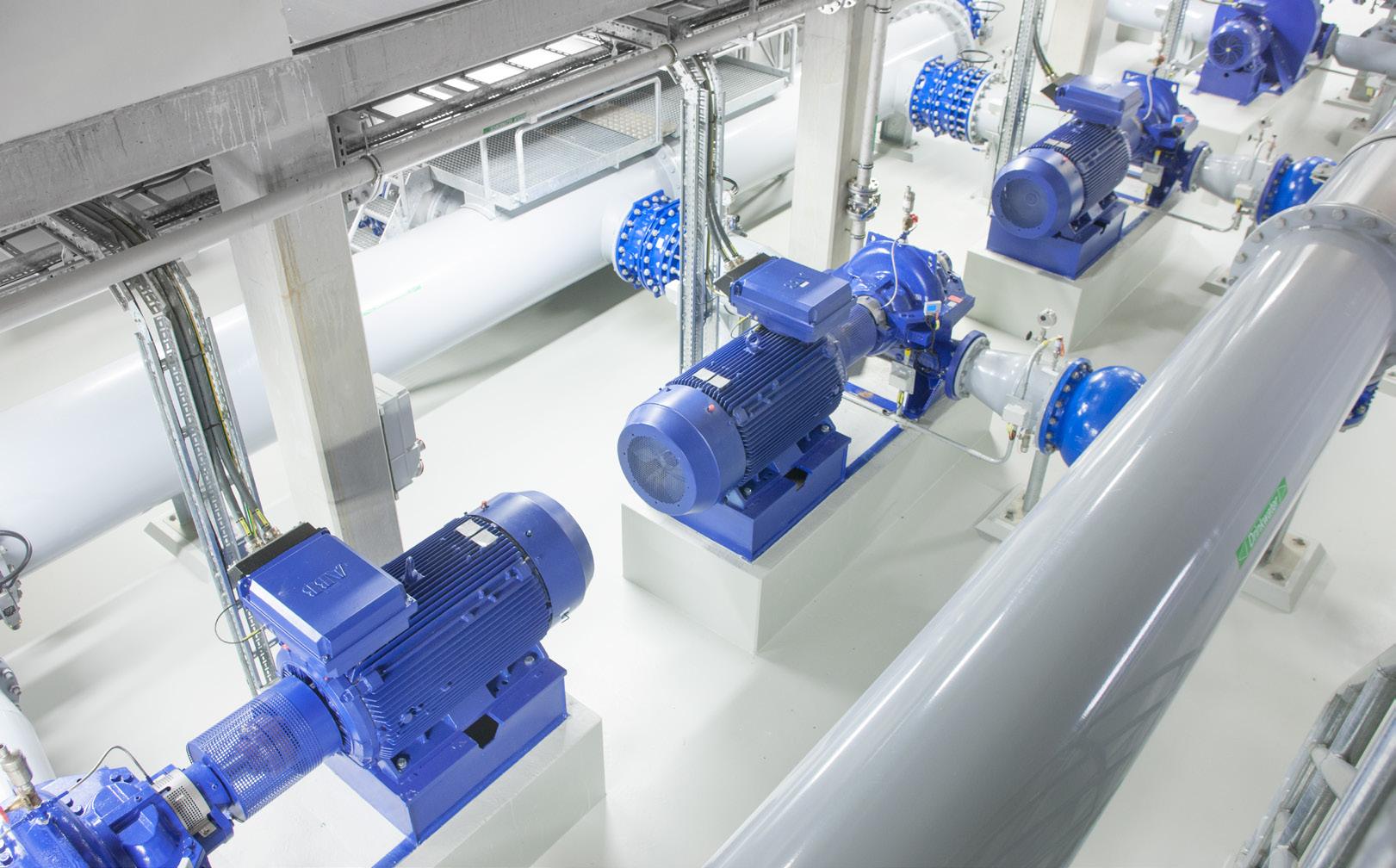
Dutch manufacturer Rodelta produces pumps for drinking water applications. They include diffuser technology and are

designed for large variations in demand. To ensure that its pumps are as efficient as possible, Rodelta specifies SynRM motors from ABB. These motors are an ideal fit for the application, as they achieve high efficiency across the entire operating range. The pumping stations that use these pumps typically operate nonstop, so any efficiency improvement quickly results in significant energy savings. Rodelta’s new SynRM pumps have been successful in their first installation at a De Watergroep facility in Leut, Belgium. The two motors, rated at 75 and 132 kW, drive pumps with capacities of 240 and 350 m3/hour.
Continuing to use older, less efficient motors is often a false economy – facil-
For more information please visit:
ities can significantly cut their operating expenses by switching to more efficient motors. This is especially true when much of the material in older motors can be recycled and new models can be made from recycled materials, so upgrading does not result in new waste. Upgrading to efficient motors is key to meeting demand – and it’s better for both business and the planet.
SynRM motors experience zero slip, therefore facilities can replace over-specified induction motors with SynRM motors one size smallerDIRECTOR OF ADVANCED REMEDIATION TECHNOLOGIES, U.S. DEPARTMENT OF ENERGY, OFFICE OF FOSSIL ENERGY AND CARBON MANAGEMENT
The Office of Fossil Energy and Carbon Management – U.S. Department of Energy – will make more than $18 million available in funding for research and development projects that focus on the characterisation, treatment, and management of oil and gas-produced water and wastewater associated with coal power plants.
The U.S. Department of Energy is funding R&D projects to help lower the cost of developing and demonstrating technologies to manage wastewater from the fossil fuel energy sector safely and effectively. The technologies, processes, and methods developed will not only mitigate the impacts of disposal of these waste streams, but also provide an alternative water source for other industries and users, and allow for the potential recovery of critical minerals, including rare earth elements. Vanessa Nunez-Lopez, Director of Advanced Remediation Technologies at the Office of Fossil Energy and Carbon Management discusses in this interview the expected econom -
Z Cristina Novo Pérezic and environmental benefits of the technologies to be developed.
Can you tell us briefly about your career path and your current role at the Office of Fossil Energy and Carbon Management?
I am a petroleum engineer by training and have spent most of my career on the research and development side of upstream oil and gas activities in industry, academia, and now government. For over 17 years, my research focused on developing economically viable approaches to geologic carbon storage, particularly in association with enhanced oil recovery. I conducted this work during my time at Chevron Energy Technology Company and as a research scientist associate at The University of Texas’ Bureau of Economic Geology.
In my current role at the U.S. Department of Energy, I lead the Division of Advanced Remediation Technologies in the Office of Fossil Energy and Carbon Management. Our mission is focused on reducing carbon emissions and other environmental and climate impacts from fossil fuels and energy production.
And in the Advanced Remediation Technologies Division, our Water Management programme is focused on advancing research efforts to develop the capacity to fully treat oil and gas produced water so it can be beneficially reused in areas where fresh water is scarce. We are also exploring the potential to recover critical minerals and other beneficial resources associated with these waste streams.
The DOE will fund R&D projects focused on oil and gas-produced water and coal combustion residual wastewater. What are the expected outcomes of this funding opportunity?
We want to advance research and development for the characterisation, treatment, and management of these wastewaters, not only for mitigation and remediation, but also for beneficial reuse outside fossil energy activities. From providing an alternative source of water for other industries and users, especially in water-scarce regions, or recovering critical minerals and rare earths, there are a lot of possibilities.
We will also be able to increase collaboration between universities and industry on research and development for managing these fossil energy wastewaters.
What type of technologies for wastewater treatment do you expect to fund?
Due to the stringent requirements for using water outside the oil field, such as for agriculture, we expect to fund technologies that can not only remove total dissolved solids effectively and economically (both in terms of costs and energy consumption), but that can also remove emerging contaminants.
“Treated produced water can be a plentiful source of alternative water in regions with limited water resources”
"The Water Management programme focuses on research to fully treat oil and gas produced water so it can be beneficially reused"
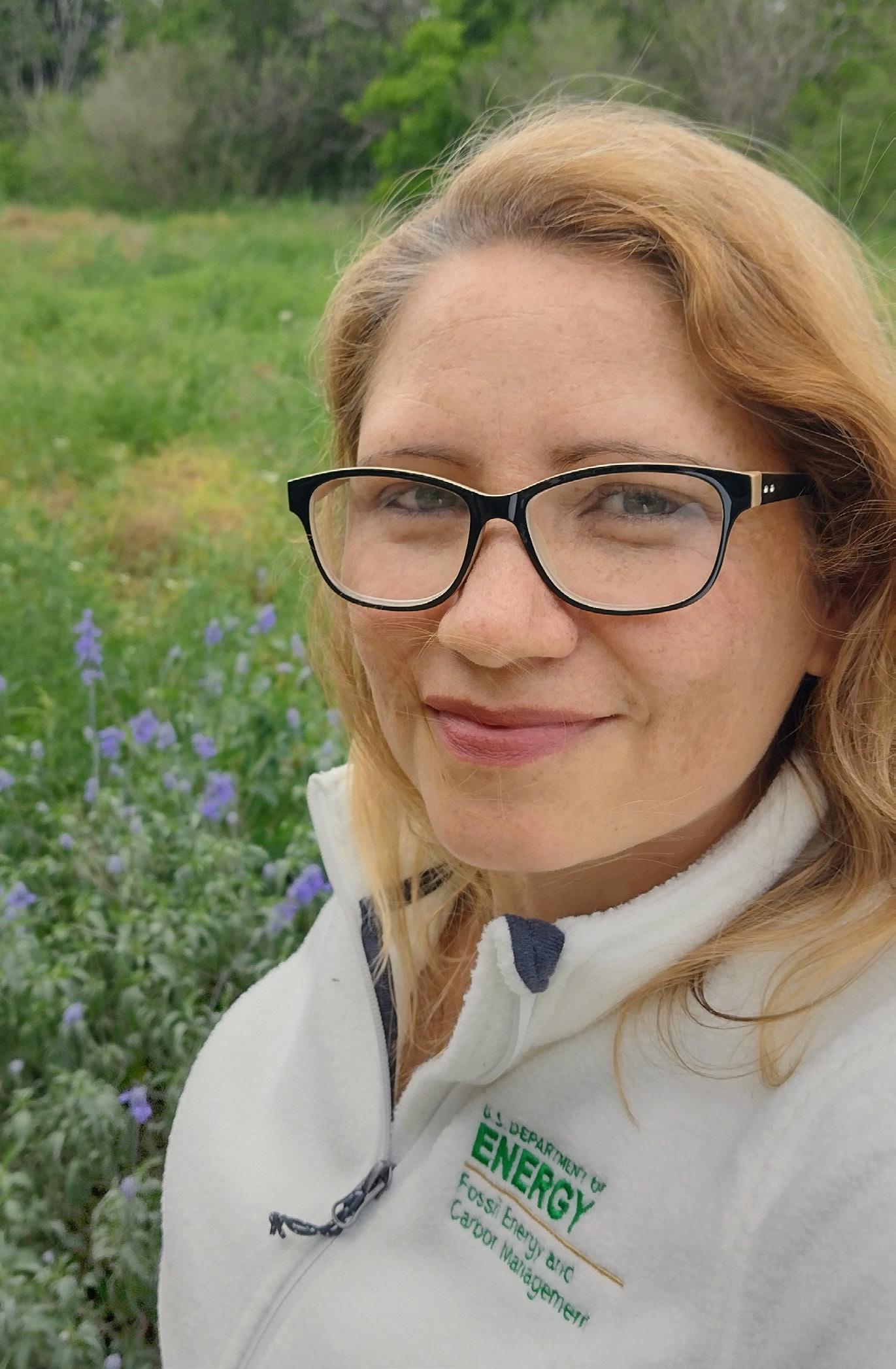
We also expect to fund novel systems/ processes and treatment trains. These can incorporate existing technologies but will be reconfigured and optimised for novel end-uses, primarily fit-for-purpose reuse and critical mineral recovery.
In addition, we are looking at characterisation methods, techniques, and technologies that can better detect contaminants of concern and “known unknown” contaminants that exist in the water but have not been identified.
What are the major challenges developers of these technologies face?
Many of the technologies for treatment and management are quite effective to meet current industry needs and comply with existing regulations, whether it’s treating produced water for Class II injection or treating power plant effluent for disposal in ash ponds.
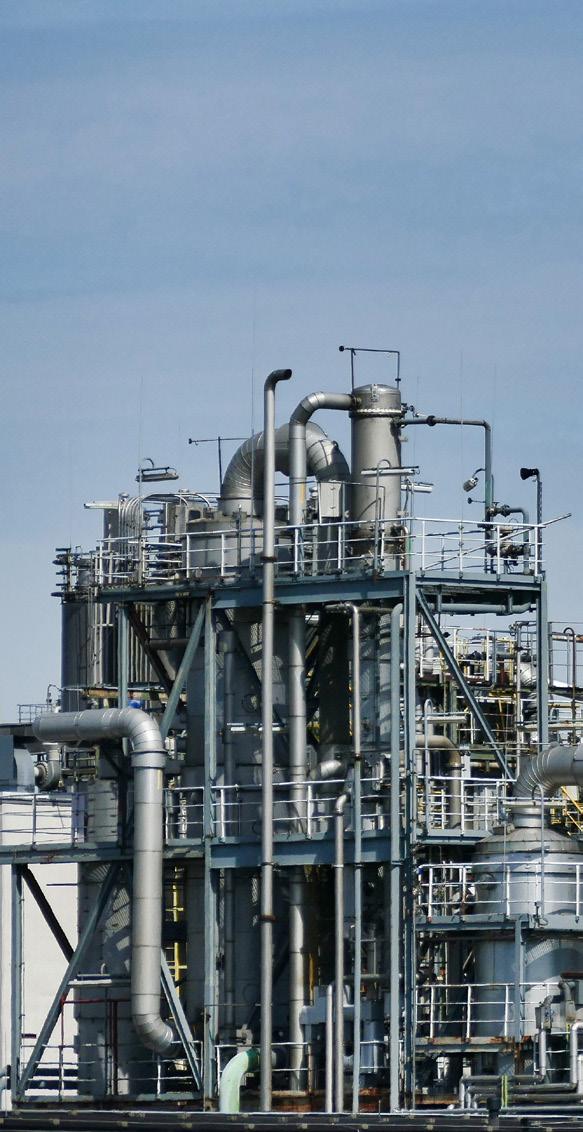
However, new challenges are arising, such as emerging contaminants of concern
and induced seismicity, or minor earthquakes triggered by underground injection of produced water. New regulations, such as limits on injection and effluent limitation guidelines, require operators and water managers to develop alternative management strategies that may not be adequately addressed by state-of-the-art technologies.
Treating and managing these wastewaters for beneficial reuse outside of fossil energy activities is becoming an attractive alternative, especially for produced water operators. However, there are additional challenges, especially if reuse leads to direct/indirect exposure pathways to humans, animals, and the environment.
There will be several of these “known unknown” contaminants that will need to be identified, as well as contaminants of emerging concern. Analysing for these contaminants, understanding their toxicity and impacts on health and the environment, and developing standards may be a challenge. DOE can support this need by developing and optimising treatment trains/configurations to detect and treat these contaminants in a cost-effective and energy-efficient way.
Mitigating the risks of fit-for-purpose reuse while optimising cost and efficacy is a major priority.
How is legacy wastewater associated with coal-based thermal electric pow-
er generation facilities currently managed, and how do you see this changing in the future?
The current state-of-the-art includes physio-chemical and biological treatment systems and disposal in ash ponds. Many coal power plants were able to purchase such upgraded treatment systems to meet the requirement for the 2020 version of the U.S. Environmental Protection Agency (EPA) Effluent Limitation Guidelines (ELGs).
New EPA ELGs were released in January 2023, which will likely require more advanced treatment systems/treatment trains.
"We expect to fund technologies that can remove total dissolved solids effectively and economically and also remove emerging contaminants"
Produced water can be an alternative source for other industries and users, or be used to recover critical minerals and rare earths
DOE
To what extent do you think there is a market for the recovery of rare earth elements, critical minerals, and elements of interest from these waste streams?
There is renewed industry interest in critical mineral recovery from these waste streams, specially produced water. The scarcity of critical minerals and reliance on foreign supply means that domestic sources are in high demand. Critical mineral recovery within existing produced operations can be a technologically and economically attractive option for operators and will help offset the costs of treating produced water, depending
on mineral composition. Currently, slip streams for recovering critical minerals are being incorporated into existing produced water management operations for development and testing.
Do you think there is potential for using the wastewater treatment and resource recovery technologies developed in other applications outside the fossil fuel energy sector?
Yes, especially in desalination, industrial wastewater management, and recycling and reuse of municipal wastewater. Moreover, these technologies can help facilitate
decarbonisation, such as by providing an alternative source of water for hydrogen, especially in drought-prone areas, or supporting brine management for carbon capture, utilization, and storage.

Information gleaned from research and development about emerging contaminants will be of high value to other wastewater sectors, both in terms of information on specific contaminants, as well as on the development of methods to identify new ones.
What would be the overall economic and environmental benefits of the technologies developed?
Improved characterisation and identification of safe, fit-for-purpose reuse applications will help mitigate impacts on water supply, especially in water-scarce parts of the nation that are seeing steady population and economic growth. Economic activities and population demands cannot be sustained in absence of available water. Treated produced water can be a plentiful source of alternative water in regions with limited water resources.
The technologies, processes, and methods developed will also mitigate the impacts of induced seismicity, as more produced water will be treated, and less produced water will be disposed of through injection into the deep subsurface.
Critical mineral recovery from produced water will help with the transition to a clean energy/decarbonised economy and offset the costs of produced water treatment.
Characterisation and optimised treatment will also help mitigate the effects of and prevent unintended consequences associated with emerging contaminants, especially with regard to health and the environment.
The technologies/processes will also help accelerate the transition to reuse and improve overall circularity and reduce greenhouse gas emissions and lessen our dependence on other countries for critical minerals production and processing.

The Muharraq WWTP started operating in 2014 and is currently operating at its maximum design capacity of 100,000 m3/day. Almar Water Solutions has brought to the project, and the region, the capacity to develop the future expansion of Muharraq – the plant has an expansion plan of an extra 60,000 m3/day – or any other water projects under PPP schemes.
According to a study by the World Resources Institute, the Kingdom of Bahrain is among the 17 countries facing extremely high-water stress. Bahrain is ranked 12th on the list, which Qatar tops.
Climate change will exacerbate an already unsustainable situation. Direct threats include rising sea levels, lower precipitation, and higher temperatures. Sea level rise is expected to lead to seawater intrusion into groundwater. Lower rainfall could lead to lower groundwater recharge rates. Higher temperatures could lead to unsustainable groundwater levels and desalinated water use by agriculture, households, and industries.
It’s worth mentioning that, as of August 2016, groundwater was no longer used in blending and was instead saved as a strategic reserve to be used exclusively in crises and disasters.
The Electricity & Water Conservation Directorate was established in 1999 to en-
able the sustainability of primary resources through electricity and water conservation. Besides, Bahrain’s modernization program, underpinned by new infrastructure projects and the development of large industrial zones, aims to rebalance the economy away from energy production and shift the focus towards tourism, hospitality, retail, real estate, finance, infrastructure, and oil and gas services.
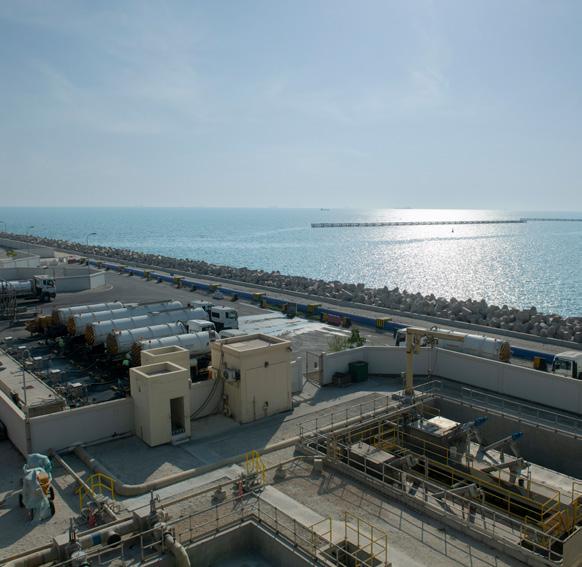
The Muharraq project is a 100,000 m3/ day state-of-the-art wastewater treatment plant with a sewer conveyance system in the Muharraq catchment area. The conveyance system includes the Gulf Cooperation Council (GCC) region’s first 16.5 km deep gravity sewer trunk pipeline and a wastewater collection network.
The concession was signed in 2011 by the Ministry of Works with a 29-year (until 2 April 2040) BOO and BOOT concession that included design and construction, financing, operation and maintenance, and transfer. The facility’s operation began in 2014, and Almar Water Solutions acquired 35% of this project in 2019.
During the design stage, all teams worked closely with the EPC contractor’s procurement team to review the design from an operations perspective to ensure
that materials procured for the facilities will optimize the life cycle cost and that these costs will be kept at a minimum throughout the concession period.
Before Muharraq, in the Kingdom of Bahrain, there was only the Tubli wastewater plant on the main island, where the capital Manama is located. However, due to population and urban growth, it was decided that the island of Muharraq should have its own wastewater plant.
When the plant started operating in 2014, it received around 72,000 cubic metres of daily water for treatment. However, following the 2018-2019 ur-
The Muharraq project is a 100,000 m3/day state-of-theart wastewater treatment plant with a sewer conveyance system in Bahrain
ban development and airport expansion, the plant began operating at its maximum design capacity of 100,000 m3/day.
The Muharraq wastewater plant is unique in the region for its sanitation, treatment, and reuse capacity for irrigation, industrial purposes, and urban cleaning. Another possible future application of the plant is the recharge of aquifers to expand the country’s natural water resources. This application is under study but would guarantee an increase in freshwater reserves.
This plant is also unique because Muharraq is the only wastewater treatment plant in the Kingdom developed under a public-private partnership (PPP) scheme.

It is now managed by two international companies of high prestige in the water sector: Samsung Engineering Company Limited and Almar Water Solutions.

The contribution of Almar Water Solutions to the project
Muharraq wastewater treatment plant has an expansion plan of an extra 60,000 m3/day. The plant’s location already provides space for this expansion easily
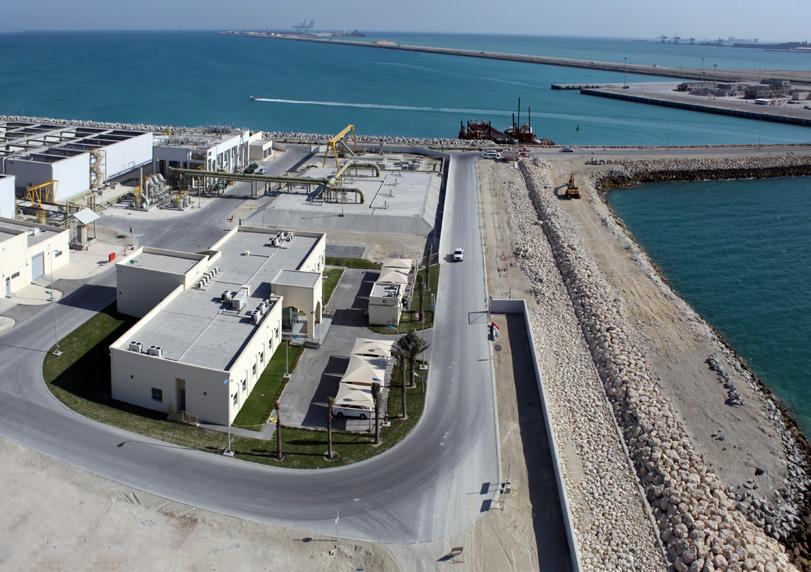
without making significant investments or modifications.
Almar Water Solutions is a specialist in project finance contracts and a sustainable infrastructure developer with a


Muharraq is the only wastewater treatment plant in the Kingdom developed under a public-private partnership (PPP) schemeALMAR WATER SOLUTIONS
presence on five continents. The company has brought to the project, and the region, the capacity to develop the future expansion of Muharraq or any other water projects under PPP schemes.
The facility employs around 70 people, including the SPV and the operation and maintenance team. The project has highly qualified staff and a certified laboratory for water quality studies.

A separate sewerage basin serves the approximately 260,000 people on Muharraq Island in the Kingdom of Bahrain. All wastewater flows to the Muharraq plant, which has a treatment capacity of 100,000 m3/day. The catchment is predominantly domestic but also serves several hospitals and Bahrain International Airport.
The conventional sewage treatment process has three stages with a separate sludge treatment stream. The residual sludge is incinerated in the sludge incineration plant. The wastewater treatment stream consists of a preliminary treatment of screening and grit removal, a secondary treatment of biological treatment and a tertiary treatment of solids removal and disinfection.
The primary treatment includes coarse screening, fine screening, and grit removal using aerated grit channels. After this, the secondary treatment includes filing, reaction, settling, decanting, idling, and sludge wasting. Finally, in the tertiary treatment, we find disc filters and ultraviolet disinfection to disrupt DNA, re-
sulting in bacteria becoming non-viable. After these phases, Muharraq obtains ultra-clean water to be disposed of at sea in perfect conditions, incinerating the residual dried sludge, and part of the water is reused for different purposes.
The plant uses tertiary treatment to recycle part of the treated used water into clean high-grade reclaimed water. After
treatment to achieve clean water quality, the resulting water is piped for use in new urban developments, irrigation, and industry.
The plant is located off Prince Khalifah Bin Salman Causeway on a newly re-
Almar Water Solutions has brought the capacity to develop the future expansion of Muharraq or any other water projects under PPP schemes
claimed island away from population areas. The Muharraq wastewater treatment plant contributes to the environment by treating and cleaning wastewater from the entire city. The plant removes all pollution, resulting in clean water that can be returned to the environment or reused.
The significant contribution of this project in terms of environmental impact
is the incineration of sludge, which is a problem for the Muharraq peninsula. This process reduces the volume of waste by 3.5 times, avoiding the problem of landfill storage, which is much more polluting.
The effluent from the sewage treatment plant complies with international environmental standards, and was designed to be reused, such as for unre-
stricted irrigation, reducing pressure on water resources.
A Community Liaison Officer has been appointed to address community interests and concerns during construction. An independent environmental consultant – PH Environment Gulf – has been appointed to regularly visit and monitor construction works and the operational site to ensure environmental mitigation measures are implemented and maintained. The following measures address environmental issues:
J Air quality: emissions from sludge incinerators comply with European best practice standards.
J Odour: the plant incorporates odour monitoring and control systems.

J Water quality: treated sewage effluent was designed to be used for irrigation. The discharge complies with both contractual and Bahraini environmental standards. Sewers are designed to minimize the impact on groundwater resources.
Committed to the health and well-being of the citizens of Muharraq, and the rest of the Kingdom of Bahrain, Muharraq has actions and activities that benefit the population.
In 2022, Muharraq participated in a study on SARS-CoV-2 with wastewater samples taken from the wastewater treatment plant. The wastewater analysis defined that the circulation of SARSCoV-2 in a specific population could be predicted or confirmed.
Source: Electricity and Water Authority (EWA)
The contribution of this project in terms of environmental impact is the incineration of sludge, a problem for the Muharraq peninsula
ALMAR WATER SOLUTIONSCOORDINATOR OF THE EUROPEAN DARROW PROJECT
Water passing through treatment plants used to be considered waste to be discharged into rivers and seas. Its organic matter was a residue, and the nitrogen and phosphorus it contained were pollutants. Perceptions have shifted. With the right technology and infrastructure, it is possible to turn these elements into energy (biogas) and fertilisers for agriculture, in line with the European Union’s commitment to a circular economy.
According to Eurostat data, components of wastewater could supply 13% of the demand for fertilisers and generate electricity for 25 million households per year in the European Union.
To drive that transformation, the European DARROW project is developing artificial intelligence (AI) tools to reduce the energy cost of water treatment plants and to help the people who operate them make decisions. For World Water Day we spoke to Ion Irizar, project coordinator and CEIT researcher, about how
people-centred AI will transform water treatment and resource recovery in Europe over the next decade.
Wastewater is no longer perceived as waste but as a resource, yet few European facilities are applying this circular economy concept. Why?
The European Union is committed to aligning its industrial sectors with circular economy principles, decoupling economic growth from the use of more and more resources and the waste production. However, water treatment infrastructure is meant to last several decades, so transforming existing facilities into resource recovery plants is neither quick nor easy.
So how can Europe accelerate the evolution of water treatment plants into water resource recovery plants?
Plants must undergo two major transformations. They must harness new infra-
structure, technologies, and microorganisms to recover nutrients such as nitrogen and phosphorus from water and reuse them in agriculture That means redesigning existing facilities, and it will take time. But plants have been trying to reduce their energy consumption for years. Their operative costs are paid by taxpayers, so reducing energy consumption will benefit everybody. The latter point can be achieved faster than the former, and that is where data and AI come in.
How can Artificial Intelligence help to reduce plant costs and improve plant autonomy?
Large water treatment plants will never be 100% autonomous, and technological tools are not there to replace the plant’s operating staff, but to help them. Having said this: in the last decade, automatic corrective control systems have been introduced that have helped to reduce energy consumption, but machine learning or AI tools will go much further. For example, by incorporating predictive aspects to help anticipate decision-making.
Why is it important to improve aeration control?
Aeration accounts for most of the energy consumption of treatment plants.
"Water treatment plants are meant to last decades, so transforming existing ones into resource recovery plants is neither quick nor easy"Z Gloria Pallares is a freelance writer specialising in global development and the environment

The composition of the water changes throughout the day — there are many more people and industries using water in the morning than in the middle of the night — so plant operators must frequently adjust the amount of air supplied to water tanks. That is a tricky business: too much air, and energy costs soar; too little, and you kill the bacteria, which are essential for the entire process.
The DARROW project is developing systems that learn to identify the right amount of air depending on the composition of the water, so it can be treated using as little energy as possible before being discharged into rivers or the sea. Those systems will be able to recommend the right level of aeration based on data about the quality of the water.
What are the other applications of AI in water treatment?
AI can help detect problems on sensors that are essential for critical control systems. Water treatment plants are harsh environments for sensors and cause them to fail more often than usual. One way to address the problem is through redundant sensors — if one fails, you have backups — but this is not cost-effective in that type of facility. AI offers an alternative: we can train the system to detect when a sensor is giving erroneous readings, so that control systems go into safe operation mode. Our project is also working on that.
A central focus of your project is to build trust in the AI tools you are going to develop. Why is trust important?
Artificial Intelligence is like an automatic gearbox: it makes driving easier, but there is always a person behind the wheel. Our goal is to develop AI solutions that help plant operators and allow them to spend more of their time on tasks with a higher added value, such as supervising controllers. But we can only implement AI tools if operators understand how we have designed them, how they work, and what underpins their recommendations.
And how will you build trust in your AI solutions?
The idea is to develop AI tools in a very transparent way, clearly explaining to
operators how we are designing the solutions and checking whether they meet their needs. In addition, our AI tools will not only make recommendations, but will also try to justify them.
Your experience in the water treatment industry spans more than 20 years. How do you see the future of water

"The DARROW project is developing systems to recommend the right level of aeration based on data about the quality of the water"
Wastewater facilities have been trying to reduce their energy consumption for years, and that is where data and AI come in
Advancing towards plants with high levels of digitisation and AI calls for technological advances and cheaper sensors, which only large treatment plants can currently afford. That would also help to reduce the technological gap between urban and rural treatment
plants. In European countries, around 5% of the plants treat 80% of the water: it makes sense to start implementing the principles of circular economy in these large plants, but we mustn’t forget the small ones. In fact, we are working to ensure that some of our AI developments can also be applied to small plants in the future.

"We can train the system to detect when a sensor is giving erroneous readings, so that control systems go into safe operation mode"
Known as the “forever chemicals,” the presence of PFAS in water and food has raised the concerns of health and environmental authorities, who are already working to build a solid regulatory framework, while advancing knowledge about their risks.
Per- and polyfluoroalkyl substances, better known as PFAS, are a group of synthetic chemicals that, due to their thermal resistance and stability, have been used for different industrial and consumer applications since the 1940s.

Their chemical characteristics – ideal, for example, for the manufacture of waterand oil-repellent products – means they are persistent and bioaccumulate in food chains, something that has raised the concerns of health and environmental authorities. Exposure to them through drinking water and food, and knowledge about their toxicity to the environment and health have led in the last decade to accelerated measures to curb their use.
As far as water is concerned, PFAS can reach it in several ways: through improper disposal in the form of spills and/or waste containing PFAS, direct release into the air or water when they are used,
or firefighting foams. In addition, upon release, they may infiltrate into the soil and eventually reach groundwater aquifers, where they can persist for many years, as they are resistant to degradation and they can adhere to sediments. Thus, the presence of PFAS in groundwater is a major concern, as there is a high likelihood that such water will be withdrawn for agricultural or other uses and eventually consumed by humans.
In Europe and the UK, a mapping project carried out in February 2023 by The Guardian and Watershed with data obtained from water companies and the Environment Agency revealed high concentrations, of more than 1,000 nanograms per litre of water at approximately 640 sites and above 10,000 ng/l at 300 locations. The map shows Belgium is home to the highest levels of pollution, where PFAS were found in groundwater in concentrations of up to 73 million ng/l near a PFAS manufacturing site. The map also shows that drinking water sources in the UK have been contaminated, yet water companies say that a specialised treatment process is used to remove PFAS so that they do not end up in tap water.
In this regard, PFAS risk management in drinking water is a complex issue involving multiple stakeholders, especially the industrial sector, including water companies, which are already taking steps to minimise the risks associated with a relatively new regulatory framework for PFAS.
The World Health Organization (WHO) classifies perfluorooctane sulfonate (PFOS) and perfluorooctanoic acid (PFOA) as suspected carcinogens, suspected reprotoxic and harmful to vulnerable populations. In addition, the Strategic Approach to International Chemicals Management (SAICM), a policy framework to promote chemical safety world-
wide that is part of the UN Environment Programme, considers them as emerging contaminants.
However, the global regulatory framework to control PFAS is still under construction. While the regulations that have been implemented in the last decade, especially in the United States and Europe, are increasingly committed and strict, there is still a long way to go.
Thus, these compounds were included in 2009 in the list of restricted chemicals of the Stockholm Convention on Persistent Organic Pollutants, but it was not until 2016, in a review of the Review Committee of this convention, that a consensus was reached stating that PFOA could cause significant adverse effects on human health and the environment.
The United States was a pioneer in 2012 in including PFASs and PFOS among the contaminants to be monitored in water systems, as well as establishing a PFAS Strategic Roadmap through the Environmental Protection Agency (EPA) in 2021. In addition, the Biden-Harris Administration proposed the first national drinking water standard for six per- and polyfluoroalkyl substances in 2023, a major step forward to protect the public health of Americans. On top of this, the EPA announced $2 billion from the Bipartisan Infrastructure Law to address emerging contaminants in drinking water across the country, including PFAS.
While chemicals are essential to the well-being and comfort of modern society, many of them have hazardous

Water utilities are already taking steps to minimise the risks associated with PFAS with a relatively new regulatory frameworkPFAS RISK IN DRINKING WATER
properties that can damage the environment and human health. This is why the European Commission published the Chemicals Strategy for Sustainability in 2020, in line with the objectives of the European Green Deal, which aims to better protect citizens and the environment and drive innovation for safe and sustainable chemicals. This includes phasing out the use of PFAS in the EU, “unless proven essential for society”.
From it derived a Restrictions Roadmap, published in April 2022, to prioritise these substances for restrictions under the Regulation on the Registration, Evaluation, Authorisation and Restriction of Chemicals (REACH). “We have come a long way regulating chemicals in the EU. But the ambition of our European Green Deal is that we all live in a truly toxic-free environment. We cannot afford to expose our health and our nature to harmful chemicals,” Virginijus Sinkevičius, European Com-
missioner for Environment, Oceans and Fisheries, said at the time.
In addition, Directive (EU) 2020/2184 of the European Parliament and of the Council of 16 December 2020 on the quality of water intended for human consumption establishes values and measures concerning PFAS, binding for Member States, to be implemented by January 2026 to ensure that water intended for human consumption complies with the parametric values, 0.50 μg/l for the totality of per- and polyfluoroalkyl substances, and 0.10 μg/l for the sum of these same substances considered a concern as regards water intended for human consumption, listed in its Annex III. However, Member States are free to introduce stricter legislation at the national level.
It should be noted that this is in addition to regulations from food safety authorities, such as the European Food Safety Authority (EFSA), which establishes a safety threshold for the main types of PFAS that accumulate in the body.
Thus, the growing concern about the negative effects of PFAS on both public health and the environment is leading more and more countries around the world to adopt measures to regulate these substances in water, although there is neither a consensus on what levels are dangerous for the population nor corresponding legislation. According to

Medical News Today, in some regions of the world, such as Asia, restrictions have not yet been imposed.
There is, however, a draft background document for the development of WHO Guidelines for drinking water quality. Although the process of developing guideline values is still ongoing, the WHO advises its Member States to: (i) strive to achieve concentrations in drinking water that are as low as reasonably practical; (ii) minimise contamination of water sources, including preventing new sources of contamination; (iii) stop nonessential uses of PFAS; and
One of the main strategies used to reduce PFAS exposure in drinking water is through various water treatment processes
Regulations are taking an increasingly rigorous approach, particularly in the U.S. and Europe, but there is still some way to go
(iv) balance the risks from PFAS with other risks in the water supply, including not having adequate supplies of drinking water.

Exposure to PFAS through drinking water has become a major concern for the water industry. The difficulties of dealing with PFAS stem from the fate and prevalence of these substances, so it requires a holistic approach that includes research, characterisation, analysis, testing and technology development.
Thus, not only is it important for environmental authorities and companies involved to identify and eliminate the sources of PFAS contamination, but it is also key to research what are the best ways to address the risk from PFAS in water and develop new treatment methods. “The water sector must be aware of this issue and be proactive about it,” noted Isle Utilities’ chairman Dr Piers Clark in a January 2021 webinar organised by the Water Action Platform.
In this regard, one of the main strategies used to reduce PFAS exposure is through various water treatment pro-
cesses. Among the technologies that have been tested and have proven most effective are activated carbon, ion exchange, reverse osmosis, electrodialysis, photocatalysis and advanced oxidation, which are more or less efficient depending on the class, species and chain length of each PFAS substance.
Although the concern about PFAS risk management in drinking water is still recent and the technologies focused on it are still beginning, water companies have the willingness, commitment and knowledge necessary to address this new challenge.
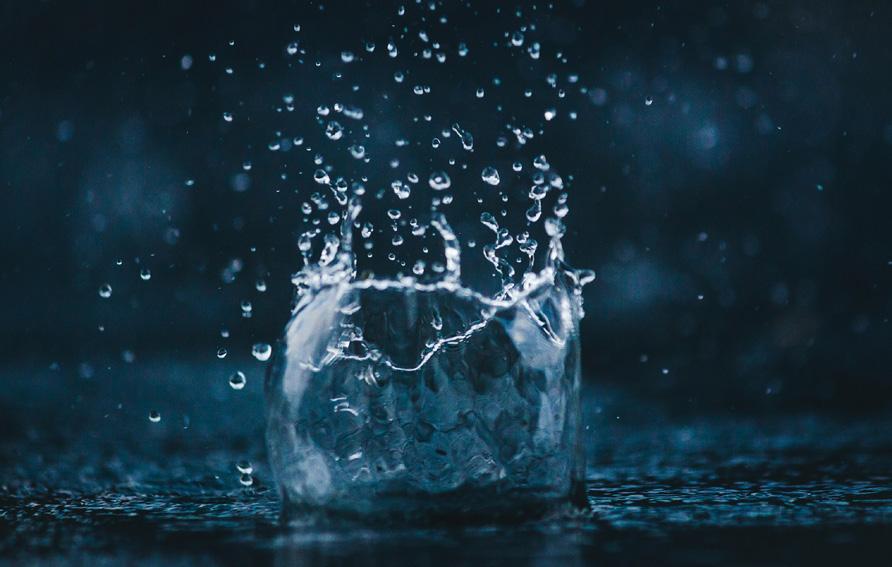
Nelum Perera, a graduate student in Piyasena’s lab at New Mexico Tech.
Barely visible microplastics — less than 5 mm wide — are potentially harmful to aquatic animals and plants, as well as humans. So, researchers are devising ways to remove them and stop them at their source. A team reports a twostage device made with steel tubes and pulsing sound waves that remove most of the plastic particles from real water samples. The researchers will present their results at the spring meeting of the American Chemical Society (ACS).
“The idea came from a discussion with a colleague who said that we need new ways to collect microplastics from water,” says Menake Piyasena, Ph.D., the project’s principal investigator. “Because acoustic forces can push particles together, I wondered if we could use them to aggregate microplastics in water, making the plastic easier to remove.”
Filtration is the most commonly used technique for removing these materials from water. For example, washing machine outlet filters can keep fibres that slough off clothes during washing from entering wastewater. But this method can be costly on a large scale, requiring regular cleaning of the filters, which can get clogged.
Another option could be concentrating plastic particles in flowing water with acoustic forces, or sound waves, that transfer energy to nearby particles, causing some of them to vibrate and move. Recently, some teams have applied this approach to the separation of microplastics from samples they prepared in the lab with pure water. But this work was done with tiny volumes of water and microplastics that were only tens of microns wide, explains
“I read that most of the microplastics in the environment are larger than that,” says Perera. “So, I wanted to develop a device that could be useful for most of the sizes and could be scaled up to meet real-world goals.” To show that the two-stage system could work for real-world applications, Perera and Piyasena collected water from a pond on the New Mexico Tech campus and from the Rio Grande River. They filtered all of the samples to remove large contaminants, leaving water that still contained dissolved substances that could have affected the separation. Next, they spiked the water with microplastics. When the environmental water samples went through the acoustics device, plastic particles were removed as effectively as from pure water. With this prototype, Perera estimates it would cost around 7 cents to operate the current device for an hour and take around an hour and a half to clean one litre of water.
The team’s next step is to develop a system with wider tubes, or bundles of multiple tubes, and to try it on unspiked real-world samples, including ocean water and wastewater from washing machines. “We have shown that acoustic forces can be used to concentrate a wide range of microplastic sizes,” says Piyasena. “And from here, we want to prove that this can be done on a larger scale with real samples that already have microplastics in them.”
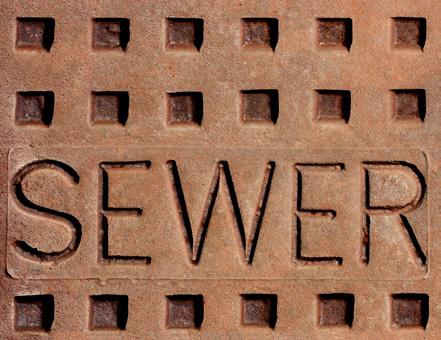
In Nice, Christian Estrosi, Mayor of Nice, President of the Métropole Nice Côte d’Azur and Deputy President of the Région Provence-Alpes-Côte d’Azur and Sabrina Soussan, Chairman and CEO of SUEZ, presented the future, next-generation wastewater recovery and treatment complex for the Métropole Nice Côte d’Azur: Haliotis 2, the largest project in France and one of the largest in Europe.
Representing a market of €700 million, the new plant will meet future envi-
ronmental and health standards, as well as the future needs of the community. It will treat the wastewater of 26 municipalities, representing 680,000 residents.
Haliotis 2 will be a true European hub for advanced technologies working toward the ecological transition to treat and reuse wastewater, eliminate all types of pollutants including microplastics, treat sewage sludge and sand, and improve air quality, all while generating new renewable energy sources (biomethane, solar, heat and cold for buildings).
Reducing discharges of untreated wastewater could reduce global methane emissions by up to 5 to 10% according to researchers
Research published in Environmental Research Letters has shown that methane emissions from cities are underestimated by a factor of 3 to 4 and that untreated wastewater may be a contributing factor.
The study, “Investigating high methane emissions from urban areas detected by TROPOMI and their association with untreated wastewater,” was led by Benjamin de Foy, professor of Earth and Atmospheric Sciences at Saint Louis University.
The researchers found that methane emissions from the discharge of untreat-
ed wastewater are a major contributor to global methane emissions and that improving wastewater treatment in urban areas could lead to a significant reduction in greenhouse gas emissions by global cities.
One method of evaluating methane emission is via satellite remote sensing, for example, with the TROPOspheric Monitoring Instrument (TROPOMI) on board the Sentinel 5 Precursor satellite. The research shows that methane emissions from urban areas may be underestimated by a factor of 3 to 4 in
The water treatment performance of Haliotis 2 will exceed sanitary standards with nearly 90% of microplastics being eliminated by the plant. It will have an industrial unit for the reuse of treated wastewater capable of recycling 5 million m3 of water per year, enough to water the green spaces and clean the roads of the city of Nice.

The project also aims to create a remarkable urban-rural hybrid landscape at the entrance of the city with 4.5 hectares of biodiversity composed of 600 trees, colourful hedges, and shrubs.
the Emissions Database for Global Atmospheric Research (EDGAR) greenhouse gas emission inventory. The study scaled the results to 385 urban areas worldwide with more than two million inhabitants each, suggesting that they could account for up to 22 per cent of global methane emissions.
The researchers’ model points to untreated wastewater rather than other options, including natural gas leaks or older infrastructure, as a large share of overall methane emissions.

The per- and polyfluoroalkyl substances (PFAS) that resist heat, fire, stains, grease, and water have widespread use in everything from nonstick pans to firefighting foam. Unfortunately, widespread use has led to widespread pollution, which seriously endangers public health.
The carbon-fluorine (C-F) bond of PFAS is the strongest one in organic chemistry and doesn’t break down naturally, which is why they are called “forever chemicals.” They could just as aptly be called “everywhere chemicals” because they are found in water, soil, and air globally.
People are exposed by consuming water or food, using products, or breathing air contaminated with the persistent organic pollutants, which accumulate in the body. The Centers for Disease Control and Prevention (CDC) reported that PFAS were found in the blood of 97% of Americans. That’s concerning because the National Institutes of Health (NIH) has linked PFAS to an increased risk of obesity and some cancers, reduced fertility and fetal growth, and weakened immunity.
These persistent chemicals are highly soluble. A 2022 analysis of drinking water from 41 cities in 15 countries detected PFAS in every sample. Industrial wastewater has been targeted as a major source of PFAS pollution. The Environmental Working Group (EWG) created a map of 41,828 U.S. industrial and municipal sites that are “suspected of making, using or releasing PFAS.”
If untreated, industrial sites send PFAS downstream to wastewater treatment plants that are often unprepared to effectively treat it. Conventional wastewater treatment solutions typically capture toxins in filters and then incinerate the filter media, which only breaks down long-chain PFAS compounds into small-chain ones. Other traditional solutions include putting the spent filters in landfills where the PFAS show up in runoff. That is likely why a correlation has been found
between the number of wastewater treatment plants within a watershed and PFAS concentrations in public water supplies. PFAS remediation is in its infancy and has unique challenges. Most tests detect fewer than 40 PFAS compounds and testing technology is not keeping pace with the growing list of regulated compounds. There are a number of methods to filter PFAS from wastewater, with reverse osmosis, foam fractionation, ion resins, and granulated activated carbon being the most common. Reverse osmosis is considered one of the most effective methods, but high capital expenses compounded by high energy costs have prevented widespread adoption.
Once filtered, the vexing problem of PFAS is only concentrated, not destroyed. Filters and liquid concentrates laden with PFAS are often sent to landfills or incinerated. However, both methods are likely to be outlawed soon, because they lead to re-contamination. Innovative technologies such as the ones developed and incubated at the University of Minnesota and commercialized by Claros Technologies could destroy PFAS in wastewater and allow for the safe reuse of water.
The first step is comprehensive testing that utilizes compound-specific and class-based methods. Claros Technologies is one of only three accredited U.S. labs that can detect short- and ultrashort-chain PFAS. The second step is PFAS capture and concentration. This new method can be used alone or with existing systems to filter millions of gallons of water to make a few gallons of PFAS concentrate. The final step is permanent destruction through defluorination. Proprietary technology called the Elemental uses a photochemical process to break the C-F bond.
This comprehensive PFAS-remediation strategy allows for the safe reuse of wastewater and safeguards human and environmental health. These new approaches and technologies can help industries show exemplary leadership and stewardship in the movement toward a circular economy.
The methods to filter PFAS from wastewater include reverse osmosis, foam fractionation, ion resins, and granulated activated carbon
Environmental Governance is a continuing challenge for the water industry as water and wastewater utilities around the world focus on their strategies and actions to support the sustainable development goals (SDGs) and work to maintain their social licence to operate.
In terms of Environmental, Social and Governance (ESG) obligations, water utilities are frequently less likely to be challenged by the Social and Governance components of their responsibilities than they are in their response to the Environmental component. While this may at first glance appear to be an outrageous statement, the consideration of civic and employee responsibilities such as community relations, health and well-being, gender and diversity inclusiveness etc is something that every utility recognises as a critical component of their business. Similarly, good governance incorporating an effective board, appropriate probity and best practices in procurement, hiring and decision-making are essential to the success of any organisation.
Environmental Governance, on the other hand, is a continuing challenge for the water industry as water and wastewater utilities around the world focus on their strategies and actions to support the sustainable development goals (SDGs) and work to maintain their social licence to operate.
Unlike mining, manufacturing and the oil and gas sectors, water utilities provide an essential service and are required to constantly deal with environmental
challenges specific to their regions. These include local water sources, terrain, weather and of course their end-users who require safe and reliable water delivery and wastewater service irrespective of the conditions.
There are numerous initiatives in place including:
J Net zero emissions (including carbon and other greenhouse gas releases).
J Energy self-sufficient treatment plants (using renewable energy through solar, mini-hydro, biogas generation, cogeneration and wind).
J Reducing non-revenue water (NRW).
J Reducing air pollution and odour.
J Recovering nutrients from wastewater.
Much of the attention on environmental governance focuses on those assets critical to water supply and treatment and the performance of wastewater treatment plants.
However, one of the most frequently overlooked assets is the sewer network where the environmental impact can be significant. In particular, the risk of methane generation in sewer networks including lineal infrastructure such as pumping stations, and its consequential contribution to climate change is often under-valued and poorly understood.
In recent times, issues related to sewer networks have been primarily about asset management, odour, corrosion and safety issues. In May 2022, the Water Services Association of Australia (WSAA) made available for public comment its Guidelines for Potentially Explosive Atmospheres, a guideline for the man-
agement of explosive atmospheres in wastewater infrastructures. While not specifically focussing on the environmental risks associated with methane gas and nitrous oxide emissions from networks, there is no doubt that from an environmental governance perspective, the management of fugitive gas
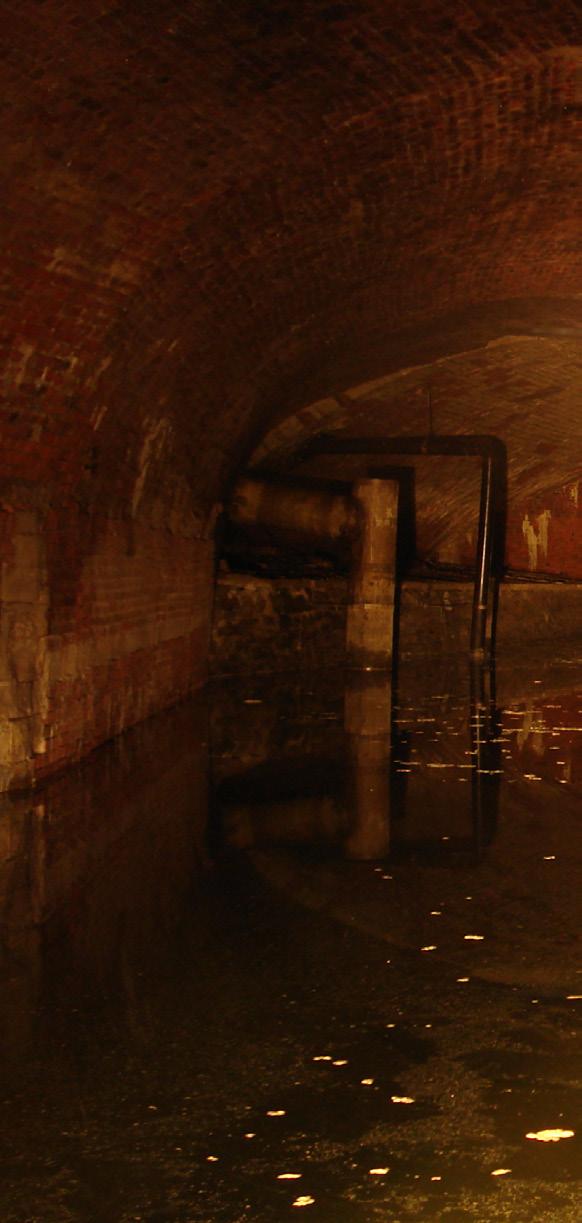
Utilities recognise civic and employee responsibilities such as community relations, health and well-being, etc. as critical for their businessZ COnTribuTeD by sabina TODD, apaC reGiOnal General manaGer & viCe presiDenT aT envirOsuiTe
emissions from network systems is a significant greenhouse issue.
It is over ten years since the Urban Water Security Research Alliance, a partnership between the Queensland Government, the CSIRO, Griffith University and the University of Queensland published a Technical Report on Energy and

effective ways to measure and minimise greenhouse gas emissions from their sewer networks including ways to better understand the carbon footprint of their sewer networks and safety risks associated with those emissions.
Envirosuite’s SeweX, an advanced mathematical modelling tool describing the physical, chemical and biological processes in sewers, can model and predict with great accuracy where methane will be potentially generated.

Corrosion, odour and safety issues related to sulphide and methane are often only discovered after costly asset failure. Network monitoring using SeweX as a proactive management tool will help utilities understand and respond to issues more rapidly and effectively and assess potential treatment options.
The first step to managing Environmental Governance is having the information at hand to understand the entity’s impact. SeweX is a tool to help water utilities understand the greenhouse gas impact from the sewer network and model mitigating solutions, providing greater certainty to decision-makers that investment is making meaningful change.
Greenhouse Gas Emissions in which it stated that diffuse greenhouse gas emissions are potentially much greater than energy use for the sector with the main sources being reservoirs and wastewater treatment and handling.
From an environmental governance context, utilities are seeking the most
One of the most frequently overlooked assets is the sewer network, where the environmental impact can be significant
Yorkshire
Cutting-edge technologies like artificial intelligence in industry and the Internet of Things (IoT) are helping to safeguard the high value of natural water systems by preventing them from pollution. A visual story.

Natural water systems carry a high value. They support a diverse ecosystem for flora and fauna; they keep people healthy by preventing water-borne diseases; and they protect and create tourism and recreation opportunities.
However, in cities all over the world –and particularly in older cities – stormwater runoff and household sewage are transported to water treatment plants in the same piping network. An advantage of these so-called combined sewage systems (CSS) is that runoff water, which could be polluted with oil, pesticides, fertilizer, and more, is purified before it is released into nature. That’s good news for the environment.
There is a downside, however: During heavy rainfall or snowmelt, a CSS piping network can be stretched to the limits and untreated water may escape into waterways via the combined sewer outlet (CSO). But the chances of this happening are greatly diminished when blockages in the CSO are removed in
Yorkshire Water, Sheffield University and Siemens Digital Industries joined forces to use AI and the IoT to reduce wastewater network blockages
time. Siemens, Yorkshire Water, and the University of Sheffield have joined forces to develop a system that employs artifi-
Cut pollution incidents by 50 per cent
The British water company Yorkshire Water operates 55,000 km of sewers. In times of intense rainfall, CSOs are designed to release excess water and sewage into rivers to prevent flooding in public areas. Of course, these incidents need to be kept to an absolute minimum. In the framework of Yorkshire Water’s Pollution Incident Reduction Plan 2020-2025, the goal is to cut pollution incidents by 50 per cent. The key to attaining this objective is to remove blockages in sewers and thereby minimize the probability of a release.
For some time now, over 1,500 sensors on CSOs have been monitoring sewage levels and issuing alerts when an overspill has happened. But wouldn’t it be better to know where blockages are most likely to occur so that debris can be removed before an overspill has a chance of developing? Until now, experts at Yorkshire Water have been trying to make predictions by evaluating data from the sensors with statistical methods, but that often led to false alarms and late detections.
The analytical challenge is how to account for the personal character of every CSO. Each one responds differently to rainfall, so it is difficult to know if the observed changes in level are normal or not. A number of factors come to play here, such as the design of the upstream and downstream network, or whether the area is hilly or flat, urban or rural.
Therefore, the utility took the bold step of replacing statistical methods with AI and IoT – an approach that has now been tested at over 2,000 CSOs and manholes across the region.

In cities all over the world, stormwater runoff and household sewage are transported to water treatment plants in the same piping network
cial intelligence (AI) and the Internet of Things (IoT) to locate blockages before overspills can occur.
The data from the sensors on the CSOs along with real-time information on rainfall is delivered to SIWA Blockage Predictor. This application – which runs on MindSphere, Siemens’ open, cloudbased IoT operating system – identifies anomalies in sewer system behaviour. Initially, an AI system was trained with sensor data to learn the normal behaviour of a CSO when it rains. Now, a new AI model has been trained for each site to learn its unique pattern of behaviour in response to rainfall. Fuzzy logic technology is then employed to automatically interpret the data to detect any significant differences in behaviour. When an issue is found, a response team at Yorkshire Water receives a notification to visit the asset and remove the blockage or forming blockage. Because SIWA Blockage Predictor is embedded within a web application, users can access it on mobile devices and PCs.
“Artificial intelligence is not magic. It requires experts in data science to come together with people who really understand the issue and engineers who can build software, connect the hardware, and knit together a solution that is secure against cyberattacks. This project is a textbook example of how all strands should come together,” says Adam Cartwright, head of IoT application delivery at Siemens.
in several ways Now deployed in 24/7 operations, SIWA Blockage Predictor gave up to two weeks advance notice of blockages – blockages that could have potentially led to undiluted effluent being released into the environment. What’s more, the predictor found nine in ten potential issues, which makes it three times more successful than the prediction processes that relied on statistical methods. Another boon to operations teams is an extremely low false alarm rate of just 3 per cent. That’s half the rate of the current statistics-method-based approach.
A challenge of building any new digital solution is the chance that it might be something customers don’t want or need. For that reason, involving clients in a co-creation process leads to better outcomes. Yorkshire Water was engaged in this project from the start of 2020.
The journey from idea to product began with a series of research projects between Yorkshire Water and the University of Sheffield. Over a number of years, the core analytics concept was proven on a sample of Yorkshire Water assets.
“By building a personalized fingerprint for the wastewater assets that reflects how the local network responds to rainfall and overlaying that on patterns of daily behaviour, we have been able to establish what each asset’s “normal” response is”, says Joby Boxall, professor of water infrastructure engineering at the University of Sheffield.

In times of intense rainfall, CSOs are designed to release excess water and sewage into rivers to prevent flooding in public areas
While the analytics worked, as an academic project it was not designed to be scalable nor secure, and it wasn’t optimised for easy daily use. When Siemens joined the project team, the data science knowledge was transferred and the university team took on a second important role – validating the effectiveness of how Siemens had developed the analytics and how this compared to the existing Yorkshire Water solution. After analysing 21,300 days of data, this independent analysis by the university further boosted Yorkshire Water’s confidence in this new tool.
The AI has also been advanced so it can work on new sensor installs and not have to wait for months of training data. The solution is now being piloted outside of the UK, including a solution for new sites that don’t already have a level sensor installed. Here, Siemens low-powered radar sensor Sitrans LR110 can be integrated into a remote terminal unit ready connected to MindSphere and SIWA Blockage Predictor saving time, cost and reducing risk. This simplified deployment puts digitalisation within the reach of every utility.

When an issue is found, a response team at Yorkshire Water receives a notification to visit the asset and remove the blockage

Non-revenue water (NRW) is water that is produced but is lost before it reaches the customer and is a persistent problem in worldwide municipal water systems. In England and Wales, approximately 3 billion litres of water are lost through leaks every day.
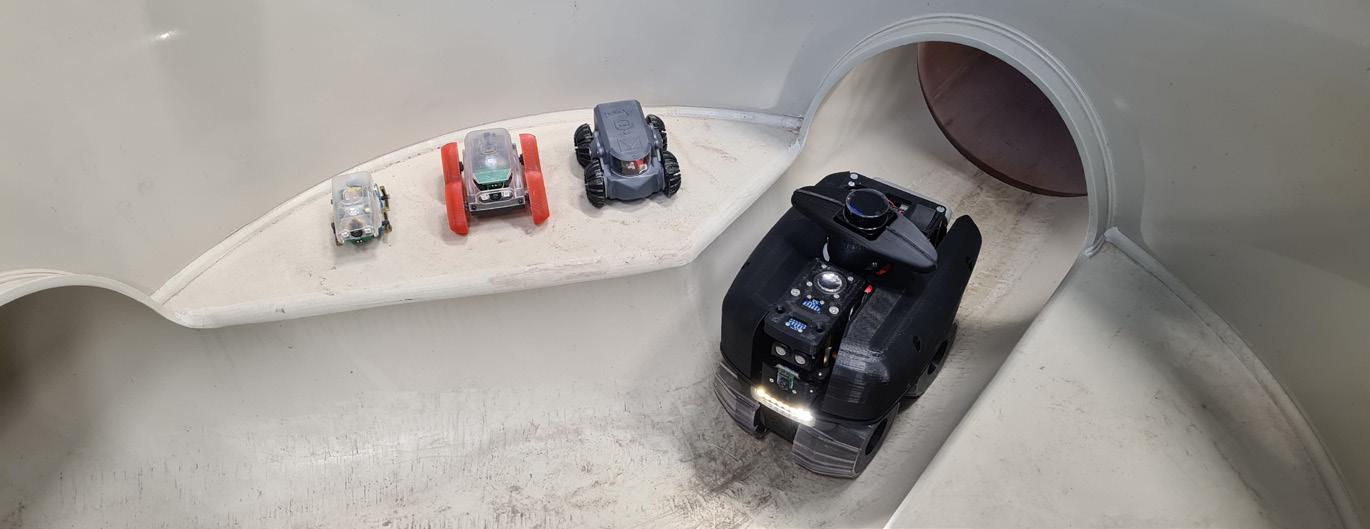 Z Olivia Tempest
Z Olivia Tempest
The importance of reducing non-revenue water has become increasingly clear as climate change is making water scarcity worse, and countries such as the UK are turning their attention to this issue. There are numerous inspection technologies that exist on the market, including sniffer dogs and thermal imaging drones; however, a team of researchers led by Professor Kirill V. Horoshenkov at the University of Sheffield are working on an innovative project with little robots called Pipebots
that will not only increase the detection of leaks, but also transform the management of the United Kingdom’s pipe network system with minimal disruption to roads.
Kirill Horoshenkov, Professor of Acoustics in the Department of Mechanical Engineering at the University of Sheffield, was trained as an acoustic and ultrasonic engineer and worked in acoustics all his professional life. He holds MEng and PhD degrees in acoustic engineering. Before joining the University of
Sheffield, he spent 21 years working for the University of Bradford where he developed a strong interest in acoustic sensing for buried pipes. His current role at the University of Sheffield is to lead the Pipebots team to deliver this technology for the benefit of the UK’s water industry and other industrial partners globally. He also works on related projects, including developing fibre-optic sensing for sewer pipes and acoustic holography to map river flows using drones.
“The main impact of Pipebots is that water utilities will move on to truly proactive pipe network management”
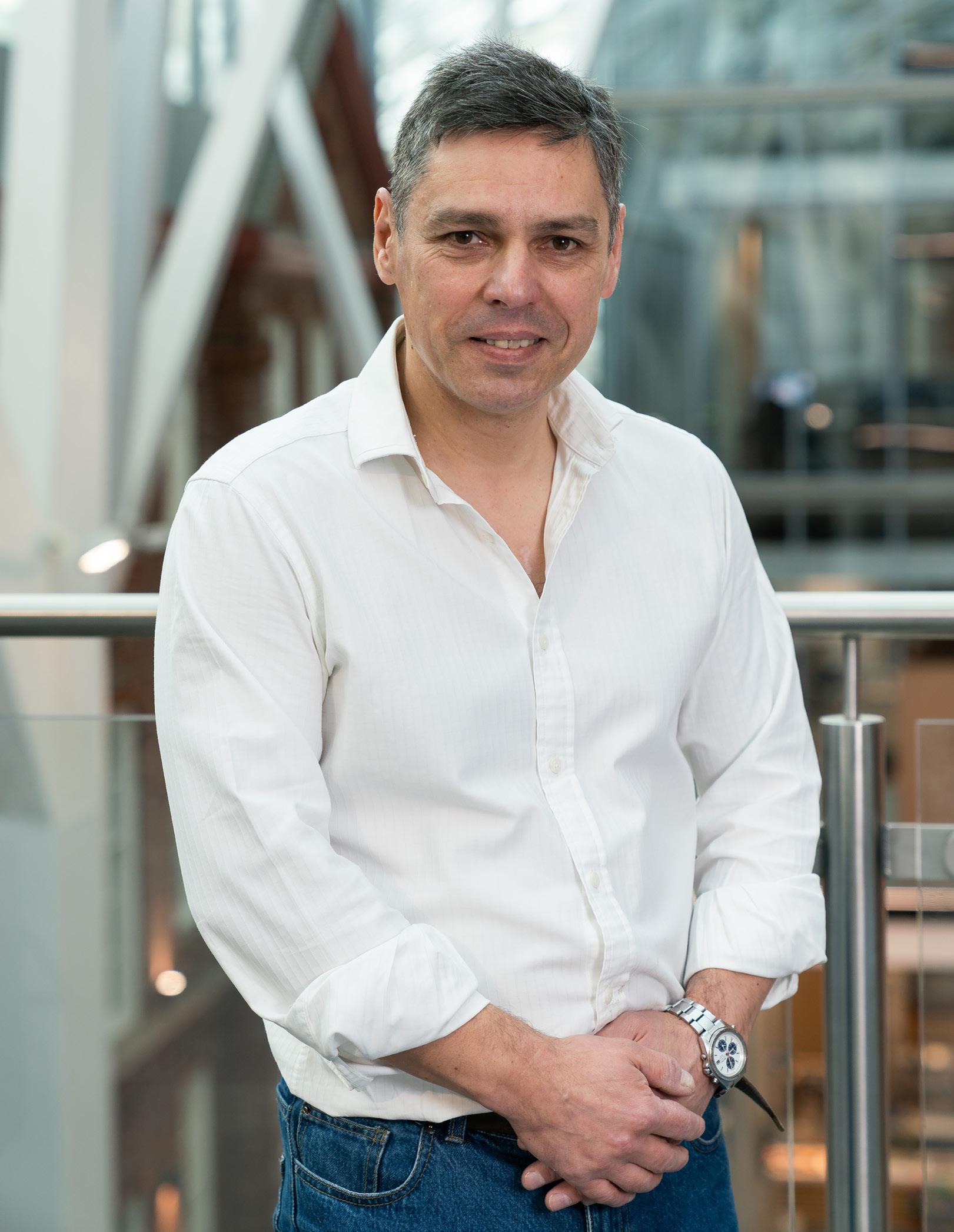
Around 3 billion litres of water are lost through leaks every day in England and Wales. The University of Sheffield’s ICAIR is testing subterranean robotic pipe patrollers. How did you come up with the idea?
It became clear to the team that in order to detect the onset of wall damage or small (hidden) leaks in a pipe it was necessary to bring a sensor close to its location, i.e. to deploy it on a robot that can move autonomously through the pipe. Ideally, such a robot should be equipped with a range of sensors, i.e. acoustic, ultrasonic and CCTV that should work collaboratively fusing several data streams together to detect defects and leaks that are currently undetectable with traditional sensors, like acoustic data loggers or hydraulic pressure monitors.
What benefits do the Pipebots present compared to other leak-detecting methods, for example, satellite imaging, specialised in-pipe cameras or thermal drone technology?
"Pipebots work from in a pipe network so that the inside of pipes is well visible and they can navigate themselves and map the network"

Pipebots go inside the pipe so that sensors can get much closer to the defect. These measurements are not subject to noise from the environment so they can help detect very small leaks that are currently undetectable. Thermal drone technology only detects large leaks from trunk mains mainly. In-pipe cameras do not always see a leak because it is difficult to spot behind a bad wall condition and the onset of a perforation that can actually result in a leak. Acoustic loggers attached to the outside of the pipe are not sensitive or accurate enough to pick up small leaks, characterise them and pinpoint their exact location to guide accurate excavation work.
Part of the problem in detecting leaks is that some of the pipes are not visible, and therefore difficult to determine where they are. How can AI-powered robots help in this regard?

Pipebots work from in a pipe network so that the inside of pipes is well visible to these robots. The robots can navigate themselves and map the network. The sensors the robots carry detect damage and leaks and superimpose them on the network map so that the network is perfectly visualised by the robots and their operators.
Water leaks not only have an impact on the environment but also cost economies $14 billion per year worldwide. How can the Pipebots help with this issue?
Pipebots go inside the pipe so that sensors can get much closer to the defect enabling to find small leaks that are currently undetectable
The main impact of Pipebots is that the water utilities can move on to truly proactive pipe network management. This means that the robots can identify problems at their onset and suggest to the operators the right parts of the pipe to maintain. It is much cheaper to maintain pipes before damage or leaks become obvious and visible from above ground. Proactive maintenance can be done with No Dig technologies delivered with special robots from inside the pipe. Also, identifying small leaks and fixing them without road excavation and preventing new leaks means that the cost of network maintenance is very low. This means that less water is pumped through the pipes with less energy used, less water treatment efforts, less road excavation and less traffic and service disruption.
What water companies is the ICAIR team working with to test these new devices? Thames Water, Wessex Water, Welsh Water and Severn Trent.
Once the Pipebots are commercially patrolling the water network in the UK, do you plan to introduce this detecting system in other parts of the world?


Yes. We are collaborating with teams in the United States, Canada, Australia, Continental Europe, Hong Kong, Singapore and Mauritius. There is a lot of interest from those parts of the world in Pipebots technology because the problems it is designed to solve are global.
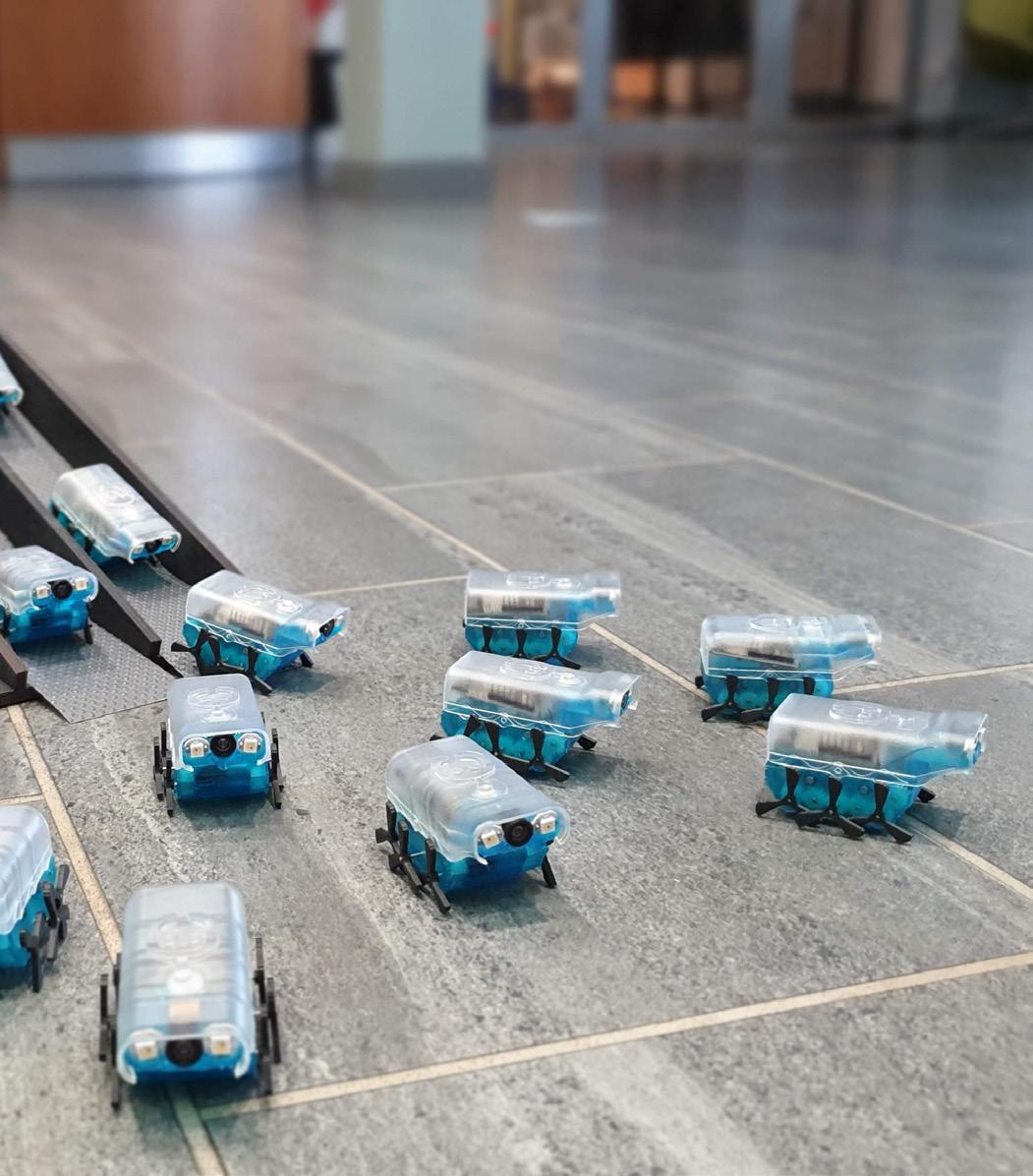
Canal de Isabel II entrusts its new IoT project to Hidroconta and Orange: they will be in charge of the deployment of 9,000 gateways connected to Orange’s NB-IoT mobile network and using TST Sistemas technology implemented by Hidroconta, to enable the connectivity of more than 100,000 smart meters.
Canal de Isabel II, the water services provider in the region of Madrid, Spain, continues to move forward as part of its clear commitment to digital transformation. In this regard, it has entrusted its new IoT project to Hidroconta and Orange as suppliers of 9,000 gateways –connected to Orange’s NB-IoT mobile network and using TST Sistemas technology implemented by Hidroconta –to enable the connectivity of more than 100,000 water meters.
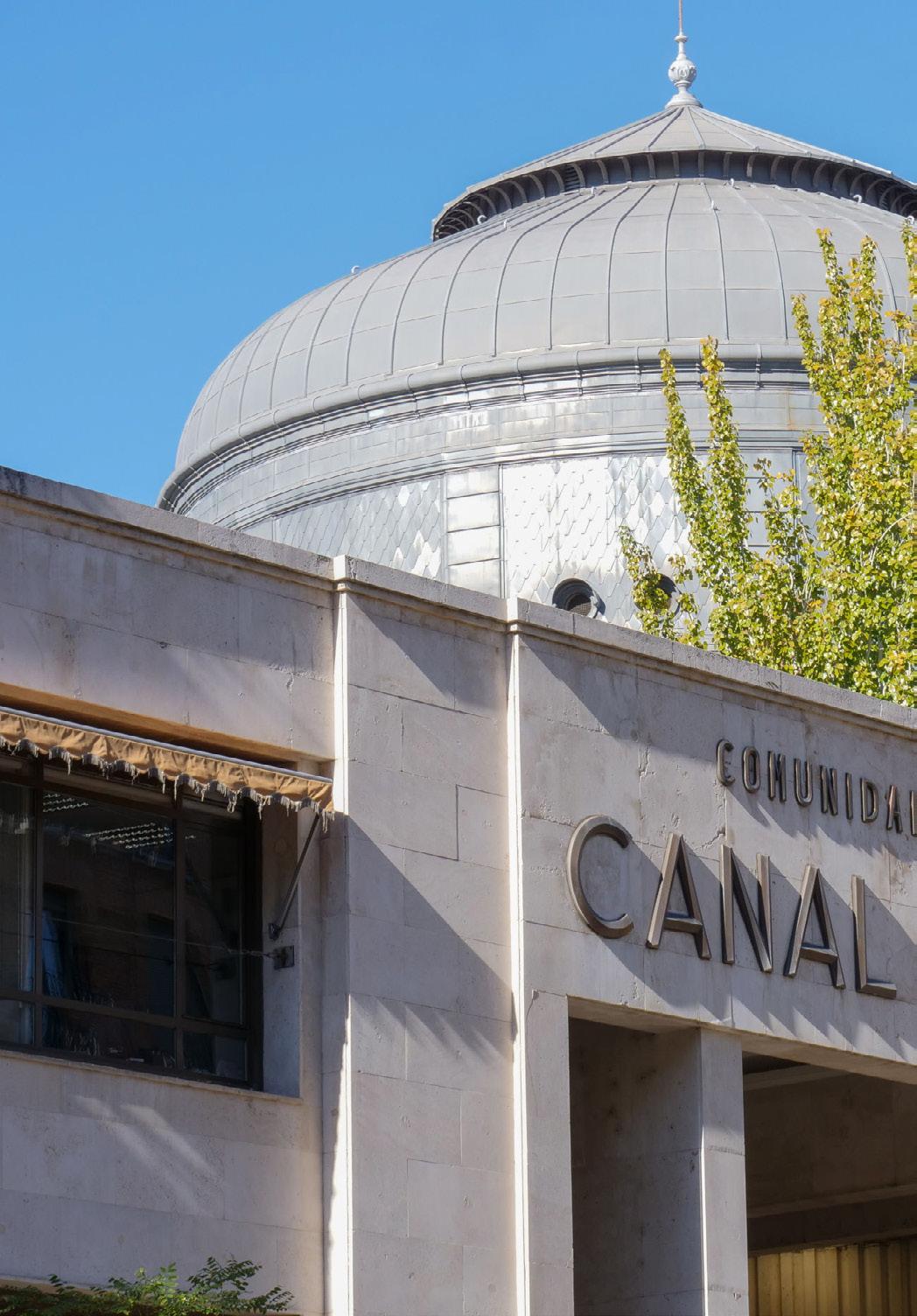
The project entrusted to a Temporary Joint Venture between Hidroconta and Orange is part of the Strategic Plan 2018-2030 of Canal de Isabel II, which provides for the digitalisation of urban water cycle uses, including the deployment of cutting-edge meters, thus offering its customers remote reading services.
The digitalisation of water management undertaken by Canal de Isabel II is an innovative and transformative process that seeks to improve water management in the region of Madrid. Thanks to the implementation of advanced technologies, such as sensors and geographic information systems, it is possible to monitor the status of the distribution network and detect any potential leaks or breakdowns quickly and efficiently. In addition, digitalisation allows users to access real-time information about their water consumption and receive alerts about any potential service disruptions. This process not only improves the quality of the services offered by Canal de Isabel II, but also contributes to a sustainable and efficient use of water resources.
The gateway to enable automated remote reading of electronic water meters is a gateway type device with a wM-BUS communications bus and long-range wireless communications NB-IoT. The gateway modules are advanced communication devices that enable the digitalisation of water meters. These modules are installed on the meters and are responsible for collecting detailed information on water consumption in real-time, thanks to advanced metering technologies. The modules then transfer the data to a central processing unit, where it can be analysed and used to improve water management. The advantage of the gateway modules is that they are highly efficient and accurate,


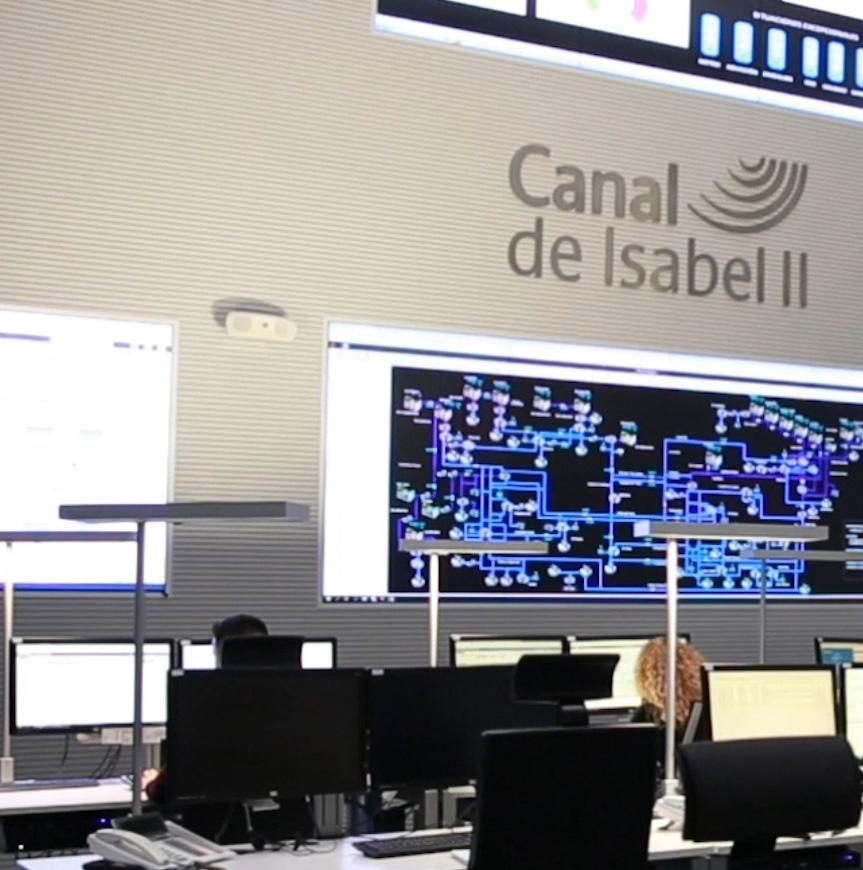
allowing better monitoring of consumption and early detection of possible leaks or water losses.
One gateway will be deployed for every 11 water meters placed in residential connections to a water system. The gateways are stand-alone devices and are designed to provide long-range wireless communications using NB-IoT technology. Some of the key features of these devices are:
J Battery powered: the device does not require an external power supply and instead uses batteries. This means it is portable and can be used in locations where there is no access to a power outlet.
J NB-IoT long-range wireless communications: the device uses NB-IoT (Narrowband IoT) technology to provide long-range wireless communications. This technology is especially useful for Internet of Things (IoT) devices that need to send data over long distances and with low power consumption.
J Compatible with UNE-82326:2010 communications bus: the device is compatible with the UNE-82326:2010 communications bus, a Spanish standard used in some industries for device and system communications.
J Real-time clock: the device has a built-in real-time clock that allows measurements and events to be accurately recorded over time.
J Read-on-demand through in-person interaction: allows a user to interact with the gateway device and request a specific reading, providing greater flexibility and efficiency in data management.
J Over-the-air update of both the device FW and the NB-IoT modem: the ability to update the device firmware and the NB-
This is an important project that consolidates Spanish company Hidroconta in the development of remote metering projects
IoT modem without having to disassemble the device or physically travel to the site.
J Debug port: a connection that allows developers to access system information and debug code in real-time. Important during the development and testing process, it allows developers to detect and correct errors more quickly.

J Internal process information LEDs: they indicate relevant information about the reading and data collection process.
J Compatible with any mobile operator, allowing greater flexibility and versatility of use.
Thanks to Orange’s NB-IoT network, Canal de Isabel II will benefit from low battery consumption for its gateways, which is vital to enable operations
throughout its lifecycle. In addition, this network allows greater signal penetration to transmit readings in difficult locations, as well as lower hardware acquisition and communications costs.
Gabriel Aparicio, responsible for this project at Canal de Isabel II, said: “Remote reading of water meters is an important part of the digital transformation of water cycle management, which should enable a much more responsible and sustainable use of a scarce resource. With it, it will be possible to offer end users a better service thanks to real-time information about consumption, moving from bimonthly readings to hourly readings, in addition to benefits such as remote management of smart meters, automatic leak detection, etc.”
María Ruano, Hidroconta’s marketing manager, added: “This is an important project that consolidates Hidroconta in the development of remote metering projects. The Strategic Project for Economic Recovery and Transformation (PERTE) to advance the digitalisation of water cycle management in Spain is supporting these projects and many municipalities are engaging in extensive remote reading deployments, such as this initiative launched by Canal de Isabel II in the region of Madrid. In this case, the idea is to digitise water consumption data from the meter fleet, monitoring consumption every hour and sending this information to Canal de Isabel II for analysis and management.”
According to Íñigo Polo, Director of Public Administrations and Digital Services at Orange, “Canal de Isabel II’s confidence in Orange’s IoT services is the result of our leading position in this technology, the good results that our network has offered in terms of performance and autonomy, as well as our constant support for two years to help them in the implementation of the pilot projects that allowed testing the new remote metering technology.”
Remote meter reading is an important part of the digital transformation of water cycle management, which should enable a much more responsible and sustainable use of a scarce resource. With it, it will be possible to offer end users a better service thanks to real-time information about consumption, moving from bimonthly readings to hourly readings, in addition to benefits such as remote management of smart meters, automatic leak detection, etc.
Digitalisation not only improves the quality of water services, but also contributes to a sustainable and efficient use of water resources
 DIRECTOR OF SMART MANUFACTURING AT L2L
DIRECTOR OF SMART MANUFACTURING AT L2L
Providing clean water to communities and commercial facilities requires multiple technologies and operational practices anchored in safety. Water treatment plants are striving to modernise operations and adopt digital solutions to overcome water treatment challenges, meet customer demands and guarantee the safety of physical, chemical and biological processes and water.
Connected worker technology leverages IIoT sensors, various software and digital devices to simplify communication and streamline routine operations for a safer work environment. Let’s see how water treatment plants can leverage connected worker technology to improve safety.
Connected worker technology enables plants to gather data and monitor the performance of different assets in real-time. Embedded sensors in critical water treatment equipment detect minute changes in processes and generate timely alerts.
The alerts help identify and rectify hazards that can cause accidents or contaminate clean drinking water, exposing end customers to health risks. Sensors provide remote information on the quality of processes and equipment, which eliminates the need for workers to operate and inspect assets in hazardous locations — reducing workplace injuries.
Connected worker technology uses sensor data to create customised predictive maintenance algorithms for optimising equipment and process performance in water treatment plants. Analytics software used in connected worker platforms analyses sensor data from different sources, identifying patterns and water treatment trends — indicating potential safety risks and impending failures or breakdowns. The predictive systems alert maintenance teams to mechanical abnormalities, allowing them to rectify defects on time and averting potential safety risks. Predictive maintenance is particularly beneficial for aging infrastructure and critical water treatment assets.
Employees and supervisors must constantly communicate to ensure seamless water treatment. This includes real-time updates on prevailing safety risks, production targets, changes in operating standards and operational risk assessment.
Connected workers use sensor-enabled PPE and wearables for monitoring employees in real time, providing safety supervisors with adequate information on the well-being of field employees. Water treatment plants can use this data to make informed decisions on the reliability of hazard prevention systems and the safety of different water treatment operations.
Regular maintenance enhances the efficiency, safety and durability of water treatment equipment. Digitalising operations in utilities requires significant upgrades to maintenance programmes, including implementing predictive maintenance.
These workers use wearables, mobile devices and technology such as instant messaging, pre-recorded virtual reality (VR) and augmented reality (AR) videos to share mission-critical information and disseminate guidance and instruction. Multiple communication channels ensure employees can report workplace hazards in real time, ensuring everyone is aware of safety risks and quick response. Water treatment plants can share crucial work instructions and standardized checklists to prevent human error, which can exacerbate safety risks.
The safety of wastewater treatment plants is the top priority for utility companies. Investing in appropriate connected worker technologies optimises workflows while improving safety at the same time. Implement connected worker platforms in phases and focus on collecting data crucial for boosting process and worker safety. Use this data to drive continuous safety improvement, and make sure you keep an eye on emerging connected worker technology to stay ahead of your safety game.

The buzz around digital transformation has been gaining momentum in both public and private sectors globally, including Indonesia. With a population of more than 270 million, the Indonesian government has launched initiatives like "Making Indonesia 4.0" and "Towards 100 Smart Cities" to embrace digitalisation. Digital frameworks in governance can reduce costs and effort, leading to improved overall operations.
Indonesia's local water companies, known as PDAMs, have also begun modernizing their operations and services through the use of digital technology. They have implemented applications to read customer meters, process digital billing, and manage complaints, employee databases, and payroll, making administrative processes faster and more efficient.
However, the core service of water companies is water production and distribution. The biggest challenge facing PDAMs throughout Indonesia is water loss, with a national average of 33.24% non-revenue water (NRW). The lack of reliable real-time water loss detection and measurement systems means that the actual number could be higher, resulting in financial losses and risking water resource preservation.
Bima Sakti Alterra (BSA), a company committed to providing solutions for PDAMs operational challenges, has upgraded technological innovations to help over 100 PDAMs in Indonesia in the past 14 years. PERUMDAM Tirta Sanjiwani is among 100 of BSA’s clients that have committed to implementing Smart Water Grid Management (SWGM) in the early stages. Earlier in 2023, Perumdam Tirta Sanjiwani and Bima Sakti Alterra had agreed to implement a more comprehensive SWGM solution, which was piloted in the Blahbatuh technical zone. The pilot project will isolate water flow from production to consumption for 70 households. A water level sensor is installed in the reservoir to provide real-time information to prevent under as well as overcapacity. The minimum level of water is adjusted to the customer’s water demand level so that the continuity of water to the customer is maintained.
The biggest challenge facing PDAMs throughout Indonesia is water loss, with a national average of 33.24% non-revenue water
Pressure and flow sensors are also installed in critical distribution networks that will help the water company to identify earlier if there is a drop in water pressure which can impact on a decrease in service. On the end users’ side, smart water meters were being installed, which will make the NRW rate more accurate since water usage data is measured in real-time.
To minimise water loss, reliable data on water flow from production to consumption at the customer level is necessary. Digital technology such as IoT-based sensors can provide real-time reports on water flow and usage, as well as asset performance in the field. Anomalies can be detected quickly, enabling the identification of root causes and suggestions for improvement.
Smart remote-control technology integrated with monitoring systems can enable quick decision-making, while dashboards displaying real-time data can improve coordination between departments and support leaders in decision-making and policy formulation. However, challenges such as unequal distribution of quality education and lack of investment capabilities need to be addressed to facilitate digital transformation.
After all the sensors above are installed, the system will be able to provide a comprehensive picture of the whole water distribution process. This data will later be displayed in a more comprehensive manner through the Supply Chain System portal and the Integrated Command Centre (ICC).
Its SWGM technology integrates water management infrastructure, risk management, and data analysis to support decision-making and smoother operations through a multidimensional ICT-based approach. The SWGM's ecosystem includes IoT-based sensors, real-time data and alert management, and data visualisation in a command centre dashboard, providing a sustainable one-stop solution to improve water management technology from upstream to downstream.
global volume of non-revenue water, or freshwater that is lost due to leaks, is estimated to be 346 million cubic metres per day, amounting to 30% of water system input volumes across the world. Water data and new AI-powered tools can help address this challenge and have a tremendous impact on water solutions like leak detection. This first-of-its-kind leak detection technology replenishment project in London with FIDO Tech will reduce water lost to leakage in London’s aging distribution network, leveraging FIDO’s AI-enabled acoustic leak analysis and is expected to save millions of cubic metres of water per year.”
A new agreement with Microsoft is helping the technology company make progress against its water replenishment goal, part of its overarching water-positive commitment. In a first-ofits-kind replenishment project, FIDO’s technology has been deployed in London and across the Thames Water region to reduce water network losses through the power of actionable AI.
London’s water utility Thames Water has already committed to reducing its overall leakage to 20% by 2025 and to half leakage by 2050, but the average amount of water lost to pipeline networks globally is much higher. Fixing water losses positively impacts water availability with immediate impact across local watersheds in a quantifiable way. As well as making more water available to consumers and easing pres-
sure on water sources, it also means less water needs treating, reducing a utility’s energy footprint.
FIDO is one of the sector’s most sophisticated AI solutions, with the unique distinction of being able to identify leaks and, most importantly, rank them by size, even in the noisiest networks, regardless of pipe material or condition. The Microsoft collaboration will help to expand FIDO’s coverage across the Thames Water network, giving visibility on an additional 350 km of the water pipe network.
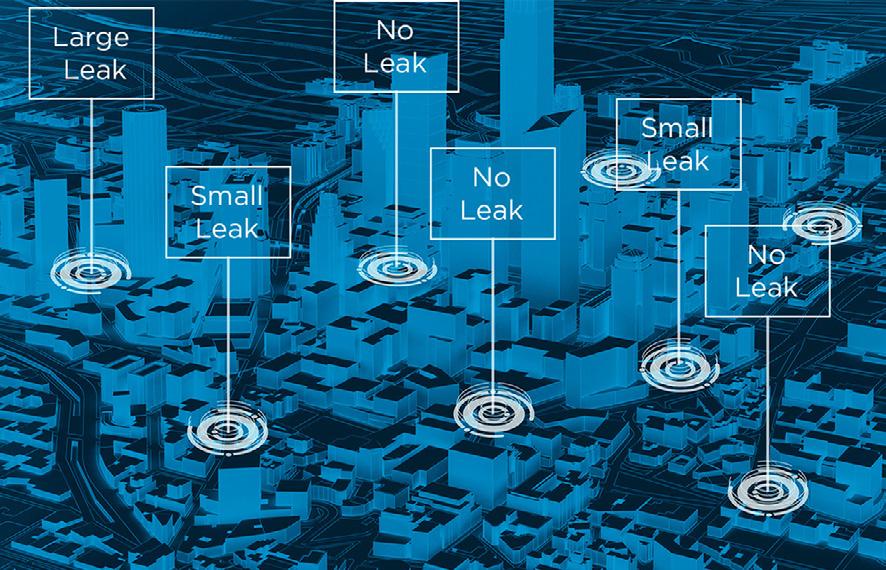
Microsoft’s commitment to working collectively with partners and customers to protect freshwater is helping drive digital transformation for people, organisations and industries around the world.
Melanie Nakagawa, Chief Sustainability Officer at Microsoft, said: “The
FIDO has already seen multiple successes across the UK. The company has been working with Thames Water since 2021 and has partnered with Northumbrian Water to reduce leakage by 37% across 15 assigned district metering areas (DMAs).
Victoria Edwards, Co-founder & CEO of FIDO Tech, said: “Microsoft is at the vanguard of a blossoming new corporate movement to replenish our watersheds, called water positivity. The beauty is that what makes FIDO AI so disruptive, is what makes water positivity possible. It’s quantifiable, it’s transparent, it’s immediate and it’s local. It has a real impact.”
Nevil Muncaster, London Operations Director at Thames Water, said: “95% of leaks are underground and not visible. That’s why using innovative methods, such as FIDO’s AI, is so important.”
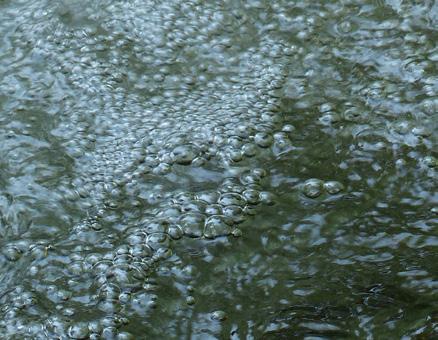
Ecolab and Microsoft have extended their collaboration with the aim to help organisations accelerate their sustainability progress with enhanced visibility of water consumption data.
“As companies look to save on costs while driving profitable growth using fewer natural resources – they must prioritize water," said Christophe Beck, Ecolab’s chairman and chief executive officer. “By partnering with Microsoft and using our joint water data capabilities, we can help companies achieve
their climate and business goals all at once.” Together, Ecolab and Microsoft plan to help:
Unify water and sustainability data: Centralise water use data and integrate it with other environmental, financial, and operational data, for improved reporting and manage progress against goals, with Microsoft Cloud for Sustainability and ECOLAB3D™.
Reduce water consumption and costs: Maximise efficiencies and reduce water usage at the site level and enter -
prise-wide with actionable intelligence and water solutions tailored to industry scenarios.
Identify energy consumption and greenhouse gas emission savings opportunities: Use digital technologies to help link water efficiencies with energy savings and reduced greenhouse gas emissions.

Drive transformation that benefits the planet and business: Cultivate sustainability and business intelligence to inform more effective, value-based decisions.
Aquatech, a leading global water and process technologies provider, and Fluid Technology Solutions, a technology-forward manufacturer of advanced membranes and separation technologies, have entered into a strategic partnership aimed at delivering the next generation of advanced separation, brine concentration, and water reuse solutions.
Aquatech and FTS will work together to deliver advanced water treatment technology and process solutions in key markets, including brine mining, lithium and
critical minerals, inland desalination, and minimal/zero liquid discharge (MLD/ ZLD). This partnership aims to refine and elevate higher brine concentration technology, focusing on high recovery, low energy consumption and achieving the lowest CO2 footprint at the highest water and mineral recoveries.
FTS has a long history of cutting-edge osmotically assisted reverse osmosis (OARO) and forward osmosis (FO) membranes and is the first company to commercialize these technologies for key industries. Aquatech
is a trailblazer in brine minimisation and recovery solutions, possessing extensive expertise and operational experience.
Aquatech's high recovery membrane and evaporative process technologies, coupled with FTS's membrane brine concentration, will provide customers with optimal and cost-effective solutions for achieving maximum water recovery, as well as the ability to recover pure salts and critical minerals from brackish water, seawater desalination, and mineral recovery applications.
The Iceberg-class wave-powered desalination solution by Oneka Technologies has been developed as a commercial-scale unit for coastal communities, industries, and resorts. One unit has a production capacity of 30-50 m3 per day, depending on wave height, measures 6 metres by 8 metres, and weighs 18 tonnes. The Glacier Class, utility-scale units, currently under development will serve large municipalities and industries by producing up to 500 m3 of fresh water per day.
The solution consists of a floating platform that is anchored to the ocean floor, and a submerged pipeline that transports freshwater to shore. Wave energy is used to pump water into a reverse osmosis desalination system and to transport water to shore, while solar energy is used to con-
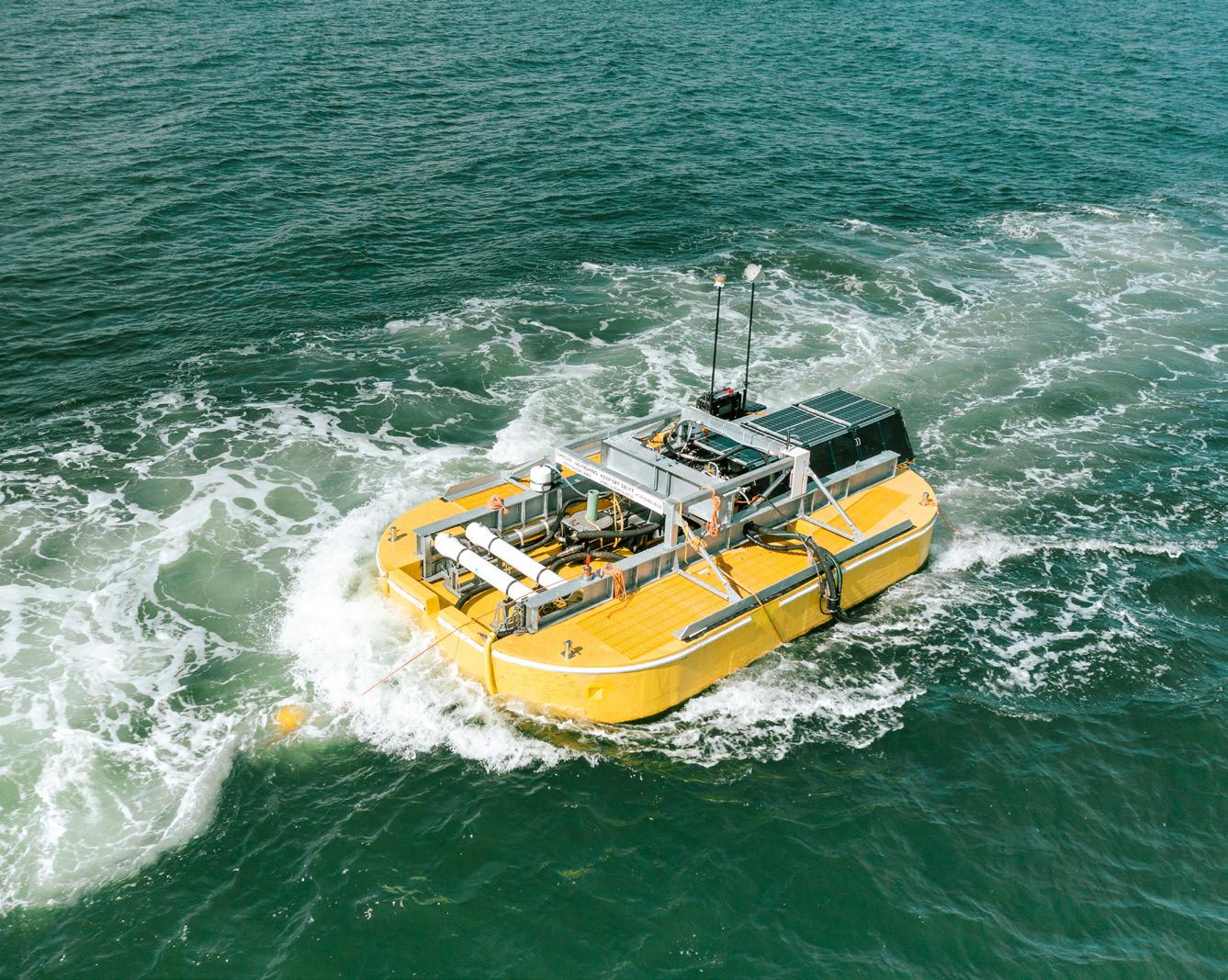
trol sensors onboard the unit. It can operate with waves that reach a minimum height of one metre, and the depth of the seabed should be between thirteen and thirty metres.
The units boast further environmental benefits, including a mesh that prevents marine life from being sucked inside and no land space is required. In addition, the brine discharged has a salinity about 30% higher than the ocean and dilutes over a wide area with minimal impact. Designed to be modular and scalable, the system can adapt to evolving water needs, installing additional units, side by side.
Smaller-size units are also available, such as the Icecubeclass units, which can produce 1 m3 per day, for humanitarian and disaster relief applications.

The Convention on Wetlands is the intergovernmental treaty that provides the framework for the conservation and wise use of wetlands and their resources, through local and national actions and international cooperation, as a contribution towards achieving sustainable development throughout the world.
Wetland ecosystems are the planet’s most threatened ecosystems, even though they provide essential services and supply, directly or indirectly, to almost all our freshwater. These ecosystems underpin the resilience of water and food systems and are key to meeting climate and biodiversity goals. We had the opportunity to ask Dr Musonda Mumba, Secretary General of the Convention on Wetlands, about the links between wetland ecosystems and water security.
Can you tell us what it means for you to work on environment and sustainable development at the highest level of international organisations?
There is greater responsibility and accountability at this level. Considering that we are a convention and are serving the contracting parties, it also gives us an opportunity to share experiences from around the world on what’s hap-
pening around wetland ecosystems. As the Secretary General of this convention, I also have the responsibility to help connect the dots across the multilateral space and raise the visibility of our convention.
What do you think are some of the most pressing challenges for the implementation of the Ramsar Convention in the coming years?
I think some of the most pressing challenges revolve around the triple planetary crises linked to climate change, biodiversity loss and pollution. Wetlands are suffering from these three with severe consequences for people and nature alike.
What role do wetlands play in ensuring water security, and how are they connected?
Wetlands by their nature are linked to water from source to sea. Water sources
in mountains and high-elevation areas come from springs that are wetlands; when there are changes in the landscape, such as degradation, compounded further by climate change - we see water insecurity as a consequence. Remember what happened along the Loire Valley in France in 2022 when much of the river dried up. Places like the Aral Sea and Lake Chad have both seen such water insecurity over the years with severe implications for communities and livelihoods.
Z CrisTina nOvO pérez
“Wetland restoration is central to achieving water security goals especially in severely affected areas”
"As the Secretary General, I have the responsibility to help connect the dots across the multilateral space and raise the visibility of our convention"
How can wetland restoration and conservation contribute to achieving water security goals?
Wetland restoration is indeed central to achieving water security goals, especially in severely affected areas. However, the restoration requires a landscape approach with concerted efforts across sectors because their degradation is linked to multiple factors.
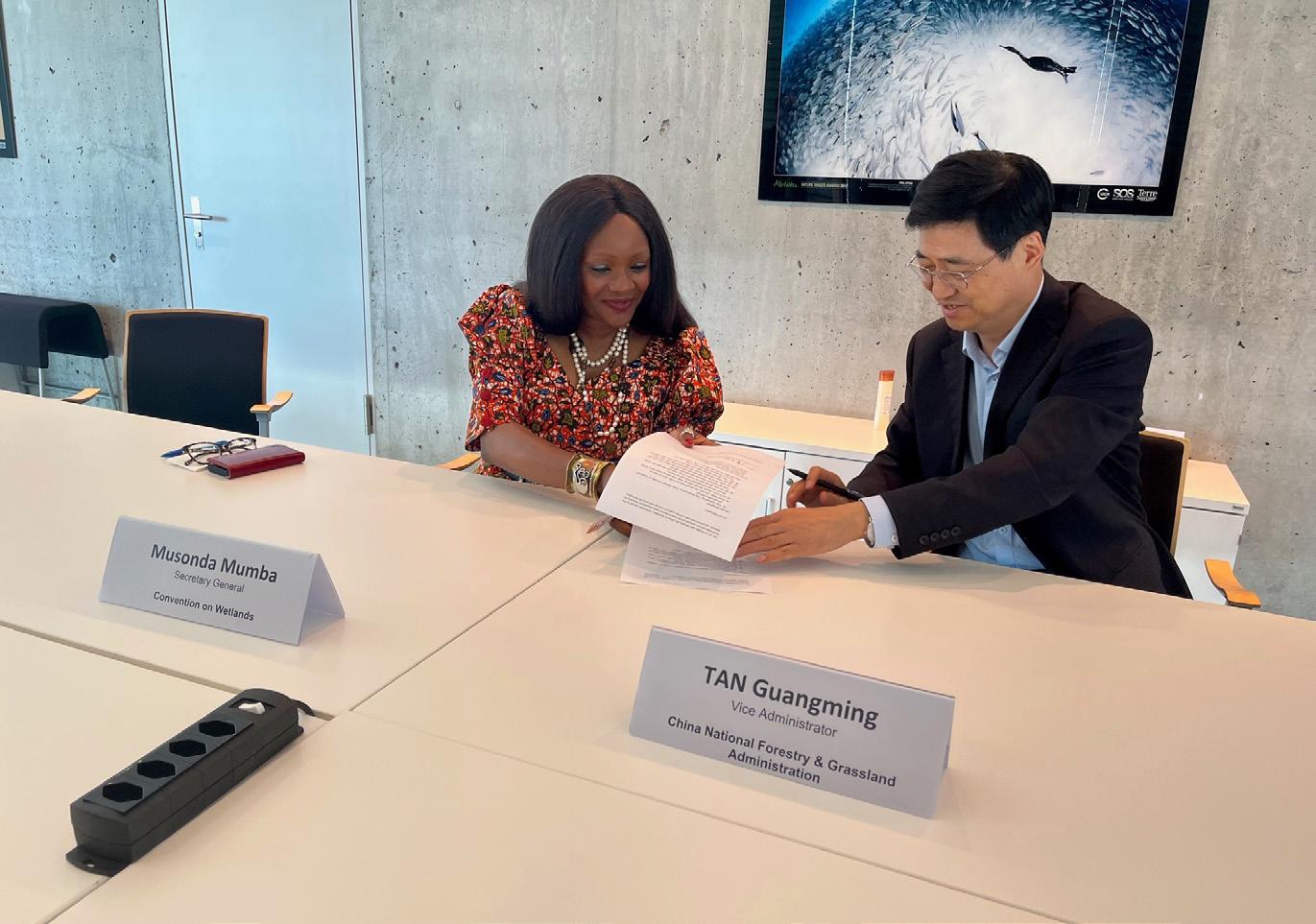
Could you discuss some successful examples of wetland restoration projects that have improved water security, and what lessons can be learned from them?
I would point to the Mangrove restoration done by Ms Fernanda Samuel, National Coordinator of Mangrove Protection and Restoration in Angola. She prevented more than 17,000 hectares of mangroves from being destroyed by the construction of ports and the oil industry. With more than 4,500 volunteers, an estimated 3,000 hectares of mangroves have been restored. Migratory birds have returned - and fishing communities have benefited from the return of fish, crustaceans and molluscs. For her efforts, Fernanda received the Ramsar Wetland Conservation Award for Young Wetland Champions in 2022.
A second restoration project is the ongoing restoration of the Govan Wetlands in Glasgow in the United Kingdom. The project was the winner of the Pitch for the Grant 2022, a new 10,000 euros grant from Danone to fund wetland conservation.
Finally, the Namami Gange project in India aims to restore the ancient Ganges River. This programme is reforesting parts of the Ganges basin and safeguarding its wildlife and all those who depend on it. This is one of the 10 flagship initiatives under the UN decade on Ecosystem restoration.
How can wetland conservation efforts be balanced with economic development and other land use priorities?
The Convention on Wetlands founded in 1971 coined the term “wise use” ahead of the use of “sustainable development”. As
"When there are landscape changes, such as degradation, compounded further by climate change, we see water insecurity as a consequence"
the most experienced Multilateral Environmental Agreement (MEA), the ambition has been to have a balance between the conservation and wise use of wetlands spaces and ecosystems. This is also why partnerships matter across a landscape, to agree on a meaningful use of the landscape as it relates to the wetland system.
From your experience working within UN system organisations, to what extent are wetland protection and restoration goals integrated into water security and 2030 Agenda discussions, and is there room for improvement?
In 2019 the UN Decade on Ecosystem Restoration was passed as a UN Decade aligning with the Sustainable Development Goals (SDGs) and this was a milestone. As a convention, we are part of this decade and also the SDGs, and actually a co-custodian of SDG 6 indicator 6.6.1 –change in the extent of water-related ecosystems over time – jointly with the United Nations Environment Programme (UNEP). This has provided an opportunity for us to be at the table and bring the wetlands agenda into the UN system and processes. We are the only Multilateral
Environmental Agreement (MEA) that sits outside of the UN system. However, we are a Multilateral body.
The UN Water Conference 2023 aims to accelerate action for water and achieve SDG 6. What outcomes do you expect in relation to wetlands? This is indeed an important moment for wetlands and for our convention. We
know that the challenges of water, particularly droughts, floods and other issues such as plastics manifest more pronouncedly in wetland systems. This year 2023 – on the margins of the SDG Summit following the UN Water Conference - the world will be discussing the progress made under SDG 6. And do note we don’t have much time left with less than 7 years left before the end of the SDGs in 2030.

Wetland restoration requires a landscape approach with concerted efforts across sectors because degradation is linked to multiple factors
Sewerage Corporation (CORAASAN), and the La Vega Water and Sewerage Corporation (CORAAVEGA) will be responsible for planning, budgeting, and implementing activities and for achieving targets, under the coordination and supervision of the Ministry of Economy, Planning, and Development (MEPyD).
The World Bank approved a US$250 million loan to support the efforts of the Government of the Dominican Republic to improve access to safely managed water and sanitation services (WSS) and improve the capacity and efficiency of WSS institutions. This operation will benefit 34,700 households (approximately 121.000 people) with access to a safe water supply and 76,300 households (around 276,000 people) with access to a safe sanitation system.
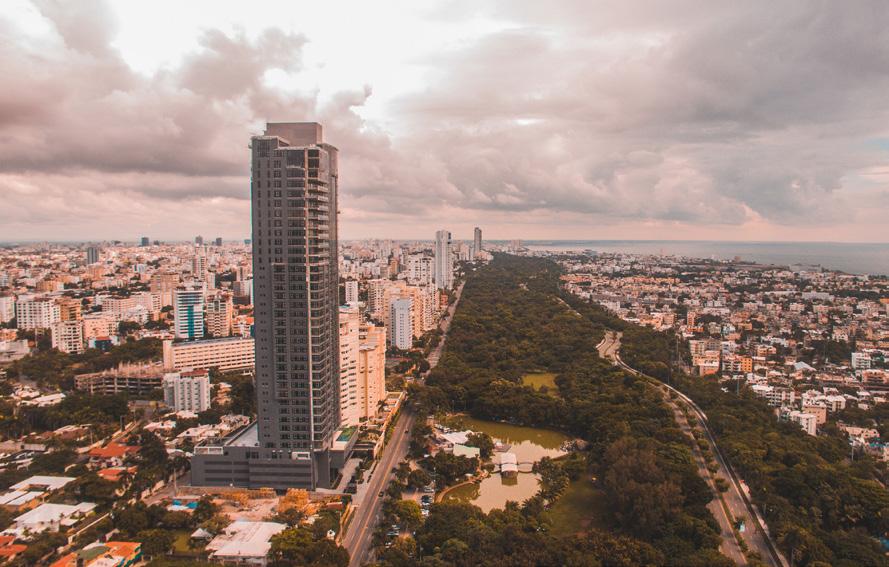
“Reform of the water sector is a priority for the Government of the Dominican Republic. Its goal is to transform and modernize the governance and institutional framework of the sector in order to increase the production of water for human consumption and to achieve a more efficient and sustainable use of water resources. The technical
and financial support of the World Bank is currently and will be in the future, the key to promoting institutional reforms and investments to modernize the water sector in the country, for the benefit of all”, said Pavel Isa Contreras, Minister of Economy, Planning and Development (MEPyD for its name in Spanish) of the Dominican Republic.”
The US$250 million operation consists of a US$225 million program to increase the climate resilience of households and the delivery of WSS services in the provinces of Monte Cristi, Valverde, Santiago Rodriguez, Santiago, and La Vega in the Yaque del Norte basin. The Program will incentivize reductions in water losses, increased access to sanitation services, and improvements in energy efficiency.
The National Water and Sewerage Institute (INAPA), the Santiago Water and
The operation has a US$25 million component to help address institutional reforms, capacity building, and investments in water information systems and dam safety instrumentation to adapt effectively to climate shocks. Implemented by the Minister of Economy, Planning and Development (MEPyD) and the National Institute for Hydraulic Resources (INDRHI), this component will provide support for supervision, coordination, monitoring and evaluation of the program, including verification and audits of the results.
The US$250 million loan is the first of two phases in a 10-year Multiphase Programmatic Approach (MPA), the first of its kind in the Dominican Republic. The MPA Program will support the government’s transformational investments in the water sector to address the sector’s challenges by i) fostering reforms, and (ii) improving the quality, resiliency, and efficiency of WSS and water resource management to adapt to climate change.
The World Bank MPA Program’s estimated financing envelope of US$500 million over ten years will leverage investment from the government, WSS providers, and other development partners.

The proposed plan includes some 50 measures targeted at different sectors: energy, industry, tourism, recreation, as well as individuals
France’s President Macron has announced a plan to tackle water scarcity, focused on sharing, reusing and saving water, informs Euronews. Last summer France, as well as most of Europe, experienced an unprecedented drought, and this winter the country went without any rain for a period of 32 days. Agriculture is the largest water user, with almost 60%; other uses are drinking water with 26%, industry with 4%, and the remaining 12% which goes to cooling nuclear power plants. While farmers call for more reservoirs to ensure water
availability for irrigation, there is strong opposition from environmental groups.
The proposed plan includes some 50 measures targeted at different sectors: energy, industry, tourism, recreation, as well as individuals. "In the face of change, there are necessary constraints, we must explain them, share them and make each and every one aware of their responsibilities", said the president.
Water leakage causes big losses, up to half of the water in some towns, with an average of 20% for the country. An emer-
gency fund worth €180 million will be allocated to address leakage and upgrade water networks. Additional investments are foreseen to adapt the cooling systems of nuclear power plants. Macron also announced a water reuse target of 10% of all wastewater by 2030.
To encourage water saving, progressive tariffs will be introduced to make water more expensive for those that use it most. Moreover, a new app will provide information to residents on water use in their area once it reaches critical levels.
The reservoir proposals and other infrastructure projects are part of efforts to deliver sustainable and resilient supplies for the future
Ofwat has given the green light to continue the investigation into three new reservoirs, which could supply water for millions of customers. The reservoir proposals sit alongside nine other infrastructure projects being moved to the next stage of development as part of the regulator’s ongoing efforts to deliver more sustainable and resilient water supplies for the future.
The new reservoirs would be in Oxfordshire, Lincolnshire, and Cambridgeshire and could meet the needs of over 3 million customers. The overall package of 12
proposed solutions, from seven different water companies, also includes recycling water, and transferring water from where there is more to where there is less.
The programme of infrastructure investment is overseen by the Regulators Alliance for Progressing Infrastructure Development (RAPID) an alliance of water regulators in England and Wales with support from CCW, Natural England and Natural Resources Wales.
These 12 schemes will now receive ring-fenced funding to further investigate
the technical issues and environmental impacts to inform decision-making by companies on the best-value solutions. The proposed solutions are now open for representations and there will be further opportunities for stakeholders to comment as the plans progress.
The ultimate decisions will be taken through the Water Resources Management Planning (WRMP) process overseen by UK and Welsh Governments. The schemes will also need to obtain planning permission and other permits.

Human Right 2 Water believes the key is in international law. Thanks to a simple step-by-step approach, the NPO uses international law at a local level, identifying the most vulnerable people and then drafting a pathway for reaching them through advocacy, and integration of simplified policy implementation.
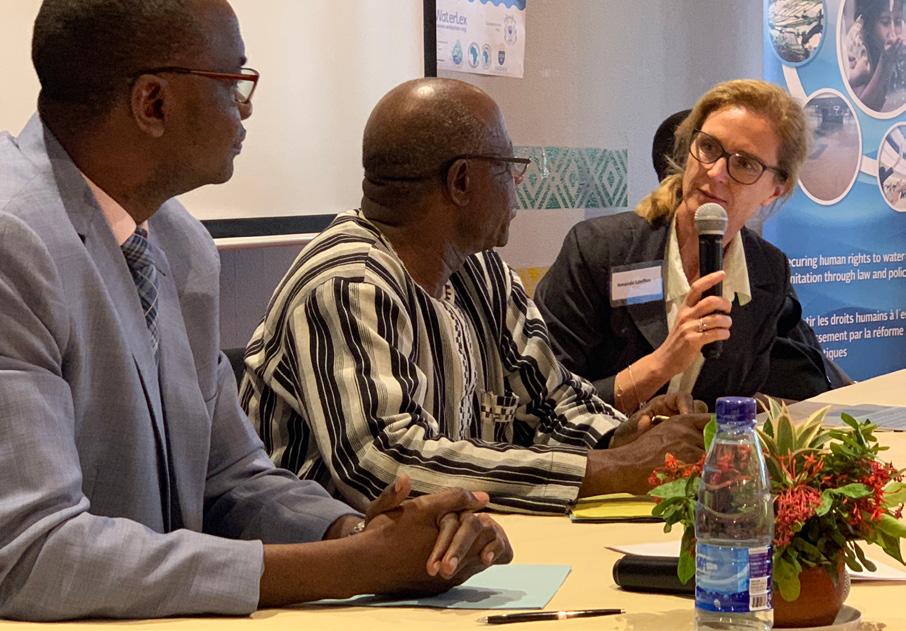
With a clear goal in mind, providing sustainable solutions based on human rights to improve water governance worldwide, Amanda Loeffen is CEO of Human Right 2 Water, a not-for-profit organisation founded after 10 years of legal research into the international laws, standards and norms supporting the human rights to water and sanitation (HRWS). In this exclusive interview, Loeffen shares her vision and how
she and her expert team work to achieve a world where all people realise the human rights to water and sanitation.
Can you tell us briefly about your career path and your role as CEO of Human Right 2 Water?
I spent the first half of my career working in a variety of energy and chemical businesses in business development, strategy and management in Europe, North America and Australasia. While in New Zealand, I moved into another resource, water where I founded a project management company in water infrastructure development, mostly working on community projects to develop water storage for irrigation. Since moving back to Europe, I have led non-governmental organisations working on water governance to pro -
vide access to water and sanitation for vulnerable people.
Human Right 2 Water works towards safeguarding the human rights to water and sanitation. Can you explain your organisation’s step-by-step guide to helping achieve this goal?
The key is in applying a human rightsbased approach. We start with a situation analysis, including a structured analysis of the current law and policy and how it integrates human rights to water and sanitation. Armed with this information, we then engage with local stakeholders, including vulnerable groups and local authorities, to understand their challenges and needs. Our goal is to understand the root causes of the problems with access to water and sanitation, such that we can design a set of human rights-based
“The
"Our goal is to understand the causes of the problems with access to water and sanitation to design a set of human rights-based indicators"Amanda interviewing the Minister of Water and Sanitation in Burkina Faso.

indicators that can be monitored. The capture and monitoring of rights-sensitive data provides an understanding of the areas for investment and a pathway for local authorities to follow.
With the growing effects of climate change, do you find that governments and local authorities are paying more attention to water and sanitation issues?
Sadly, water and sanitation are areas that are easily overlooked, because they are
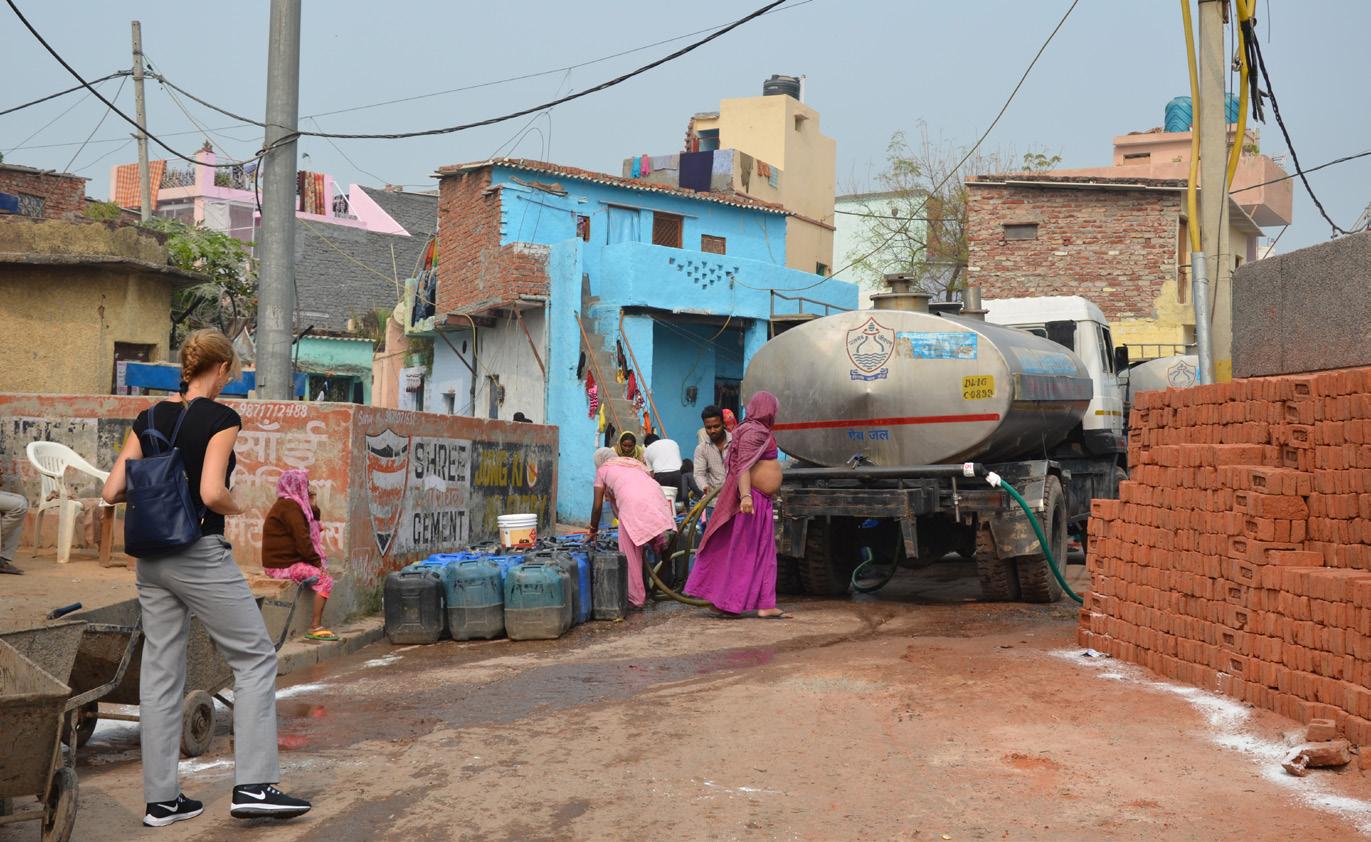
difficult to solve, take a long time to fully resolve, and therefore are politically unsatisfying. However, with the increasing political commitment to climate adaptation and mitigation, and the stress on water systems, governments are starting to recognise the value of investing in more sustainable systems.
How important are water governance and policy in achieving sustainable water management practices, and what steps can governments take to improve water governance?
Water governance and policy are incredibly important, as it provides the backbone for long-term changes in behaviour that are based on recognised standards and norms. The first step that governments can take is to check how they have integrated international human rights law into their constitutional laws and policies. With this baseline of informa-
tion, it is then relatively easy to see where the gaps are, and to start making plans to fill them. For example, ensuring that all people have access to a minimum volume of good quality water a day is more than an aspiration, and it can only be achieved by a set of laws and policies that are designed to make this happen.
Developing countries face the greatest risk from climate change. How can we convince the international community to do more in terms of providing financial support and helping develop institutional capacity?
It is clear that the differential between developed and developing countries is marked not only in the GDP but also in the carbon footprint per head. If we as a global community want to support the least developed countries to take a low carbon path to help achieve global reductions in greenhouse gas then we cannot
"The capture and monitoring of rights-sensitive data provides an understanding of the areas for investment and a pathway for authorities"Amanda Loeffen in Delhi, India.
ignore them. In my opinion, we need to share knowledge and skills in a way that will support developing nations to jump the technology gap. It is going to take more than one solution to get there, but it should be a shared responsibility.
What are some of the most innovative approaches you have seen for improving access to clean water and sanitation for marginalised communities?
Innovation can take many forms, ranging from the process of deciding on the right solution, including the participation of the local community, to the choice of solution. The most successful choices are the ones that are designed with the participation and engagement of the local community. Ideally, the innovation needs to be designed with local materials and employment where possible, including locally trained operators for maintenance, and at a price that is sustainable. There are so many great solutions out there, but my favourites are the nature-based solutions, incorporating the natural landscape for optimisation of water quality and quantity, such as wetlands or forestland, and using local materials for construction. They generally cost less, can be managed by local communities, and are more sustainable. However, they also take much longer to develop, and for that reason, are more difficult to finance.
HR2W has supported the UNECE programme to encourage sustainable development through the People-first PPP programme. Can you tell us a bit more about this initiative?
The UNECE People-first PPP Assessment Tool is designed to provide guidelines for projects on how to be more sustainable, to support as many of the Sustainable Development Goals as possible (SDGs), and to benefit communities and not just the investors in the project. It has been developed by UNECE for PPPs to use in the design, development and operation of projects to provide stan-
dards for reaching the five outcomes of Access and Equity, Economic Effectiveness, Replicability, Environmental Sustainability and Stakeholder Engagement.
In the annual UNECE People first PPP Forum next month, the topic is the Circular Economy, and it will include the showcasing of 48 PPP projects that demonstrate high scores on the assessment tool.
Can you tell us a bit more about the water quality project you are leading with the World Water Quality Alliance?
Human Right 2 Water is partnering with the WWQA to set up local water forums for testing water quality. It is based on citizen science, encouraging local volunteer groups or schools to care about the water quality in their local rivers by taking samples and testing the quality. Some of the apps that we are using are really simple to use and require no cost or specialised equipment. For example, one App, called miniSASS (www.minisass. org) is used to identify the invertebrates that can be found in your river, and then the results are used to determine the water quality. The more sensitive bugs do not live in contaminated waters, and it provides a very simple test and one that helps to create awareness.
The UN 2023 Water Conference took place in March. What do you think of the outcome of this historic event? It certainly has created a huge wave of interest and commitment from organisations and governments globally. The hope has been that there will be some landmark breakthroughs to ensure that everyone has access to safe drinking water and sanitation. Pledges to develop resilient infrastructure, water pipelines, wastewater plants, and early warning schemes for natural disasters have been made, but they need to be supported by legally binding legislation. This hasn’t happened yet, and until it does, there is a risk that this energy and enthusiasm will be undermined. There is still a lot of work to follow up on and make sure that the wave continues.
Sadly, water and sanitation are areas that are easily overlooked, because they are difficult to solve and take a long time to fully resolve
"The differential between developed and developing countries is marked not only in the GDP but also in the carbon footprint per head"
 DEPUTY CHAIRMAN & CEO HASHOO GROUP & CHAIRMAN HASHOO FOUNDATION
DEPUTY CHAIRMAN & CEO HASHOO GROUP & CHAIRMAN HASHOO FOUNDATION
The lack of infrastructure has left a large part of the rural population in Pakistan underwater due to post-catastrophic floods that ravaged the country, in the most unhygienic conditions. The rising death toll due to the floods was followed by waterborne diseases and contaminated water or in some cases complete lack of it. Despite relief funds from some of the world’s richer countries, the long-term and sustainable solution needed to come from within the country. EveryWater, the revolutionary, clean and affordable filtration system provided an instant solution and relief to flood-stricken areas, ensuring the availability of clean drinking water to help prevent water-borne diseases such as cholera in such conditions.
Pakistani innovative startup, EveryWater, was founded by a group of young chemical engineers who developed a water purification solution using a proprietary polymer technology known as “Esoteric Resistive Membrane”, which is also known as intrinsically biofilm resistant membrane and protected by patents in 82 countries worldwide.
purifying 400,000 litres of water from one filter, making it an affordable solution for hundreds of people.
From its humble beginnings in a university dormitory in Pakistan, EveryWater has evolved into an award-winning technology startup. Through a smart, sustainable, and highly efficient filtration technology invented by Shayan Sohail, Arslan Ahmad and Hafiz Usama Tanveer, EveryWater aims to restore the fundamental human right to clean drinking water for everyone, everywhere, every time.
EveryWater pioneered a ground-breaking new filtration technology, an intrinsically antimicrobial membrane ready to provide safe, clean water
EveryWater has pioneered a ground-breaking new filtration technology - an intrinsically anti-microbial membrane ready to provide safe, clean water through a range of household and industrial products.
Created using innovative ERM technology, thousands of intrinsically anti-microbial hollow fiber membranes work together to make one highly effective filter that delivers clean drinking water. Each hollow fiber membrane is intrinsically anti-microbial, meaning every part of it is made to fight harmful bacteria. Finely controlled pore sizes ensure contaminants stand no chance, with 99.9999% of them blocked from going any further.
With this revolutionary ERM technology, the build-up of any bio-film is prevented, ensuring the filter's effectiveness and fast flow rate is maintained. This results in clean and safe water, delivered quickly, easily and efficiently. It is capable of
When these three young scientists pitched their ground-breaking solution to the Hashoo Foundation, an impact investing and philanthropic arm of Hashoo Group, things started moving quickly. The team then engaged an Austrian company to facilitate the engineering design based out of Singapore, where the idea was incubated at the university and with access to the latest technology and machinery from Korea. This is where EveryWater finally developed its invention into a feasible product that had the potential to change the world.
EveryWater offers a portable, cost-effective, off-grid filter that can clean 10,000 liters of water from all water-borne bacteria, viruses and contaminants. It can be attached to a faucet or a bucket, it’s as simple as that. This technology has ensured clean water to people across Pakistan, India, Africa, and South America during water-borne epidemics and disasters.
The project has won numerous awards for its innovative and affordable technology including; Winner of Young Water Fellowship, Young Water Solutions; Winner of Commonwealth Awards for innovative projects delivering sustainable development in the winner's countries, 2020; National Award for the Most Innovative Technology of the Year, Pakistan, among others.
Held at the end of March, the UN 2023 Water Conference was the first conference dedicated entirely to the water sector since 1977. The event brought together around 10,000 participants to discuss the water crisis and set actions to accelerate achieving the Sustainable Development Goal 6 – on Clean Water and Sanitation.
Z Olivia TempestNathalie Olijslager- Jaarsma has over 25 years of experience working for the government of the Netherlands and is an expert in Sustainable Economic Development, Economic Cooperation, and International Business. Passionate about water, she accepted the role of Program Director for the 2023 UN Water Conference, and now, in the wake of this historic event, we had the chance to speak with Nathalie about the outcome of the Conference and her expectations for the future.
Can you tell us briefly about your career path and your role as Program Director of the 2023 UN Water Conference?
I started my career in 1995, having graduated in international economic relations. My postings, as a diplomat, were in South Africa, Hungary, United States and to the UN and other specialized international organisations in Geneva. In
between my postings, I worked at the Ministry of Foreign Affairs and of Economic Affairs in the Hague.
The three common threads in my positions are:
J content: sustainability
J process: change/transition (management)
J aim: innovate by bringing more (people, topics) to the table to learn from each other and create novel solutions and positive power to influence.
My role as Program Director of the UN-Water Conference was to lead the team(s) to create content on the sustainability of water (for our lives and livelihoods), to think about how to create a movement for change and have people feel comfortable enough in uncharted territory and create coalitions for commitments/programmes in the Water Action Agenda. I was also constantly trying to identify risks and mitigate those.
What were your expectations for this historic event? Are you satisfied with the outcome?
Our hope and aim were to create a historic event for the reason of the change that is needed to address the water challenges of the world and prevent the next crisis. My fear was that the Conference was going to be “just another conference”, or
historic for the wrong reasons (political turmoil, stalemate etc.). I am very satisfied with the outcome, as we were able to reach many different people with our messages, also via (social) media as well as we were able to create a positive spirit of “can do” with a very filled water action agenda (719 commitments was a lot more than I thought we could generate).
A number of water experts expressed regret over the lack of binding agreements made at the Conference, saying these fail to secure the resilient and sustainable water future needed. What is your opinion? Considering the limitations we were facing in organising the UN-Water Conference, as placed upon us by a negotiated UN resolution which prohibited a negotiated outcome of the conference, I think we were able to push the boundaries as far as we could, with keeping all the member states on board. The adoption of the Water Action Agenda was a breakthrough. The resolution had not called for it, we created it and because of it being adopted, it exists now. I do agree with the regret expressed that we were limited in what we were allowed to organise and realise, also I acknowledge that the UN does not have the power to make countries adhere to what they have promised. But this cannot be attributed to the UN, because the UN is all of us, all the countries together and if we promise to do something about a worldwide problem, we should deliver ourselves, for ourselves, for each other and most of all for future generations.
"Our aim was to create a historic event for the change needed to address the water challenges of the world and prevent the next crisis"
“The
We cannot make them responsible for cleaning up our mess.
Before the 2023 UN Water Conference, the last UN event focused on water took place in 1977. Do you think water has enough visibility in the political and social spheres?
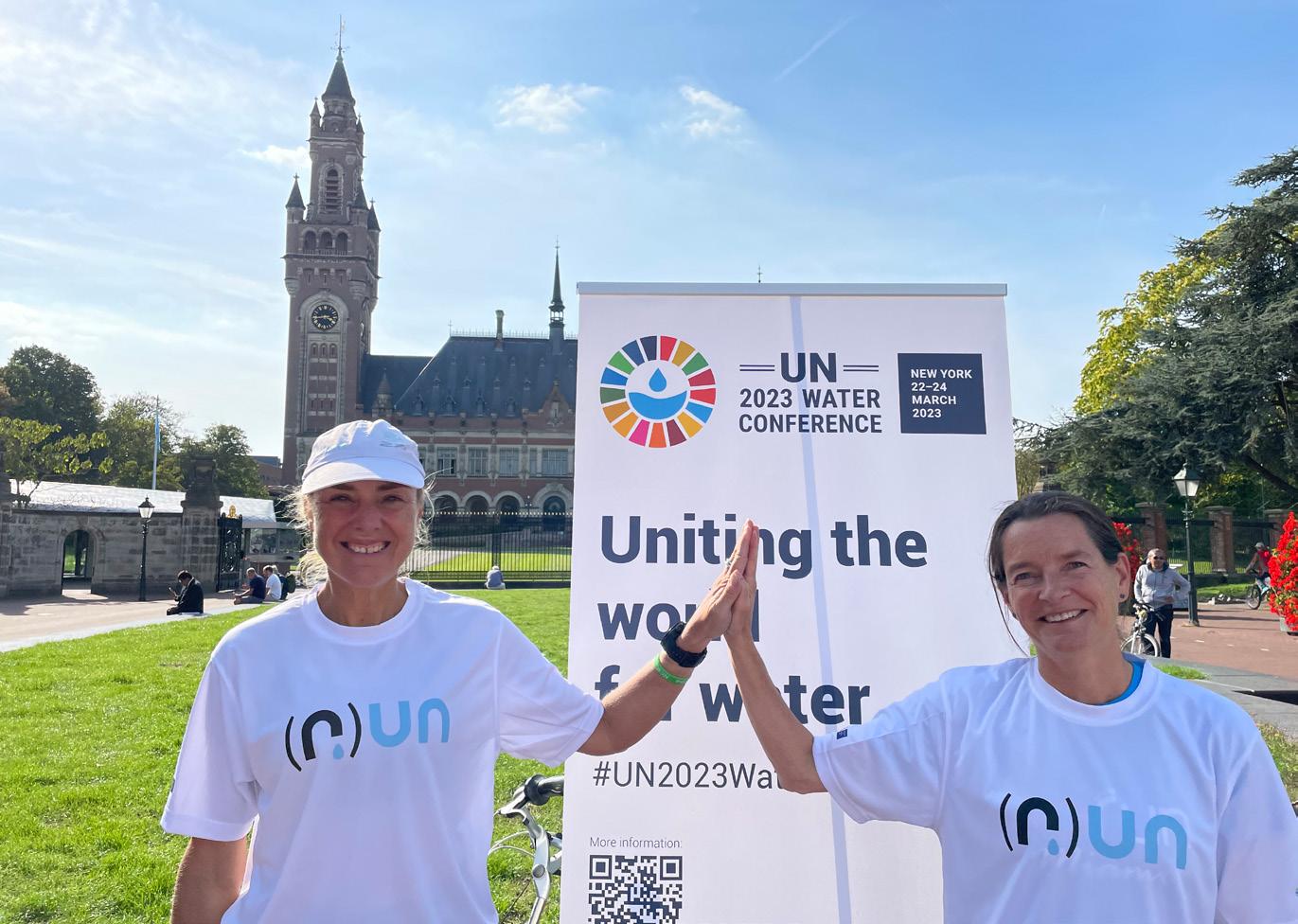
This is an interesting question. I have often wondered why it was not discussed for 46 years; would it have been too political? Were we taking water too much for granted? Why do we discuss food security and energy security, or security at large, while not discussing water security? Why do we discuss (climate) crises, and migration while not discussing drought/water? I think water should be an explicit topic in all these discussions. I am not sure if that goal is going to be
achieved by separate water conferences, or by making sure water is on the agenda of all the other conferences on food and climate, etc. I tend to think the latter is more useful.
How did the UN Water Conference highlight the urgent topic of groundwater and transboundary cooperation? The topic of transboundary cooperation was highlighted specifically and explicitly in the Interactive Dialogue, number 4, chaired by Senegal and Switzerland which both have a strong track record of how to manage water with the neighbouring countries in a trust-building way, mitigating conflict and crises.
The topic of groundwater got attention, but what I missed was the combination of the human right to water and sanita-
tion (access for all) with the knowledge of how we currently are depleting our groundwater resources with our (over) consumption and production. To give an example; there are maps available which show you in which regions of the world people still need to get access to drinking water and sanitation. There are also maps available of which regions of the world are “drying up” in this decade; hence will not
"Considering the limitations we were facing in organising the Conference, I think we were able to push the boundaries as far as we could"
have any groundwater left by 2030. Some regions are in the worse category of both kinds of maps and so their water challenges should be addressed in full understanding of the water situation. To give people drinking water and sanitation, wastewater needs to be recycled, less water needs to be used in agriculture, and infrastructure to keep rainwater and floods when they occur should be installed to help fill up the aquifers.
In the world’s aim to achieve a low-carbon economy, water is often forgotten. How did the UN Water Conference shed a light on this issue? Water is indeed forgotten when it comes to its significant role to also capture CO2, as wetlands do. Also, wastewater treatment plants can be built to create energy instead of costing energy. In the discussions and negotiations on climate change, water is usually only
addressed in the context of adaptation. Of course, it is especially important to build infrastructure and build with nature (use the natural power of nature) to protect against floods and droughts, but it is also important to invest in the mitigation possibility of water. If countries invest in lowering the risks of disasters, they invest in preventing loss and damage, so good disaster risk reduction policies, plans and investments create less loss of lives and livelihoods, and less damage. I think this is a particularly important notion for the discussions on loss and damage because we all have a responsibility in investing in the reduction of risks. And we cannot engineer our way out of these crises, we must understand the force of nature, and how the water cycle works, we must use indigenous knowledge and experience and create local, logical, affordable solutions to reduce the risks of floods and droughts.
In closing the summit, António Guterres, secretary-general of the UN, urged the pledges made at the Conference to be turned into action. What do you think the next steps should be? My very opinion is that the platform “UN Water” should be strengthened by the organisations which are a member. UN Water encompasses all the big UN
and other relevant organisations, but they are not given the mandate nor the power nor the influence to coordinate water action across the system, to share knowledge so that others also can make use of it, to warn or alert the highest international level when necessary. I think there is more competition than cooperation in the system and therefore UN Water cannot function as well as it should.
What role did women play in the UN 2023 Water Conference? And how can we achieve gender equality in water, sanitation, and hygiene?
I think we have tried to give a good example by having Ms Evelyn Wever-Croes, Prime Minister of Aruba, as our head of delegation after our King left. She was also an ex-officio and hence chairing the general assembly at certain agenda items. With her, we tried to emphasise both the importance of women as leaders, as well as the specific challenges of island states. I saw many women in the special events, in which indigenous, NGOs and other civil society groups were given a voice, but I have to admit that women were underrepresented when it came to the heads of delegation, the CEOs in the private sector, both in business as in financing. We can only achieve gender equality when there is an even distribution and execution of power amongst the different genders.
Having also worked in the private water sector, do you think businesses should do more to tackle their water-related challenges encompassed within SDG 6? Do you have any advice to offer?
If businesses do not go circular, they will eventually be out of business and that might happen sooner than they think. If a company is pumping up all the groundwater in a specific region for its production process, without making sure that the groundwater is filled up again, the people in that region will want to sue the company, boycott their products and in the long run others might follow suit. If too
UN Water encompasses the big UN and relevant organisations, but they are not given the power to coordinate water action across the system
"My advice to the private sector is to step it up and bring the discussion of water security to the boardroom: invest in water"
many watersheds will lose their natural water and become “desert-like”, companies cannot find places to relocate to and products might become very expensive or unavailable. My advice to the private sector, therefore, is to step it up and bring the discussion on water security to the boardroom; invest in water and technologies to make the production process circular and keep the water that is discharged clean and reusable. If the companies can invest in the energy transition, they should be able to invest in the water transition.

The water sector needs to attract young talent. How can we engage with the younger generations to consider jobs in this sector?
I honestly do not understand why young people would not want to have a job in the water sector. They care about their future; they care about the planet on which we live; they will have no future nor a planet without water. So, water expertise is needed in banks and financial institutions, in companies, in governments and in households, as well as in the media,
advertising, the analysis of data, fashion etc. There are no jobs without an understanding of water.
"Water expertise is needed in banks and financial institutions, in companies, in governments and households, as well as in the media"
The UN 2023 Water Conference gathered 10,000 participants from different sectors to address the water crisis and concluded with a commitment from governments, businesses, and civil society to tackle the global water crisis.
Global progress on water and sanitation faces many challenges. The UN 2023 Water Conference, held from 22 to 24 March in New York, presented itself as a unique opportunity to accelerate water action and achieve Sustainable Development Goal 6, clean water and sanitation for all.
The key outcome of the Conference is the Water Action Agenda, capturing over 700 voluntary commitments aimed at driving transformation from a global water crisis to a water-secure world. Member States and multilateral institutions announced investments in water and sanitation infrastructure and services, domestically and to help other countries. Several countries stepped up their commitment to transboundary water cooperation; confirming their intention to join the UN Water Convention, in what could be major progress to advance cross-border water cooperation, prevent conflict and build resilience. Private sector and non-profit organisations also pledged dedicated investments, such as to extend the impact of WASH services work, and for water innovation, including the commercialisation of innovative water management approaches and the deployment of new water technologies.
The overall financial impact of commitments made at the Conference amounted
The key outcome of the Conference is the Water Action Agenda, capturing over 700 voluntary commitments aimed at driving transformation
Z Cristina Novo Pérezto USD 300 billion, according to the closing remarks of Csaba Kőrösi, President of the 77th session of the General Assembly. But while the pledges and commitments are a major inspiration, some voices have pointed out that many are small-scale, lack clear financing models, or do not contain quantifiable targets. Moreover, some are already ongoing initiatives repackaged for the occasion, which at least might receive a new impetus.
There are different views on whether a focus on voluntary commitments is the best way to make progress on water and sanitation. Accountability is a main concern, as the commitments are voluntary. The Conference focused on action, not on negotiation, but would it have been better to negotiate and try to come up with a political declaration? Such a declaration would hold governments accountable, but the tensions associated with a negotiated approach might have gotten in the way of open and constructive discussions. Csaba Kőrösi argued that although the outcome of this conference is not a legally binding document, it still turns a page of history. Whether the Conference will achieve its aim of catalysing progress on water and sanitation will be seen in the future, and clearly this event is part of an ongoing journey. The truth is the success of the conference can also be considered in terms of visibility and political momentum, of new ideas and partnerships: creating opportunities that are hard to quantify.
Momentum is not easy to measure, but nonetheless important. In the words of Kelly Parsons, CEO of WaterAid America, “We collectively heard the voices of Indigenous leaders, of women, of those
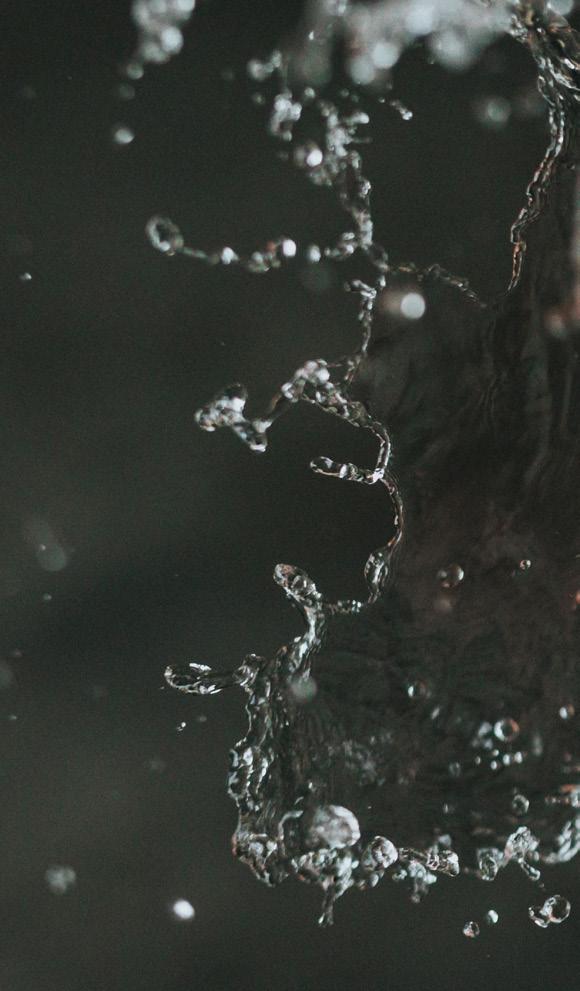
who are on the front lines of the water crisis. They are calling us to action. There is momentum, but it must be harnessed to reach the billions of people living without clean water, decent toilets and hygiene. We don’t have a moment to lose.”
Rich Thorsten, Chief Insights Officer of Water.org welcomed the Conference as “a step in the right direction for global leaders to recommit to universal, sustainable water and sanitation”, but pointed to the tremendous task ahead now: “we must now translate those commitments into tangible investments and quick action to get back on course to achieve SDG6 by 2030”.
Barbara Schreiner, Executive Director of the Water Integrity Network, also deemed the Conference “a momentous opportunity”, but fears “it did not go far enough to address the global water and sanitation crisis with the seriousness it deserves”, pointing to the lack of meaningful accountability or binding outcomes. Together with colleagues from other organisations, they addressed an open letter of concern to the UN Secretary-General: “We believe the 700 voluntary commitments risk fragmentation and disjointed delivery. The absence of a systematic review of the evidence means we risk for-
getting the lessons and repeating the mistakes of the past. The lack of balanced participation silences those most affected, and leaves the agenda open to undue influence by powerful beneficiaries of the status quo”. In fact, the most vulnerable, who lack access to human rights to water and sanitation, were not even aware that the Conference was taking place.
“Water is a team sport”
Those were the words of Jim Andrew, Executive Vice President and Chief Sustainability Officer for PepsiCo, during a post-conference session by the World Eco-
nomic Forum (WEF), “Beyond the UN Water Conference - Leaders on What’s Next”, but it is a recurring message: water is everyone’s business, and collective action is needed to overcome the water crisis.
That means sectors of society coming together to accelerate action towards achieving SDG 6 and respond to the water crisis. Every actor has a role to play, and the private sector is key to shaping a future that is water resilient. Very much present at the Conference, businesses are already taking action to become better stewards of water resources, taking into consideration their own companies as well as the water footprint across their supply chain.
Al Cho, Senior Vice President and Chief Strategy and External Affairs Officer at Xylem, highlighted the Conference’s emphasis on diverse partnerships: “What the summit got right was to create space for countless constructive collisions between stakeholders with diverse capabilities and interests. My hope is that these encounters will unlock the tremendous potential energy that stems from juxtaposing stakeholders who never interact in the conduct of daily business, but probably should”.
He calls for “a multi-stakeholder approach to fast-track deployment of technology to address the world’s big water challenges”, noting that no single player can make that happen: “We need the private sector, government, development agencies and multi-laterals to get better at working the problem together”.
The links between water and climate change, food, energy and biodiversity are more evident than ever, and the focus on water needs to change from fragmented and reactive to much more connected and proactive. That means collaboration between governments, non-profit orga-

nizations, and the private sector, but also working together across sectors.
The nexus with agriculture is a very obvious one, as the major water use across the globe. At a high-level dialogue on the last day of the Conference, the Director-General of the FAO QU Dongyu emphasized the need for all sectors to work together “to co-create, co-design and co-advocate solutions”. According to the FAO, water enables the production of over 95 per cent of the food on land; however, by 2050, to meet future demand, the global production of food, fibre and feed will need to increase by 50 per cent compared to 2012. They estimate that to meet that goal, 35 per cent of additional water resources are needed.
To meet the challenges ahead, the Global Commission on the Economics of Water has proposed a path to transform the economics and restructure the governance of water. Their strategy includes points such as addressing the under-pricing of water, phasing out some of the agriculture and water subsidies which promote excessive water consumption, and investing in innovation to extend the reach of scarce water resources.
Another nexus that cannot be overstated is that between water and climate. While the role of water in tackling climate change may not have been widely recognised, that may be changing, with
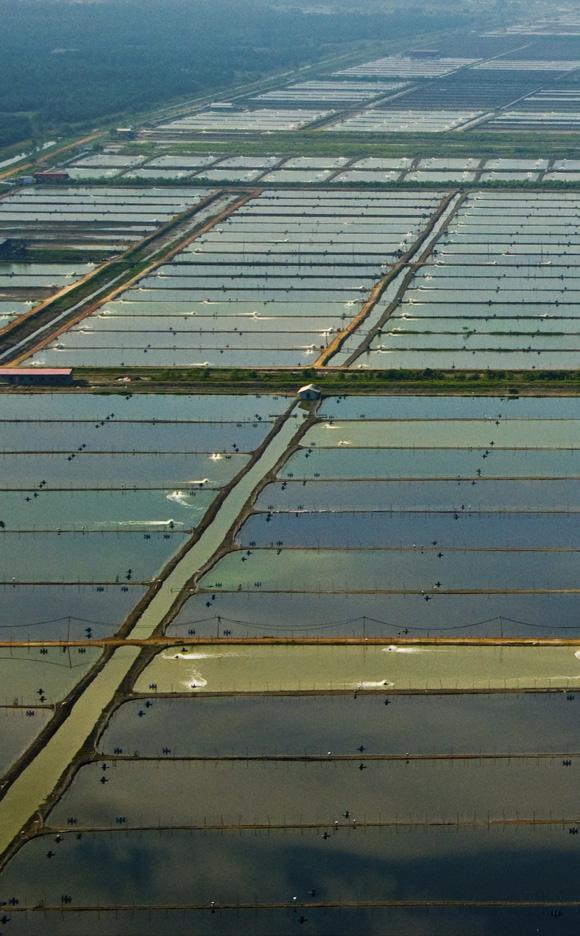
water becoming increasingly part of adaptation and mitigation discussions.
We feel the water crisis locally, in our rivers, in our groundwater, but although it needs to be regarded as a national concern, the water cycle does not know about political boundaries, so water resources have to be considered at the global level, similarly to climate mitigation or biodiversity. As a global common good, water resource management must be resilient and compatible with a changing climate. Experts stress the need to manage water and climate in tandem to protect water resources, reduce disaster risks, reduce greenhouse-gas emissions, and ensure equitable access.
In this regard, not only is adaptation important, but also mitigation from water – the contribution of the water sector to emissions. Also, as water and climate policy become better integrated in the future, it is vital to revisit the role of adaptation versus mitigation, as the first one only received about 10% of the total climate finance, even though they are both equally urgent and important.
In terms of follow-up, the conference outcomes will receive concrete follow-up in three key upcoming summits: the SDG Summit during the UN General Assembly in September 2023, the Summit of the Future in 2024, and the World
Social Summit in 2025, and through other United Nations processes. It is hoped that, after this conference, water will be given more prominence within the UN system, and be addressed as a crosscutting issue in the UN agenda. To help in this regard, and as a specific outcome called for at the Conference, the UN is considering the appointment of a UN Special Envoy for Water, to help coordinate action across the UN architecture and catalyse multilateral progress.
Nathalie Olijslager Jaarsma, the Conference Program Director, spoke to Smart Water Magazine – you can read the full interview in this issue – and reflected on the visibility of water in global discussions, such as those focusing on climate or migration: “I think water should be an explicit topic in all these discussions. I am not sure if that goal is going to be achieved by sep-
Whether the Water Conference will achieve its aim of catalysing progress on water and sanitation will be seen in
arate water conferences, or by making sure water is on the agenda of all the other conferences on food and climate, etc. I tend to think the latter is more useful”.
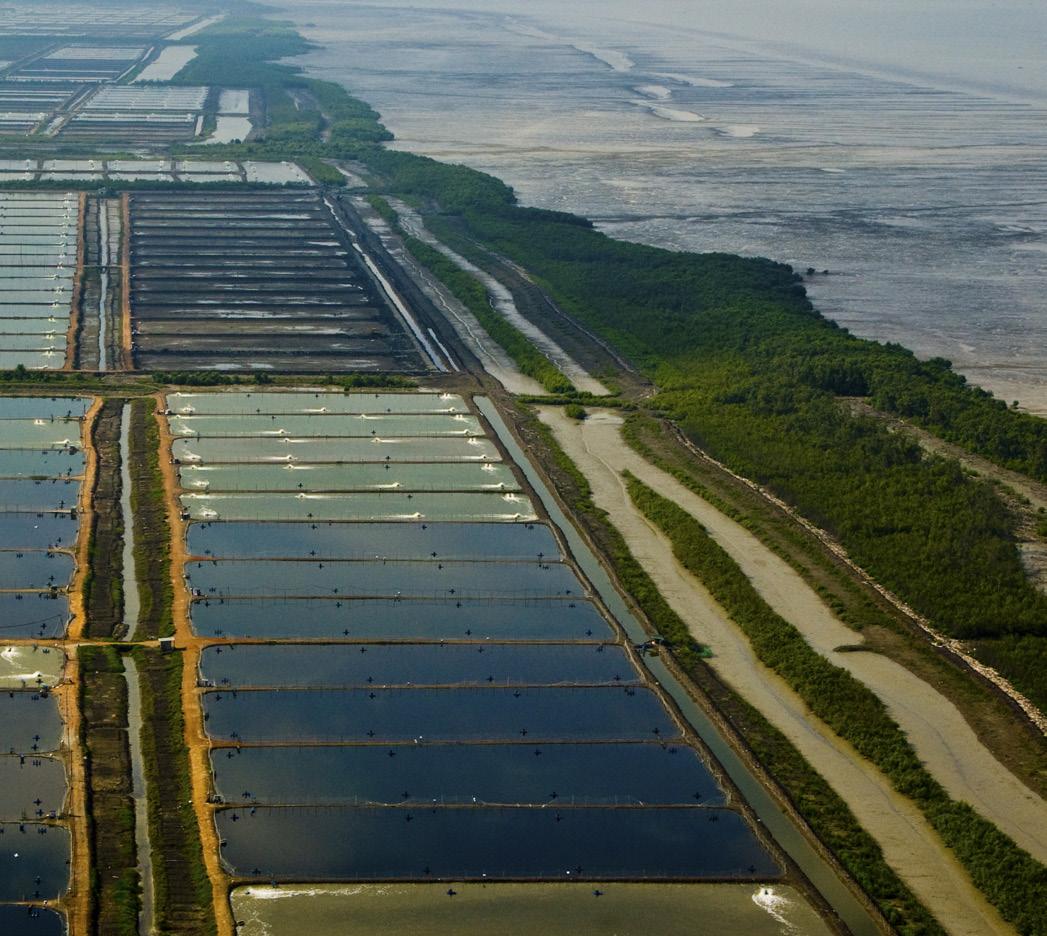
Scaling down from the UN, we can remind ourselves that the UN is only as strong as its members, and focus on maybe the most important actors when it comes to achieving SDG 6: national governments. In this regard, Lesley Pories, Coordinator of the Global Water Leadership Programme (GWP), noted the appropriateness of having an event at the UN-level: “The UN Water Conference was effective in getting many ministers from across the water sector to attend and engage, which was a notable and welcome difference from other key events where the water sector comes together”; however, in her view, those ministers in charge of water themselves “are not the most im-
portant actors we need to engage as a water community to propel transformation in how water is valued and subsequently managed at the country level”, and she affirmed “these conversations marked, at least for me, a turning point in who the community focuses its advocacy upon“, claiming advocacy needs to aim a bit higher, at the Heads of State.
Catarina Fonseca, Economist, IRC Associate, and Founder of Pulsing Tide, also pointed to the role of Heads of State: “The commitments done by Heads of State were underwhelming. There were actually very few Heads of State present. Why would their commitments be important? Because much of the issues in the sector are multisectoral and complex in nature and won’t be solved by Ministries of Water or Ministries of Finance alone, they require a much longer-term vision and drive”.
Ultimately, we come back to the same lesson: we are all in this together, and it is paramount to join efforts to reach the millions of people who cannot currently exercise the human rights to water and sanitation. Josien Sluijs, Managing Director at Aqua for All, highlighted the need to bring public and private efforts together to bridge the financing gap for water and sanitation action. “The UN 2023 Water Conference was the ultimate stage for showcasing how blended finance effectively mobilises private capital for water”, she noted, citing for instance how “together with the government of Kenya we stressed the importance of joint efforts; the financing gap for their country policy is huge and the private sector is able to complement their public efforts. I witnessed a growing acknowledgement of and support for the private sector to play their part”. And she is optimistic about the future: “We will continue to pave the way to unlock private capital and facilitate private actors to complement public efforts. I am confident that the #WaterActions as presented at the UN Water Conference will accelerate universal access to water.”
After this milestone event, the journey continues towards a future with clean water and sanitation for all. Monitoring progress on the commitments will be crucial, but, as Henk Ovink, the Special Envoy for Water for the Kingdom of the Netherlands, noted at the WEF post-conference session, it is not just important to deliver on them, but to capitalise on them, taking advantage of the opportunities to replicate and scale across the world.
The UN is considering the appointment of a Special Envoy for Water, to help coordinate action across the UN architecture
An ambitious programme will work towards water security and achieving Sustainable Development Goal 6, clean water and sanitation
On the occasion of the UN 2023 Water Conference, Minister of Jal Shakti Gajendra Singh Shekhawat announced that India plans to invest more than US$240 billion in the country’s water sector. It is also implementing the world's largest dam rehabilitation program coupled with efforts to restore groundwater levels.
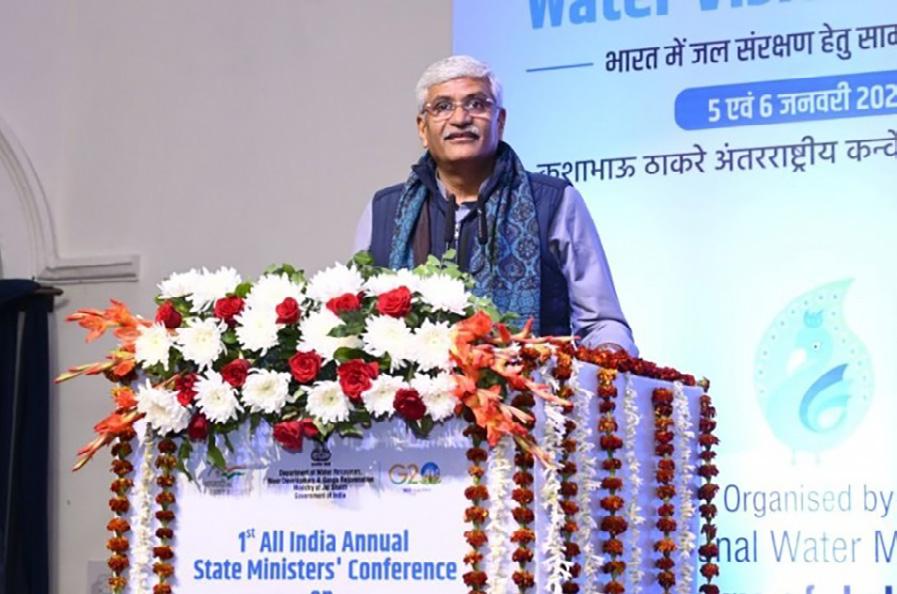
“We have committed investments of more than 240 billion dollars in the water sector through government resources, in partnership with private innovators, start-ups, and water-user associations. India is implementing two flagship missions to ensure universal access to sanitation and drinking water,” Shekhawat said, delivering the national statement in the UN General Assembly.
“We are making efforts to restore groundwater level and create mindful
communities by combining demand and supply side interventions through village Water Security Plans, inculcating behavioural changes on water usage and conservation at the grass-root level, financing these plans through incentives and convergence of existing programmes,” he added.
India is the largest user of groundwater globally. In 2019, India launched its landmark groundwater program, the Atal Bhujal Yojna, to halt this precipitous decline. Also in 2019, India was declared open defection free. In this regard, Shekhawat said: “In our journey to achieve SDG 6.2, since 2014 we have built over 105 million toilets, and transformed sanitation habits through massscale behaviour change of more than 600 million Indians.”
The private sector pledges are included in the Water Action Agenda
Seventeen organizations have joined forces to support the United Nations (UN) Water Action Agenda, pledging to invest $11 billion in water innovation over the next five years. The pledges will be included in the Water Action Agenda, a collection of all water-related commitments to accelerate progress on UN Sustainable Development Goal 6 targeting Water and Sanitation.
The funds will be directed toward water-related research and development, start-up companies commercializing innovative approaches to water management, and the deployment of new water technologies. The organizations will also commit to ongoing engagement with development agencies, governments, and other stakeholders to facilitate more cross-sector action to solve water challenges.
The commitment from the private and philanthropic sectors to invest in water solutions supports the UN 2023 Water Conference’s call for clear pledges and actions, across all sectors, industries, and interests to achieve the UN Sustainable Development Goals.
The inclusion of the private sector in the UN 2023 Water Conference, the first event of its kind since 1977, has been welcomed as essential in developing an impactful Water Action Agenda.
Organizations contributing to the pledge include Acciona, Autodesk, BlueTech, Burnt Island Ventures, The Coca-Cola Foundation, Evoqua, Grundfos, Hansgrohe, Hydraloop, Idexx, UGSI Solutions, Veolia, Water Foundry Ventures, Wavin, Westly Group, XPV and Xylem.

The problem statement for water is clear: we are way off where we need to be to achieve SDG 6. There is more than enough water in principle, but water security remains out of reach for billions of people. The technologies exist to make water and sanitation more accessible and affordable for all, but these innovations can only solve problems if they get funded and deployed. This tension between the reality that we could solve global water challenges, but haven’t yet, animates much of the policy conversation on water.
This UN Water Conference – the first in over 40 years – was a much-needed moment of stock-taking on where we stand in achieving the Sustainable Development Goals. After three long years of a global pandemic, the event unlocked tremendous energy in throngs of participants scrambling into tiny basement conference rooms at the UN. The Conference co-hosts, the Governments of the Netherlands and Tajikistan, and particularly Henk Ovink, Water Envoy of the Kingdom of the Netherlands, deserve our collective gratitude for making it happen. But now that we have returned home, what lasting impact can we expect, if any?
If there is one theme from the event that gives me both hope and trepidation, it is the emphasis on diverse partnerships. The summit attracted thousands of participants from governments, non-profit organizations, and the private sector. What the summit got right was to create space for countless constructive collisions between stakeholders with diverse capabilities and interests. My hope is that these encounters will unlock the tremendous potential energy that stems from juxtaposing stakeholders who rarely interact, but probably should. If the discussions I witnessed are any indication, the UN Water Conference is a cause for optimism.
The other reality is that partnerships and voluntary commitments are typically what governments reach for when there is nothing more binding or ambitious to be had. This conference reminded me of the 2002 World Summit on Sustainable De-
velopment organized in Johannesburg to mark a decade after the historic Rio conference that gave birth to the UN Framework Convention on Climate Change, the Convention on Biological Diversity, and the Convention to Combat Desertification. Ten years on, as interest from governments in focusing on these commitments waned, World Summit organizers focused on making lists of partnerships to advance the cause of sustainability. In the present day, I wonder whether any of these have survived, let alone created a meaningful impact. I hope we do not look back in the same way on this Water Conference.
A multi-stakeholder approach to fast-track deployment of technology to address the world’s big water challenges is essential. No single player can make that happen. We need the private sector, government, development agencies and multi-laterals to get better at working on the problem together. But we also need to stop treating events that happen every four decades as moments that can bend the arc of history. Xylem is ready to do our part by convening a follow-up meeting on World Water Day 2024 at our Reservoir Center to expand on the $11 billion private sector innovation commitment we launched with diverse partners.
The world’s governments can also do more. The UN Framework Convention on Climate Change has created incredible multi-stakeholder momentum around climate change; anyone who has attended a climate Conference of the Parties can sense the stakes in each round of negotiations. Perhaps it’s time to create a similar cadence around water, either by reframing treaty mechanisms such as the Convention to Combat Desertification or creating new vehicles around the broader theme of water security, or at least by establishing a biennial rhythm on SDG 6 through 2030 to drive inter-sectoral alignment. The key is to channel the scattered raindrops of effort across sectors into an unstoppable current, and to turn the moment we had in New York into a momentum that lasts.
A multi-stakeholder approach to fast-track deployment of technology to address the world’s big water challenges is essential
Complementary to the 2nd edition of the textbook Biological Wastewater Treatment: Principles, Modelling and Design, and initiated by IHE Delft Associate Professor of Sanitary Engineering Carlos Lopez Vazquez, who led the editing process, the book expands on the latest advances and developments in wastewater treatment.


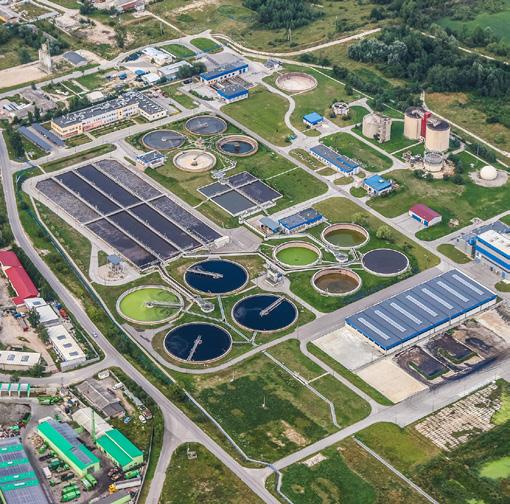
It isn’t the fallout rain
American musician Bob Dylan published this song in his second album The Freewheelin’ Bob Dylan, released in 1963. It illustrates Dylan’s emphasis on weather metaphors and imagery. At the time some suggested the lyrics referred to the Cuban Missile Crisis, to which the Nobel Laureate responded by denying the metaphor.


After three years without rain…
The city of Rome is virtually empty due to the drought and the city's ancient bridges over the Tiber River stretch over dust and rubble once submerged in water. In this dystopian film by Paolo Virzi, a series of characters must cope with dwindling water reserves as well as an epidemic. It had its world premiere at the 79th Venice International Film Festival in September 2022.
